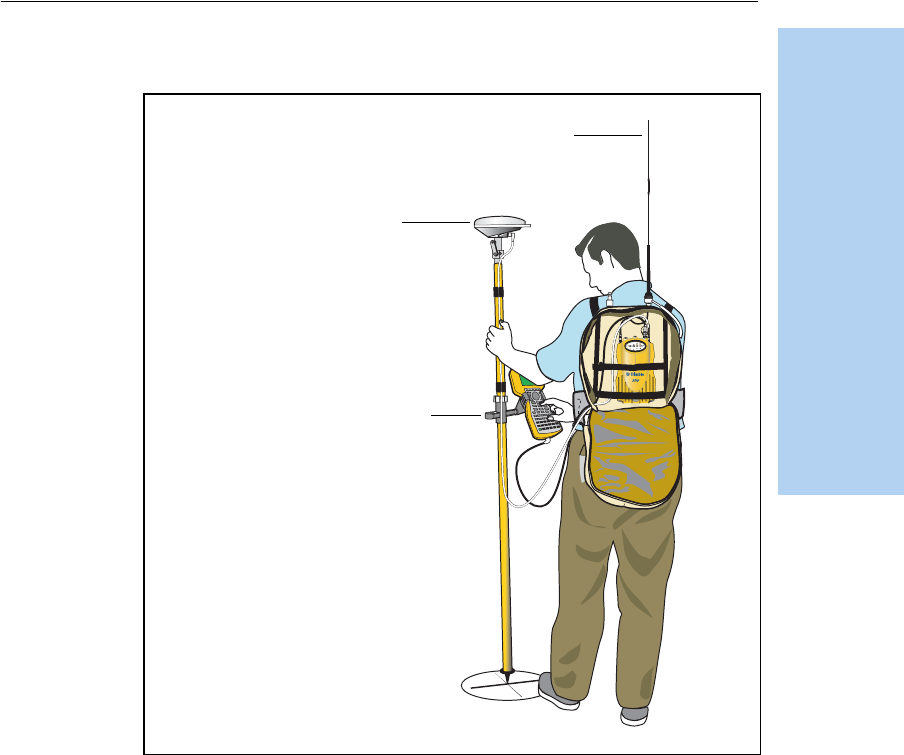Trimble Navigation TNL450I UHF Radio User Manual Trimble R7 R8 GPS Receiver User Guide
Trimble Navigation Ltd UHF Radio Trimble R7 R8 GPS Receiver User Guide
User Manual
Version 2.23
Revision A
April 2005 F
USER GUIDE
Trimble® R7/R8 GPS Receiver
Contact Details
Trimble Navigation Limited
Engineering & Construction Division
5475 Kellenburger Road
Dayton, Ohio 45424-1099
USA
800-538-7800 (toll free in USA)
+1-937-245-5600 Phone
+1-937-233-9004 Fax
www.trimble.com
Copyright and Trademarks
© 2001-2005, Trimble Navigation Limited. All rights reserved.
Trimble, the Globe & Triangle logo, and GPS Total Station are
trademarks of Trimble Navigation Limited, registered in the
United States Patent and Trademark Office and in other
countries. eRTK, Maxwell, Micro-Centred, SiteNet, Trimble
Geomatics Office, Trimble Survey Controller, Trimble Survey
Pro, TRIMMARK, TRIMTALK, TSCe, Zephyr, and Zephyr
Geodetic are trademarks of Trimble Navigation Limited. The
Bluetooth word mark and logos are owned by the Bluetooth
SIG, Inc. and any use of such marks by Trimble Navigation
Limited is under license. Microsoft, Windows, and
Windows NT are either registered trademarks or trademarks
of Microsoft Corporation in the United States and/or other
countries. All other trademarks are the property of their
respective owners.
Release Notice
This is the April 2005 release (Revision A) of the
Trimble R7/R8 GPS Receiver User Guide. It applies to version
2.23 of the Trimble R7/R8 GPS receivers.
The following limited warranties give you specific legal
rights. You may have others, which vary from
state/jurisdiction to state/jurisdiction.
Hardware Limited Warranty
Trimble warrants that this Trimble hardware product (the
“Product”) shall be free from defects in materials and
workmanship and will substantially conform to Trimble’s
applicable published specifications for the Product for a
period of one (1) year, starting from the date of delivery. The
warranty set forth in this paragraph shall not apply to
software/firmware products.
Software and Firmware License, Limited
Warranty
This Trimble software and/or firmware product (the
“Software”) is licensed and not sold. Its use is governed by the
provisions of the applicable End User License Agreement
(“EULA”), if any, included with the Software. In the absence of
a separate EULA included with the Software providing
different limited warranty terms, exclusions, and limitations,
the following terms and conditions shall apply. Trimble
warrants that this Trimble Software product will
substantially conform to Trimble’s applicable published
specifications for the Software for a period of ninety (90)
days, starting from the date of delivery.
Warranty Remedies
Trimble's sole liability and your exclusive remedy under the
warranties set forth above shall be, at Trimble’s option, to
repair or replace any Product or Software that fails to
conform to such warranty (“Nonconforming Product”), or
refund the purchase price paid by you for any such
Nonconforming Product, upon your return of any
Nonconforming Product to Trimble in accordance with
Trimble’s standard return material authorization procedures.
Warranty Exclusions and Disclaimer
These warranties shall be applied only in the event and to the
extent that: (i) the Products and Software are properly and
correctly installed, configured, interfaced, maintained,
stored, and operated in accordance with Trimble’s relevant
operator's manual and specifications, and; (ii) the Products
and Software are not modified or misused. The preceding
warranties shall not apply to, and Trimble shall not be
responsible for defects or performance problems resulting
from (i) the combination or utilization of the Product or
Software with products, information, data, systems or
devices not made, supplied or specified by Trimble; (ii) the
operation of the Product or Software under any specification
other than, or in addition to, Trimble's standard
specifications for its products; (iii) the unauthorized
modification or use of the Product or Software; (iv) damage
caused by accident, lightning or other electrical discharge,
fresh or salt water immersion or spray; or (v) normal wear
and tear on consumable parts (e.g., batteries).
THE WARRANTIES ABOVE STATE TRIMBLE'S ENTIRE
LIABILITY, AND YOUR EXCLUSIVE REMEDIES, RELATING
TO PERFORMANCE OF THE PRODUCTS AND SOFTWARE.
EXCEPT AS OTHERWISE EXPRESSLY PROVIDED HEREIN,
THE PRODUCTS, SOFTWARE, AND ACCOMPANYING
DOCUMENTATION AND MATERIALS ARE PROVIDED “AS-
IS” AND WITHOUT EXPRESS OR IMPLIED WARRANTY OF
ANY KIND BY EITHER TRIMBLE NAVIGATION LIMITED OR
ANYONE WHO HAS BEEN INVOLVED IN ITS CREATION,
PRODUCTION, INSTALLATION, OR DISTRIBUTION,
INCLUDING, BUT NOT LIMITED TO, THE IMPLIED
WARRANTIES OF MERCHANTABILITY AND FITNESS FOR A
PARTICULAR PURPOSE, TITLE, AND NONINFRINGEMENT.
THE STATED EXPRESS WARRANTIES ARE IN LIEU OF ALL
OBLIGATIONS OR LIABILITIES ON THE PART OF TRIMBLE
ARISING OUT OF, OR IN CONNECTION WITH, ANY
PRODUCTS OR SOFTWARE. SOME STATES AND
JURISDICTIONS DO NOT ALLOW LIMITATIONS ON
DURATION OR THE EXCLUSION OF AN IMPLIED
WARRANTY, SO THE ABOVE LIMITATION MAY NOT APPLY
TO YOU.
TRIMBLE NAVIGATION LIMITED IS NOT RESPONSIBLE FOR
THE OPERATION OR FAILURE OF OPERATION OF GPS
SATELLITES OR THE AVAILABILITY OF GPS SATELLITE
SIGNALS.
Limitation of Liability
TRIMBLE’S ENTIRE LIABILITY UNDER ANY PROVISION
HEREIN SHALL BE LIMITED TO THE GREATER OF THE
AMOUNT PAID BY YOU FOR THE PRODUCT OR SOFTWARE
LICENSE OR U.S.$25.00. TO THE MAXIMUM EXTENT
PERMITTED BY APPLICABLE LAW, IN NO EVENT SHALL
TRIMBLE OR ITS SUPPLIERS BE LIABLE FOR ANY INDIRECT,
SPECIAL, INCIDENTAL, OR CONSEQUENTIAL DAMAGES
WHATSOEVER UNDER ANY CIRCUMSTANCE OR LEGAL
THEORY RELATING IN ANY WAY TO THE PRODUCTS,
SOFTWARE, AND ACCOMPANYING DOCUMENTATION
AND MATERIALS, (INCLUDING, WITHOUT LIMITATION,
DAMAGES FOR LOSS OF BUSINESS PROFITS, BUSINESS
INTERRUPTION, LOSS OF BUSINESS INFORMATION, OR
ANY OTHER PECUNIARY LOSS), REGARDLESS OF
WHETHER TRIMBLE HAS BEEN ADVISED OF THE
POSSIBILITY OF ANY SUCH LOSS AND REGARDLESS OF THE
COURSE OF DEALING WHICH DEVELOPS OR HAS
DEVELOPED BETWEEN YOU AND TRIMBLE. BECAUSE
SOME STATES AND JURISDICTIONS DO NOT ALLOW THE
EXCLUSION OR LIMITATION OF LIABILITY FOR
CONSEQUENTIAL OR INCIDENTAL DAMAGES, THE ABOVE
LIMITATION MAY NOT APPLY TO YOU.
Regulations and Safety
The Bluetooth module inside your receiver is a radio-modem
transmitter and receiver.
Regulations regarding the use of the radio-modems vary
greatly from country to country. In some countries, the unit
can be used without obtaining an end-user license. Other
countries require end-user licensing. Consult your local
communications governing agency for licensing information.
Before operating this receiver, determine if authorization or a
license to operate the unit is required in your country. It is
the responsibility of the end user to obtain an operator’s
permit or license for this receiver radio-modem for the
location or country of use.
STATEMENT ACCORDING FCC PART 15.19
This device complies with Part 15 of the FCC Rules.
Operation is subject to the following two conditions: (1) this
device may not cause harmful interference, and (2) this
device must accept any interference received, including
interference that may cause undesired operation.
STATEMENT ACCORDING FCC PART 15.21
Modifications not expressly approved by Trimble could void
the user's authority to operate the equipment.
STATEMENT ACCORDING FCC PART 15.105
This equipment has been tested and found to comply with
the limits for a Class B digital device, pursuant to Part 15 of
the FCC Rules. These limits are designed to provide
reasonable protection against harmful interference in a
residential installation. This equipment generates, uses and
can radiate radio frequency energy and, if not installed and
used in accordance with the instructions, may cause harmful
interference to radio communications. However, there is no
guarantee that interference will not occur in a particular
installation. If this equipment does cause harmful
interference to radio or television reception, which can be
determined by turning the equipment off and on, the user is
encouraged to try to correct the interference by one or more
of the following measures:
– Reorient or relocate the receiving antenna.
– Increase the separation between the equipment and
receiver.
– Connect the equipment into an outlet on a circuit different
from that to which the receiver is connected.
-- Consult the dealer or an experienced radio/TV technician
for help.
Type Approval
Type approval, or acceptance, covers technical parameters of
the equipment related to emissions that can cause
interference. Type approval is granted to the manufacturer of
the transmission equipment, independent from the operation
or licensing of the units. Some countries have unique
technical requirements for operation in particular radio-
modem frequency bands. To comply with those
requirements, Trimble may have modified your equipment
to be granted Type approval. Unauthorized modification of
the units voids the Type approval, the warranty, and the
operational license of the equipment.
Safety
EXPOSURE TO RADIO FREQUENCY RADIATION
You must maintain a minimum separation distance of 20 cm
(approximately 8 in.) between yourself and the radiating
GSM antenna for this device to satisfy the RF Exposure
requirements of the FCC.
For mobile operation, the maximum gain of the GSM
antenna must not exceed 0 dBi.
Trimble R7/R8 GPS Receiver User Guide

Trimble R7/R8 GPS Receiver User Guide v
Safety Information
Before you use the Trimble® R7 or R8 GPS receiver, make sure that you
have read and understood this publication, as well as all safety
requirements.
0.1 Rechargeable Lithium-Ion Batteries
These receivers use a rechargeable Lithium-ion battery.
CWARNING – Do not damage the rechargeable Lithium-ion battery. A
damaged battery can cause an explosion or fire, and can result in
personal injury and/or property damage.
To prevent injury or damage:
– Do not use or charge the battery if it appears to be damaged. Signs of
damage include, but are not limited to, discoloration, warping, and leaking
battery fluid.
– Do not expose the battery to fire, high temperature, or direct sunlight.
– Do not immerse the battery in water.
– Do not use or store the battery inside a vehicle during hot weather.
– Do not drop or puncture the battery.
– Do not open the battery or short-circuit its contacts.

Safety Information
vi Trimble R7/R8 GPS Receiver User Guide
Cappears to be leaking. Battery fluid is corrosive, and contact with it can
result in personal injury and/or property damage.
To prevent injury or damage:
– If the battery leaks, avoid contact with the battery fluid.
– If battery fluid gets into your eyes, immediately rinse your eyes with
clean water and seek medical attention. Do not rub your eyes!
– If battery fluid gets onto your skin or clothing, immediately use clean
water to wash off the battery fluid.
CCharge and use the rechargeable Lithium-ion battery only in
strict accordance with the instructions. Charging or using the battery in
unauthorized equipment can cause an explosion or fire, and can result in
personal injury and/or equipment damage.
To prevent injury or damage:
– Do not charge or use the battery if it appears to be damaged or leaking.
– Charge the Lithium-ion battery only in a Trimble product that is specified
to charge it. Be sure to follow all instructions that are provided with the
battery charger.
– Discontinue charging a battery that gives off extreme heat or a burning
odor.
– Use the battery only in Trimble equipment that is specified to use it.
– Use the battery only for its intended use and according to the
instructions in the product documentation.
Trimble R7/R8 GPS Receiver User Guide vii
Contents
Safety Information . . . . . . . . . . . . . . . . . . . v
Rechargeable Lithium-Ion Batteries . . . . . . . . . . . . . . . . . . . . . . . . . . .v
1 Introduction . . . . . . . . . . . . . . . . . . . . . . . 1
Related Information . . . . . . . . . . . . . . . . . . . . . . . . . . . . . . . . . . . . .1
Warnings and Cautions . . . . . . . . . . . . . . . . . . . . . . . . . . . . . . . . . . .2
Technical Assistance . . . . . . . . . . . . . . . . . . . . . . . . . . . . . . . . . . . . .3
Your Comments . . . . . . . . . . . . . . . . . . . . . . . . . . . . . . . . . . . . . . . .3
Trimble R7 GPS Receiver . . . . . . . . . . . . 5
2 Overview . . . . . . . . . . . . . . . . . . . . . . . . . 7
Features . . . . . . . . . . . . . . . . . . . . . . . . . . . . . . . . . . . . . . . . . . . . .8
Use and Care . . . . . . . . . . . . . . . . . . . . . . . . . . . . . . . . . . . . . . . . . .9
COCOM Limits . . . . . . . . . . . . . . . . . . . . . . . . . . . . . . . . . . . . . . . 10
3 Setting up the Receiver . . . . . . . . . . . . . . . . 11
Parts of the Receiver . . . . . . . . . . . . . . . . . . . . . . . . . . . . . . . . . . . . 12
Front panel. . . . . . . . . . . . . . . . . . . . . . . . . . . . . . . . . . . . . . 12
Rear panel . . . . . . . . . . . . . . . . . . . . . . . . . . . . . . . . . . . . . . 13
Top panel . . . . . . . . . . . . . . . . . . . . . . . . . . . . . . . . . . . . . . . 14
Bottom panel . . . . . . . . . . . . . . . . . . . . . . . . . . . . . . . . . . . . 16
Setup Guidelines . . . . . . . . . . . . . . . . . . . . . . . . . . . . . . . . . . . . . . 18
Environmental conditions . . . . . . . . . . . . . . . . . . . . . . . . . . . . 18
Sources of electrical interference . . . . . . . . . . . . . . . . . . . . . . . . 18
General guidelines . . . . . . . . . . . . . . . . . . . . . . . . . . . . . . . . . 19
Postprocessed Setup . . . . . . . . . . . . . . . . . . . . . . . . . . . . . . . . . . . . 19

Contents
viii Trimble R7/R8 GPS Receiver User Guide
Pole-Mounted Setup . . . . . . . . . . . . . . . . . . . . . . . . . . . . . . . . . . . . 22
Backpack Setup . . . . . . . . . . . . . . . . . . . . . . . . . . . . . . . . . . . . . . . 28
Other System Components . . . . . . . . . . . . . . . . . . . . . . . . . . . . . . . . 30
Radios . . . . . . . . . . . . . . . . . . . . . . . . . . . . . . . . . . . . . . . . . 30
Cellular modems . . . . . . . . . . . . . . . . . . . . . . . . . . . . . . . . . . 33
Antennas . . . . . . . . . . . . . . . . . . . . . . . . . . . . . . . . . . . . . . . 34
CompactFlash cards . . . . . . . . . . . . . . . . . . . . . . . . . . . . . . . . 36
4 General Operation . . . . . . . . . . . . . . . . . . . 37
Button Functions . . . . . . . . . . . . . . . . . . . . . . . . . . . . . . . . . . . . . . 38
LED Behavior . . . . . . . . . . . . . . . . . . . . . . . . . . . . . . . . . . . . . . . . 39
Logging/Memory LED. . . . . . . . . . . . . . . . . . . . . . . . . . . . . . . 40
SV Tracking LED . . . . . . . . . . . . . . . . . . . . . . . . . . . . . . . . . . 40
Radio LED . . . . . . . . . . . . . . . . . . . . . . . . . . . . . . . . . . . . . . 40
Battery 1 LED and Battery 2 LED . . . . . . . . . . . . . . . . . . . . . . . . 41
Starting and Stopping the Receiver . . . . . . . . . . . . . . . . . . . . . . . . . . . 41
Logging Data . . . . . . . . . . . . . . . . . . . . . . . . . . . . . . . . . . . . . . . . . 41
Logging internally . . . . . . . . . . . . . . . . . . . . . . . . . . . . . . . . . 42
Logging to a Trimble controller . . . . . . . . . . . . . . . . . . . . . . . . . 43
Resetting to Defaults . . . . . . . . . . . . . . . . . . . . . . . . . . . . . . . . . . . . 43
Formatting a CompactFlash Card. . . . . . . . . . . . . . . . . . . . . . . . . . . . 44
Batteries and Power . . . . . . . . . . . . . . . . . . . . . . . . . . . . . . . . . . . . 44
Battery charging and storage . . . . . . . . . . . . . . . . . . . . . . . . . . 47
Operating with the TSCe controller . . . . . . . . . . . . . . . . . . . . . . 48
Power output . . . . . . . . . . . . . . . . . . . . . . . . . . . . . . . . . . . . 49
Firmware . . . . . . . . . . . . . . . . . . . . . . . . . . . . . . . . . . . . . . . 50
5 Configuration . . . . . . . . . . . . . . . . . . . . . 51
Configuring the Receiver in Real Time . . . . . . . . . . . . . . . . . . . . . . . . . 52
Configuring the Receiver Using Application Files . . . . . . . . . . . . . . . . . . 53
Application Files. . . . . . . . . . . . . . . . . . . . . . . . . . . . . . . . . . . . . . . 53
Special application files . . . . . . . . . . . . . . . . . . . . . . . . . . . . . . 54
Timed application files . . . . . . . . . . . . . . . . . . . . . . . . . . . . . . 56

Contents
Trimble R7/R8 GPS Receiver User Guide ix
Applying application files. . . . . . . . . . . . . . . . . . . . . . . . . . . . . 57
Storing application files . . . . . . . . . . . . . . . . . . . . . . . . . . . . . . 58
Naming application files . . . . . . . . . . . . . . . . . . . . . . . . . . . . . 58
6 Transferring Data . . . . . . . . . . . . . . . . . . . 59
Connecting to the Office Computer . . . . . . . . . . . . . . . . . . . . . . . . . . 60
Transferring Data . . . . . . . . . . . . . . . . . . . . . . . . . . . . . . . . . . . . . . 62
Transferring Files Directly from a CompactFlash Card . . . . . . . . . . . . . . 63
Deleting Files in the Receiver. . . . . . . . . . . . . . . . . . . . . . . . . . . . . . . 65
Supported File Types . . . . . . . . . . . . . . . . . . . . . . . . . . . . . . . . . . . . 65
7 Software Utilities . . . . . . . . . . . . . . . . . . . 67
The GPS Configurator Software . . . . . . . . . . . . . . . . . . . . . . . . . . . . . 68
Installing the GPS Configurator software . . . . . . . . . . . . . . . . . . . 68
Configuring the Trimble R7 receiver using the
GPS Configurator software. . . . . . . . . . . . . . . . . . . . . . . . . . 68
The WinFlash Software . . . . . . . . . . . . . . . . . . . . . . . . . . . . . . . . . . 69
Installing the WinFlash software . . . . . . . . . . . . . . . . . . . . . . . . 69
Upgrading firmware . . . . . . . . . . . . . . . . . . . . . . . . . . . . . . . . 70
Adding frequencies for the 450 MHz internal radio . . . . . . . . . . . . 71
Configuring the internal 900 MHz radio setup . . . . . . . . . . . . . . . 73
8 Specifications . . . . . . . . . . . . . . . . . . . . . 75
Physical Specifications. . . . . . . . . . . . . . . . . . . . . . . . . . . . . . . . . . . 76
Positioning Specifications. . . . . . . . . . . . . . . . . . . . . . . . . . . . . . . . . 77
Technical Specifications. . . . . . . . . . . . . . . . . . . . . . . . . . . . . . . . . . 77
9 Default Settings . . . . . . . . . . . . . . . . . . . . 79
Default Settings . . . . . . . . . . . . . . . . . . . . . . . . . . . . . . . . . . . . . . . 80
Resetting to Factory Defaults. . . . . . . . . . . . . . . . . . . . . . . . . . . . . . . 82
Examples . . . . . . . . . . . . . . . . . . . . . . . . . . . . . . . . . . . . . . . . . . . 82
Default behavior . . . . . . . . . . . . . . . . . . . . . . . . . . . . . . . . . . 82
Power up settings. . . . . . . . . . . . . . . . . . . . . . . . . . . . . . . . . . 83
Logging after power loss . . . . . . . . . . . . . . . . . . . . . . . . . . . . . 83

Contents
x Trimble R7/R8 GPS Receiver User Guide
Disabling logging . . . . . . . . . . . . . . . . . . . . . . . . . . . . . . . . . . 84
Application files. . . . . . . . . . . . . . . . . . . . . . . . . . . . . . . . . . . 84
10 Cables and Connectors . . . . . . . . . . . . . . . . 87
Port 1, 2, and 3 Connectors . . . . . . . . . . . . . . . . . . . . . . . . . . . . . . . . 88
Power/serial data cable . . . . . . . . . . . . . . . . . . . . . . . . . . . . . . . . . . 90
Event Marker/1PPS Cable. . . . . . . . . . . . . . . . . . . . . . . . . . . . . . . . . 90
GPS Antennas and Cables. . . . . . . . . . . . . . . . . . . . . . . . . . . . . . . . . 92
11 Event Marker Input and 1PPS Output . . . . . . . . 95
Event Marker Input . . . . . . . . . . . . . . . . . . . . . . . . . . . . . . . . . . . . . 96
Enabling and configuring event marker input . . . . . . . . . . . . . . . . 96
1PPS Output . . . . . . . . . . . . . . . . . . . . . . . . . . . . . . . . . . . . . . . . . 97
1PPS pulse definition . . . . . . . . . . . . . . . . . . . . . . . . . . . . . . . 97
ASCII time tag definition . . . . . . . . . . . . . . . . . . . . . . . . . . . . . 98
Enabling and configuring 1PPS output in real time . . . . . . . . . . . . 99
Trimble R8 GPS Receiver . . . . . . . . . . 101
12 Overview . . . . . . . . . . . . . . . . . . . . . . . 103
Features . . . . . . . . . . . . . . . . . . . . . . . . . . . . . . . . . . . . . . . . . . . 104
Use and Care . . . . . . . . . . . . . . . . . . . . . . . . . . . . . . . . . . . . . . . . 105
COCOM Limits . . . . . . . . . . . . . . . . . . . . . . . . . . . . . . . . . . . . . . 106
13 Setting up the Receiver . . . . . . . . . . . . . . . 107
Parts of the Receiver . . . . . . . . . . . . . . . . . . . . . . . . . . . . . . . . . . . 108
Front panel. . . . . . . . . . . . . . . . . . . . . . . . . . . . . . . . . . . . . 108
Lower housing. . . . . . . . . . . . . . . . . . . . . . . . . . . . . . . . . . . 109
Setup Guidelines . . . . . . . . . . . . . . . . . . . . . . . . . . . . . . . . . . . . . 111
Environmental conditions . . . . . . . . . . . . . . . . . . . . . . . . . . . 111
Sources of electrical interference . . . . . . . . . . . . . . . . . . . . . . . 111
General guidelines . . . . . . . . . . . . . . . . . . . . . . . . . . . . . . . . 112
Pole-Mounted Setup . . . . . . . . . . . . . . . . . . . . . . . . . . . . . . . . . . . 112
Other System Components . . . . . . . . . . . . . . . . . . . . . . . . . . . . . . . 113
Radios . . . . . . . . . . . . . . . . . . . . . . . . . . . . . . . . . . . . . . . . 113

Contents
Trimble R7/R8 GPS Receiver User Guide xi
Cellular modems and external radios . . . . . . . . . . . . . . . . . . . . 115
14 General Operation . . . . . . . . . . . . . . . . . . 117
Button Functions . . . . . . . . . . . . . . . . . . . . . . . . . . . . . . . . . . . . . 118
LED Behavior . . . . . . . . . . . . . . . . . . . . . . . . . . . . . . . . . . . . . . . 119
LED flash patterns . . . . . . . . . . . . . . . . . . . . . . . . . . . . . . . . 119
Starting and Stopping the Receiver . . . . . . . . . . . . . . . . . . . . . . . . . . 120
Logging Data . . . . . . . . . . . . . . . . . . . . . . . . . . . . . . . . . . . . . . . . 120
Logging internally . . . . . . . . . . . . . . . . . . . . . . . . . . . . . . . . 120
Logging to a Trimble controller . . . . . . . . . . . . . . . . . . . . . . . . 121
Resetting to Defaults . . . . . . . . . . . . . . . . . . . . . . . . . . . . . . . . . . . 122
Batteries and Power . . . . . . . . . . . . . . . . . . . . . . . . . . . . . . . . . . . 122
Battery charging and storage . . . . . . . . . . . . . . . . . . . . . . . . . 123
Power output . . . . . . . . . . . . . . . . . . . . . . . . . . . . . . . . . . . 124
Firmware . . . . . . . . . . . . . . . . . . . . . . . . . . . . . . . . . . . . . . 125
15 Configuration . . . . . . . . . . . . . . . . . . . . 127
Configuring the Receiver in Real Time . . . . . . . . . . . . . . . . . . . . . . . . 128
Configuring the Receiver Using Application Files . . . . . . . . . . . . . . . . . 129
Application Files. . . . . . . . . . . . . . . . . . . . . . . . . . . . . . . . . . . . . . 129
Special application files . . . . . . . . . . . . . . . . . . . . . . . . . . . . . 130
Applying application files. . . . . . . . . . . . . . . . . . . . . . . . . . . . 132
Storing application files . . . . . . . . . . . . . . . . . . . . . . . . . . . . . 132
Naming application files . . . . . . . . . . . . . . . . . . . . . . . . . . . . 132
16 Software Utilities . . . . . . . . . . . . . . . . . . 133
The GPS Configurator Software . . . . . . . . . . . . . . . . . . . . . . . . . . . . 134
Installing the GPS Configurator software . . . . . . . . . . . . . . . . . . 134
The WinFlash Software . . . . . . . . . . . . . . . . . . . . . . . . . . . . . . . . . 135
Installing the WinFlash software . . . . . . . . . . . . . . . . . . . . . . . 135
Upgrading firmware . . . . . . . . . . . . . . . . . . . . . . . . . . . . . . . 136
Adding frequencies for the 450 MHz internal radio . . . . . . . . . . . 137
Configuring the internal 900 MHz radio setup . . . . . . . . . . . . . . 139
Configuring the internal transceiver . . . . . . . . . . . . . . . . . . . . . 141

Contents
xii Trimble R7/R8 GPS Receiver User Guide
17 Specifications . . . . . . . . . . . . . . . . . . . . 145
Physical Specifications. . . . . . . . . . . . . . . . . . . . . . . . . . . . . . . . . . 146
Positioning Specifications. . . . . . . . . . . . . . . . . . . . . . . . . . . . . . . . 147
Technical Specifications. . . . . . . . . . . . . . . . . . . . . . . . . . . . . . . . . 147
18 Default Settings . . . . . . . . . . . . . . . . . . . 151
Default Settings . . . . . . . . . . . . . . . . . . . . . . . . . . . . . . . . . . . . . . 152
Resetting to Factory Defaults. . . . . . . . . . . . . . . . . . . . . . . . . . . . . . 153
Default behavior . . . . . . . . . . . . . . . . . . . . . . . . . . . . . . . . . 153
Power up settings. . . . . . . . . . . . . . . . . . . . . . . . . . . . . . . . . 154
19 Cables and Connectors . . . . . . . . . . . . . . . 155
Port 1 and 2 Connectors. . . . . . . . . . . . . . . . . . . . . . . . . . . . . . . . . 156
Power/Serial Data Cables . . . . . . . . . . . . . . . . . . . . . . . . . . . . . . . . 158
Appendixes . . . . . . . . . . . . . . . . . 161
A NMEA-0183 Output . . . . . . . . . . . . . . . . . 163
NMEA-0183 Outputs . . . . . . . . . . . . . . . . . . . . . . . . . . . . . . . . . . . 164
Common Message Elements . . . . . . . . . . . . . . . . . . . . . . . . . . . . . . 165
Message values . . . . . . . . . . . . . . . . . . . . . . . . . . . . . . . . . . 166
NMEA Messages . . . . . . . . . . . . . . . . . . . . . . . . . . . . . . . . . . . . . 167
B RTCM Output . . . . . . . . . . . . . . . . . . . . . 181
Generated Messages . . . . . . . . . . . . . . . . . . . . . . . . . . . . . . . . . . . 182
Message Scheduling . . . . . . . . . . . . . . . . . . . . . . . . . . . . . . . . . . . 182
C Troubleshooting . . . . . . . . . . . . . . . . . . . 185
Index . . . . . . . . . . . . . . . . . . . . . . . . . 191

CHAPTER
1
Trimble R7/R8 GPS Receiver User Guide 1
Introduction 1
Welcome to the Trimble R7/R8 GPS Receiver User Guide. This manual
describes how to install, set up, and use a Trimble® R7 or Trimble R8
GPS receiver.
Even if you have used other Global Positioning System (GPS) products
before, Trimble recommends that you spend some time reading this
manual to learn about the special features of this product.
If you are not familiar with GPS, visit our website for an interactive look
at Trimble and GPS at:
•www.trimble.com
Trimble assumes that you are familiar with the Microsoft® Windows®
operating system and know how to use a mouse, select options from
menus and dialogs, make selections from lists, and refer to online help.
1.1 Related Information
An electronic copy of this manual is available in portable document
format (PDF) on the Trimble R7, Trimble R8, 5700, and 5800 GPS
Receiver CD. Use Adobe Reader to view the contents of this file.

1 Introduction
2 Trimble R7/R8 GPS Receiver User Guide
Other sources of related information are:
•Release notes – the release notes describe new features of the
product, information not included in the manual, and any
changes to the manual. They are provided as a PDF on the CD.
Use Adobe Reader to view the contents of the release notes.
•Registration – register your receiver to automatically receive
e-mail notifications of Trimble R7 receiver firmware upgrades
and new functionality. To register, do one of the following:
–Run the Trimble R7, Trimble R8, 5700, and 5800 GPS
Receiver CD.
– Register electronically through the internet.
– Print the registration form that is on the CD, fill it in, and fax
or mail it to the address shown.
Contact your local Trimble Dealer for more information about
the support agreement contracts for software and firmware, and
an extended warranty program for hardware.
•Trimble training courses – consider a training course to help you
use your GPS system to its fullest potential. For more
information, visit the Trimble website at
www.trimble.com/training.html
1.2 Warnings and Cautions
Always follow the instructions that accompany a warning or a caution.
CWARNING – Alerts you to a situation that is likely to cause serious
personal injury, irreparable damage to equipment, or unrecoverable data
loss.
CCAUTION – Alerts you to a hazard or an unsafe practice that could cause
injury or property damage.

Trimble R7/R8 GPS Receiver User Guide 3
Introduction 1
1.3 Technical Assistance
If you have a problem and cannot find the information you need in the
product documentation, contact your local Dealer. Alternatively, request
technical support using the Trimble website at:
•www.trimble.com/support.html
1.4 Your Comments
Your feedback about the supporting documentation helps us to
improve it with each revision. E-mail your comments to
ReaderFeedback@trimble.com.

1 Introduction
4 Trimble R7/R8 GPS Receiver User Guide

SECTION
I
Trimble R7/R8 GPS Receiver User Guide 5
ITRIMBLE R7 GPS
RECEIVER

6 Trimble R7/R8 GPS Receiver User Guide

2 Overview
8 Trimble R7/R8 GPS Receiver User Guide
Trimble R7 GPS Receiver Operation
This chapter introduces the Trimble R7 receiver GPS receiver. This
receiver is designed for GPS surveying applications. The receiver
features one-touch logging for ease of use, and five LEDs that enable
you to monitor the survey in progress and the available battery
capacity.
The Trimble R7 receiver tracks GPS satellites on both the L1 and L2
frequencies to provide precise position data for land survey
applications. The receiver records GPS data on an internal
CompactFlash card and makes all data available through serial or USB
ports.
You can use the Trimble R7 receiver alone by logging data internally, or
as part of the GPS Total Station® system, which logs GPS data from the
receiver to a Trimble controller running the Trimble Survey Controller™
or Trimble Survey Pro™ software.
2.1 Features
The receiver provides the following features:
•Trimble R-track technology, which enables the receiver to track
the L2 Civil signal (L2C)
•Centimeter-accuracy real-time positioning with RTK/OTF data,
and up to 10 Hz position updates
•Submeter-accuracy real-time positioning using pseudorange
corrections
•Adaptive dual-frequency RTK engine
•WAAS/EGNOS capability (Wide Area Augmentation
System/European Geo-Stationary Navigation System)
•Automatic OTF (on-the-fly) initialization while moving
•1PPS (One Pulse Per Second) output
•Dual event-marker input
•USB port for data transfer

Trimble R7/R8 GPS Receiver User Guide 9
Overview 2
Trimble R7 GPS Receiver Operation
•Type I CompactFlash card for data storage
•Internal charging of batteries (no external battery charger
required)
•Three RS-232 serial ports for:
– NMEA output
–RTCM SC-104 input and output
– Trimble Format (CMR™) input and output
•Two TNC ports for connecting to the GPS and radio antennas
2.2 Use and Care
The Trimble R7 receiver is designed to withstand the rough treatment
that typically occurs in the field. However, the receiver is a
high-precision electronic instrument and should be treated with
reasonable care.
CWARNING – Operating or storing the receiver outside the specified
temperature range can damage it. For more information, see Physical
specifications, page 76.
High-power signals from a nearby radio or radar transmitter can
overwhelm the receiver circuits. This does not harm the instrument,
but it can prevent the receiver electronics from functioning correctly.
Avoid using the receiver within 400 meters of powerful radar, television,
or other transmitters. Low-power transmitters such as those used in
cellphones and two-way radios normally do not interfere with receiver
operations.
For more information, contact your local Trimble distributor.

2 Overview
10 Trimble R7/R8 GPS Receiver User Guide
Trimble R7 GPS Receiver Operation
2.3 COCOM Limits
The U.S. Department of Commerce requires that all exportable GPS
products contain performance limitations so that they cannot be used
in a manner that could threaten the security of the United States. The
following limitations are implemented on the Trimble R7 receiver
receiver.
Immediate access to satellite measurements and navigation results is
disabled when the receiver’s velocity is computed to be greater than
1000 knots, or its altitude is computed to be above 18,000 meters. The
receiver continuously resets until the COCOM situation is cleared.
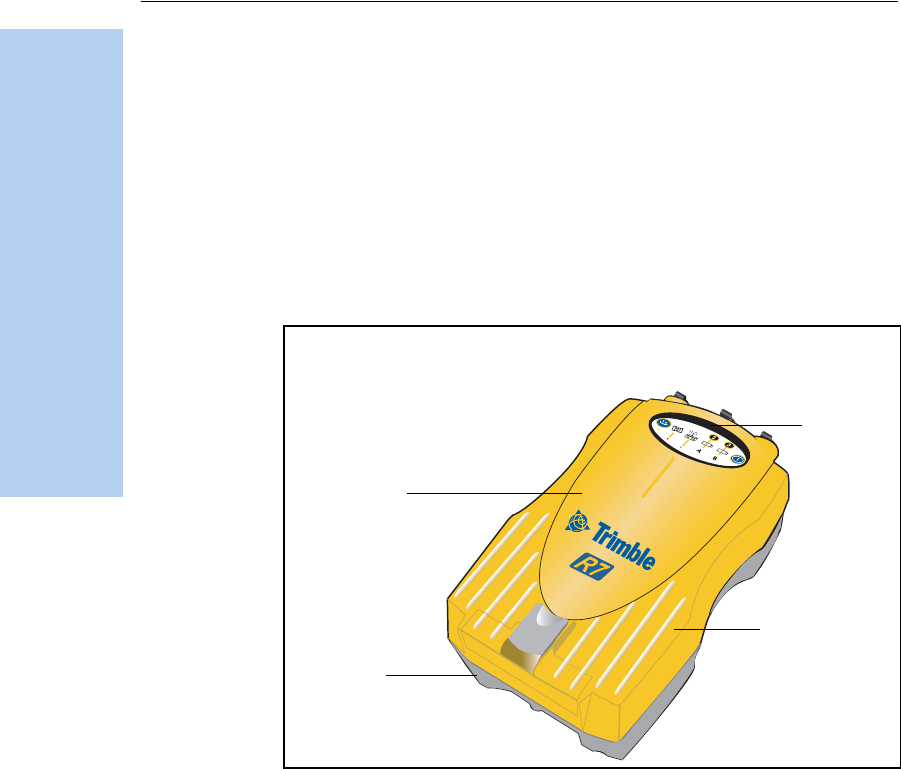
3 Setting up the Receiver
12 Trimble R7/R8 GPS Receiver User Guide
Trimble R7 GPS Receiver Operation
This chapter provides general setup information, connection
information, and cabling diagrams for the most common uses of the
Trimble R7 receiver.
3.1 Parts of the Receiver
All operating controls, ports, and connectors on the receiver are
located on its four main panels, as shown in Figure 3.1. This section
provides a brief overview of the features of each of these panels.
Figure 3.1 Panels on the Trimble R7 receiver
31.1 Front panel
Figure 3.2 shows the front panel of the Trimble R7 receiver. This panel
contains the five indicator LEDs, the two buttons, and the catch for the
CompactFlash/USB door.
Bottom
panel
Top
panel
Front
panel
Rear
panel
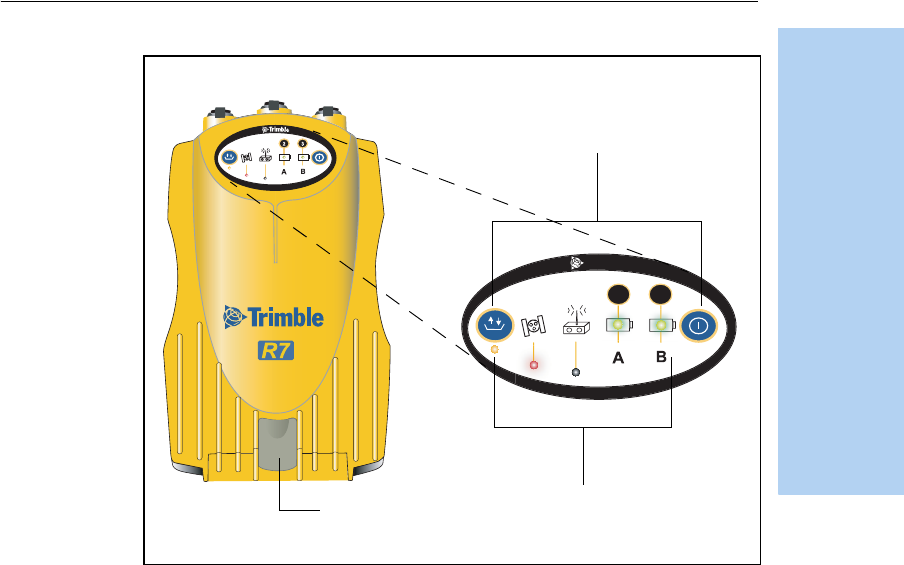
Trimble R7/R8 GPS Receiver User Guide 13
Setting up the Receiver 3
Trimble R7 GPS Receiver Operation
Figure 3.2 Front panel
The two buttons control data logging, data management, power, and
settings. For more information, see Button Functions, page 38.
The indicator LEDs show the status of logging, power, satellite tracking,
and radio reception. For more information, see LED Behavior, page 39.
31.2 Rear panel
Figure 3.3 shows the rear panel of the Trimble R7 receiver. This panel
contains a slot for attaching the receiver catch lock, and the catches for
the two battery compartments on the bottom panel. The catch lock
should already be attached to your receiver.
USB door catch
23
t
Buttons
Indicator LEDs
CompactFlash/
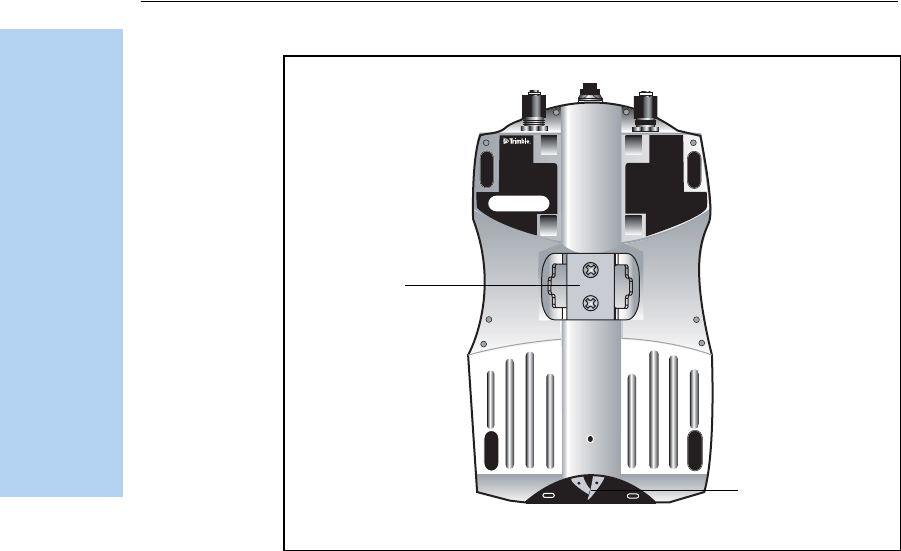
3 Setting up the Receiver
14 Trimble R7/R8 GPS Receiver User Guide
Trimble R7 GPS Receiver Operation
Figure 3.3 Rear panel
To mount the receiver on a pole, attach the receiver bracket to the pole
and then insert the catch lock into the bracket. For more information,
see Pole-Mounted Setup, page 22.
31.3 Top pan el
Figure 3.4 shows the top panel of the Trimble R7 receiver. This panel
contains the three power/serial data ports and (TNC) ports for GPS
and radio antenna connections.
compartment
Receiver
catch lock
Battery
catches
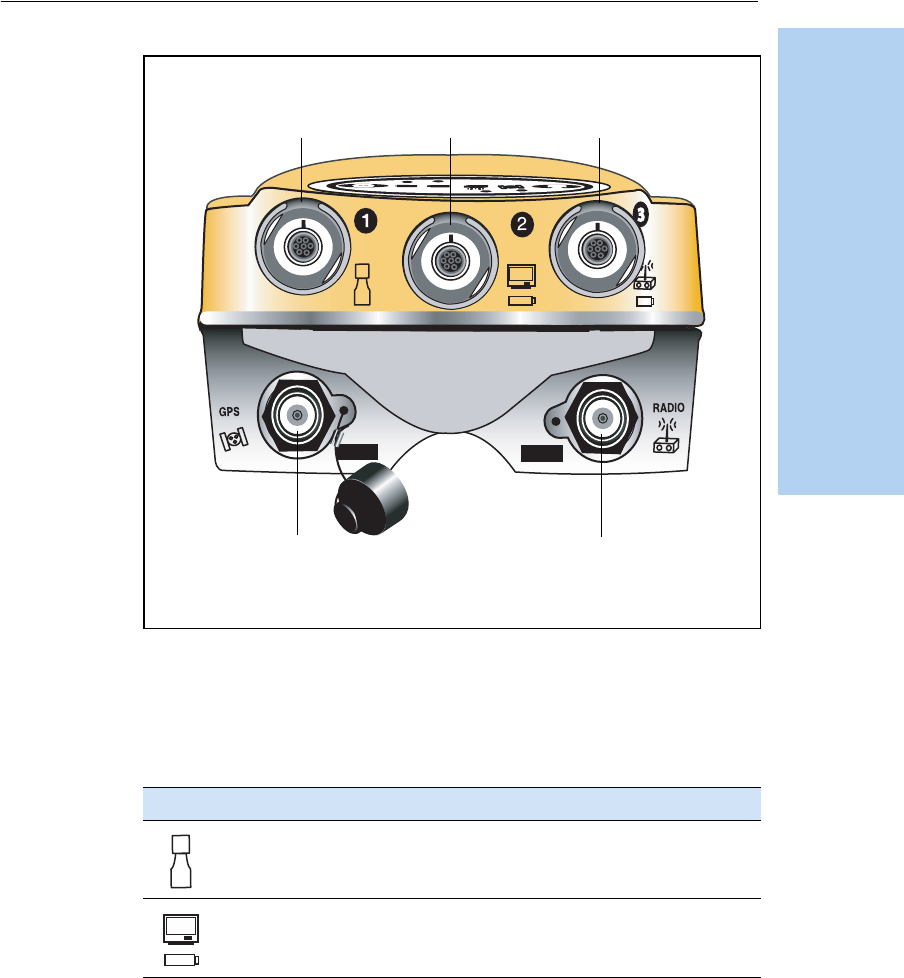
Trimble R7/R8 GPS Receiver User Guide 15
Setting up the Receiver 3
Trimble R7 GPS Receiver Operation
Figure 3.4 Top panel
Each port on the top panel is marked with an icon to indicate its main
function.
Table 3.1 Trimble R7 receiver receiver ports
Icon Name Connections
Port 1 Trimble controller, event marker, or computer
Port 2 Power in, computer, 1PPS, or event marker
Power/serial data ports
TNC ports
123
GPS antenna Radio antenna
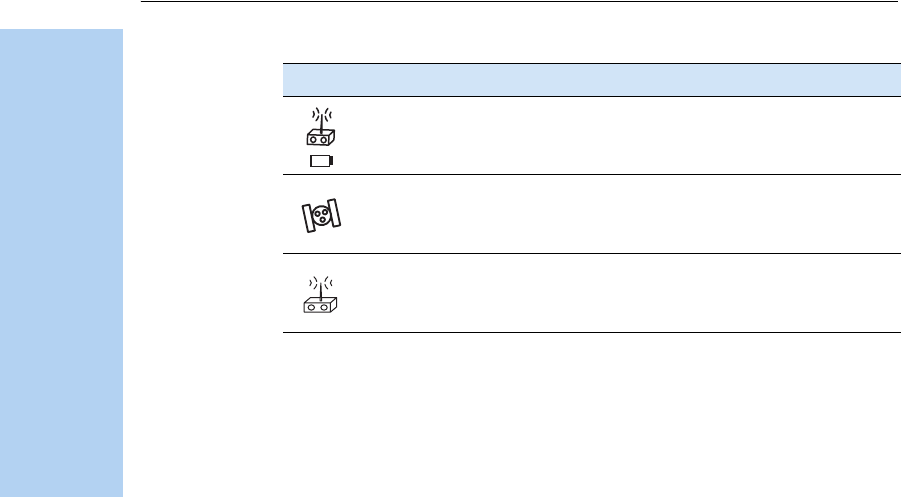
3 Setting up the Receiver
16 Trimble R7/R8 GPS Receiver User Guide
Trimble R7 GPS Receiver Operation
The power/serial data ports are all 7 pin 0-shell Lemo connectors. Both
Port 2 and Port 3 can accept external power. For more information, see
Default Settings, page 80 and Cables and Connectors, page 87.
The TNC port connectors are color-coded for easy system setup.
Connect the yellow GPS antenna cable to the yellow TNC port marked
GPS, and connect the blue Range Pole antenna (RPA) cable to the blue
TNC connector marked RADIO. For more information on connecting
the Trimble R7 receiver, see the following sections in this chapter.
31.4 Bottom panel
Figure 3.5 shows the bottom panel of the Trimble R7 receiver. This
panel contains the USB port, the CompactFlash port, and the
compartments for the two internal batteries.
Port 3 External radio, power in
GPS GPS antenna
RADIO Radio communications antenna
Table 3.1 Trimble R7 receiver receiver ports
Icon Name Connections
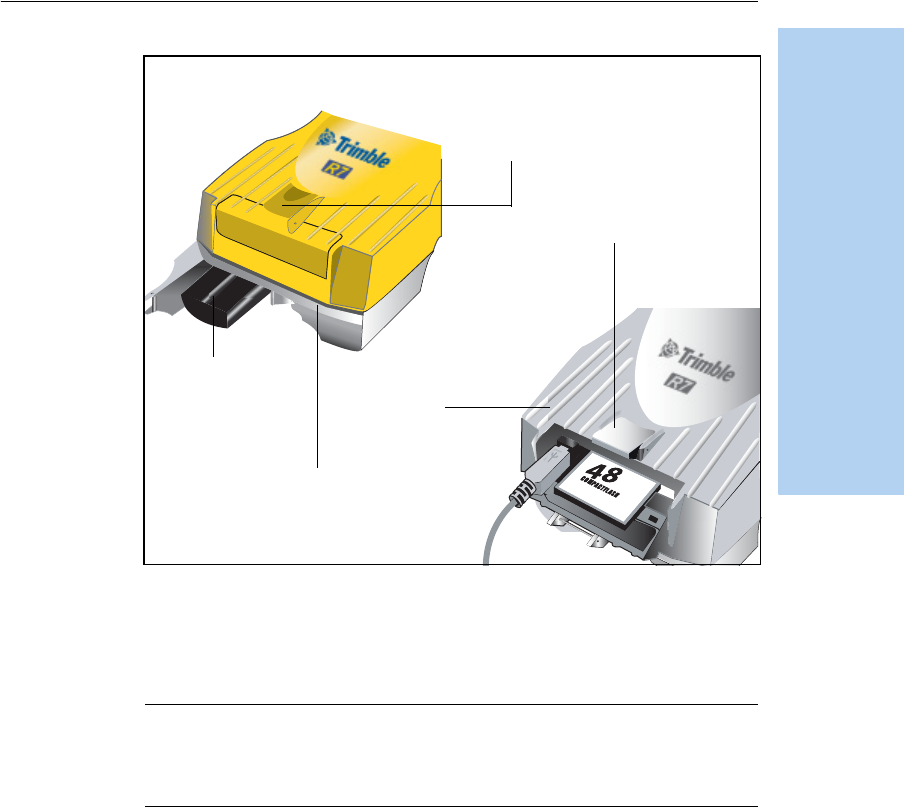
Trimble R7/R8 GPS Receiver User Guide 17
Setting up the Receiver 3
Trimble R7 GPS Receiver Operation
Figure 3.5 Bottom panel
The CompactFlash/USB door conceals the CompactFlash port and
USB port. To open the door, push down the catch on the front panel.
CWARNING – When there is no USB cable connected, or when using the
receiver in a harsh environment, keep this door closed to keep moisture,
dust, and dirt out of the ports. The temperature rating of the receiver
applies only when all doors on the receiver are closed.
CompactFlash port
USB port
Internal battery
compartment
Internal battery
CompactFlash/
USB door

3 Setting up the Receiver
18 Trimble R7/R8 GPS Receiver User Guide
Trimble R7 GPS Receiver Operation
3.2 Setup Guidelines
Consider the following guidelines when setting up the Trimble R7
receiver.
32.1 Environmental conditions
Although the Trimble R7 receiver has a waterproof housing, reasonable
care should be taken to keep the unit dry. Avoid exposure to extreme
environmental conditions, including:
•Water
•Heat greater than 65° C (149° F)
•Cold less than –40° C (–40° F)
•Corrosive fluids and gases
Avoiding these conditions improves the receiver performance and
long-term reliability.
32.2 Sources of electrical interference
Avoid the following sources of electrical and magnetic noise:
•Gasoline engines (spark plugs)
•Televisions and computer monitors
•Alternators and generators
•Electric motors
•Equipment with DC-to-AC converters
•Fluorescent lights
•Switching power supplies

Trimble R7/R8 GPS Receiver User Guide 19
Setting up the Receiver 3
Trimble R7 GPS Receiver Operation
32.3 General guidelines
CWARNING – These receivers use a rechargeable Lithium-ion battery. To
avoid personal injury or equipment damage, make sure that you read and
understand the Safety Information chapter at the front of this manual.
The following guidelines apply whenever you set up your receiver for
operation:
•When plugging in a Lemo cable, make sure that the red dots on
the receiver port and the cable connector line up. Do not use
force to plug cables in, as this may damage the connector pins.
•When disconnecting a Lemo cable, grasp the cable by the sliding
collar or lanyard and pull the cable connector straight out of the
port. Do not twist the connector or pull on the cable itself.
•To securely connect a TNC cable, align the cable connector with
the receiver receptacle and thread the cable connector onto the
receptacle until snug.
•Insert the internal batteries with the battery contacts facing the
CompactFlash/USB door. The undersides of the batteries have a
center groove for alignment when being inserted into the
receiver.
3.3 Postprocessed Setup
For a postprocessed survey, you only need:
•the Trimble R7 receiver receiver
•a Zephyr™ or Zephyr Geodetic™ antenna
•a GPS antenna cable
Other equipment, as described below, is optional.

3 Setting up the Receiver
20 Trimble R7/R8 GPS Receiver User Guide
Trimble R7 GPS Receiver Operation
To set up the Trimble R7 receiver for a postprocessed survey:
1. Set up the tripod with the tribrach and antenna adapter over the
survey mark.
Instead of a tripod, you can use a range pole with a bipod.
However, Trimble recommends that you use a tripod for greater
stability.
2. Mount the antenna on the tribrach adapter.
3. Use the tripod clip to hang the receiver on the tripod.
4. Connect the yellow GPS antenna cable to the Zephyr antenna.
5. Connect the other end of the GPS antenna cable to the yellow
TNC port on the receiver.
6. If external power is required, connect a battery with an 0-shell
Lemo connection to Port 2 or Port 3 on the receiver.
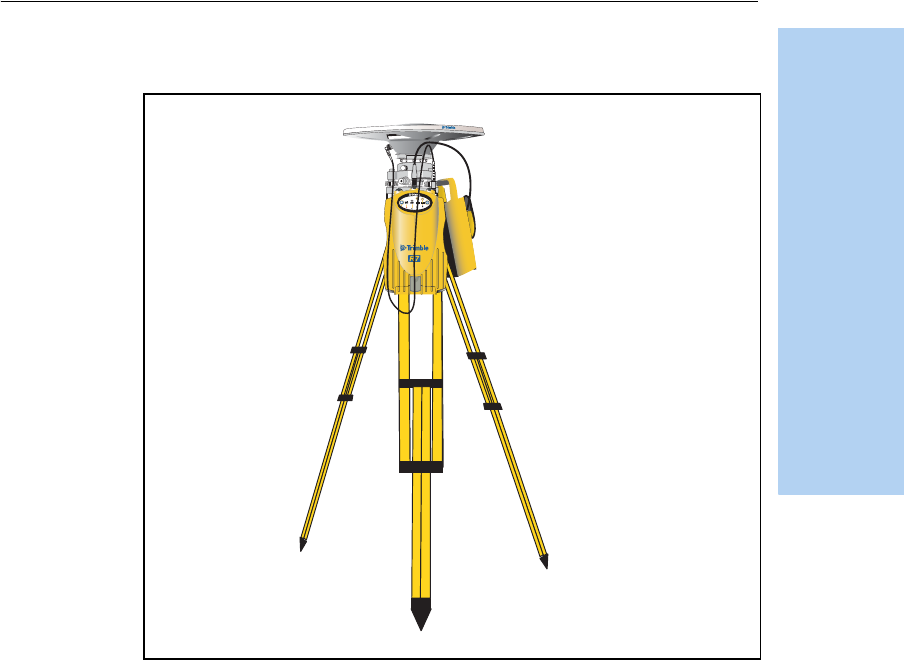
Trimble R7/R8 GPS Receiver User Guide 21
Setting up the Receiver 3
Trimble R7 GPS Receiver Operation
Figure 3.6 shows the Trimble R7 receiver receiver postprocessed setup.
Figure 3.6 Postprocessed setup
Note – Instead of hanging the receiver on the tripod, you can place the
receiver in its base case. Run the antenna cable out of the portal in the side
of the base case to the antenna so that the case can stay closed while the
receiver is running.

3 Setting up the Receiver
22 Trimble R7/R8 GPS Receiver User Guide
Trimble R7 GPS Receiver Operation
3.1 Pole-Mounted Setup
To mount the Trimble R7 receiver on a pole, you need to do the
following:
1. Mount the eRTK™ Range Pole antenna (RPA).
2. Mount the receiver.
3. Mount the Trimble controller.
This section provides detailed instructions on each of these three steps.
Mounting the Range Pole antenna (RPA)
To mount the RPA on the pole:
1. Install the RPA bracket 7.5 cm (3") from the pole top by placing
the two pieces together and securing with screws. If you are
using a 1" diameter pole, place the bracket inserts inside the
bracket before securing.
Note – You can use a quarter-wave whip (“rubber duck”)
antenna attached directly to the receiver instead of the RPA.
2. Connect the yellow TNC-to-TNC GPS cable and run it through
the RPA bracket clips where it is labeled on the bracket. Make
sure that the right-angle connector is at the top.
The cable must be routed inside the RPA, through the
bracket, or it will affect the RPA radio reception performance.
3. Align the TNC connector on the RPA with the GPS antenna cable
on the bracket, and while feeding the cable through the RPA,
slide the RPA onto the bracket until it clicks.
Figure 3.7, on page 23 shows the Trimble R7 receiver receiver
pole-mounted setup.
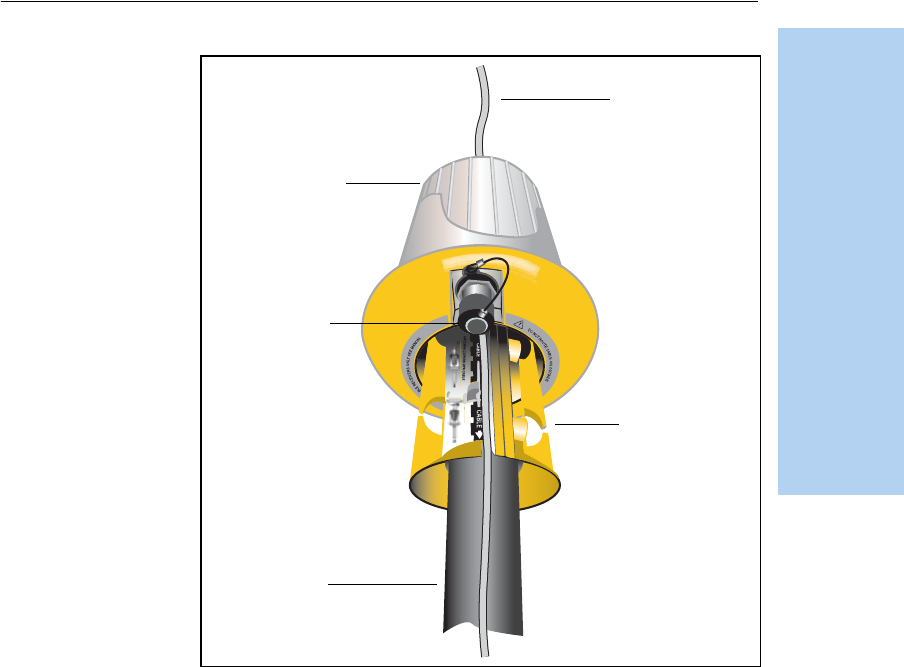
Trimble R7/R8 GPS Receiver User Guide 23
Setting up the Receiver 3
Trimble R7 GPS Receiver Operation
Figure 3.7 RPA and bracket
4. Mount the Zephyr antenna on the range pole.
5. Connect the GPS antenna cable. Make sure that the GPS cable is
not hanging over the top of the RPA.
6. Connect the blue TNC-to-TNC radio cable to the RPA.
RPA
GPS antenna
cable
Pole
RPA
bracket
TNC port
(aligned over
antenna cable)
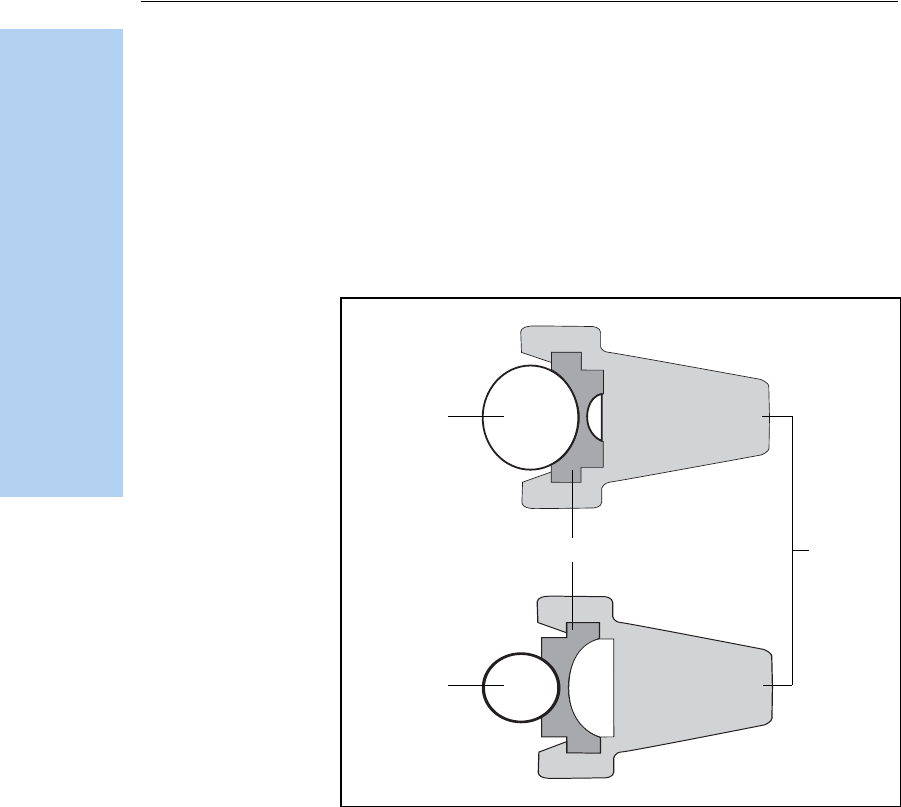
3 Setting up the Receiver
24 Trimble R7/R8 GPS Receiver User Guide
Trimble R7 GPS Receiver Operation
Mounting the Trimble R7 receiver
To mount the receiver on the pole:
1. Attach the receiver bracket to the pole:
a. Place the bracket against the pole, approximately 0.5 m
from the ground.
If you are using a 1" diameter pole, flip the black
insert around inside the bracket, as shown in Figure 3.8.
Figure 3.8 Receiver bracket insert
b. Close the gates of the bracket around the pole.
c. Seat the base of the clip lock in the opposite gate.
d. Lock the clip lock.
Bracket insert Bracket
11/4" pole
1" pole
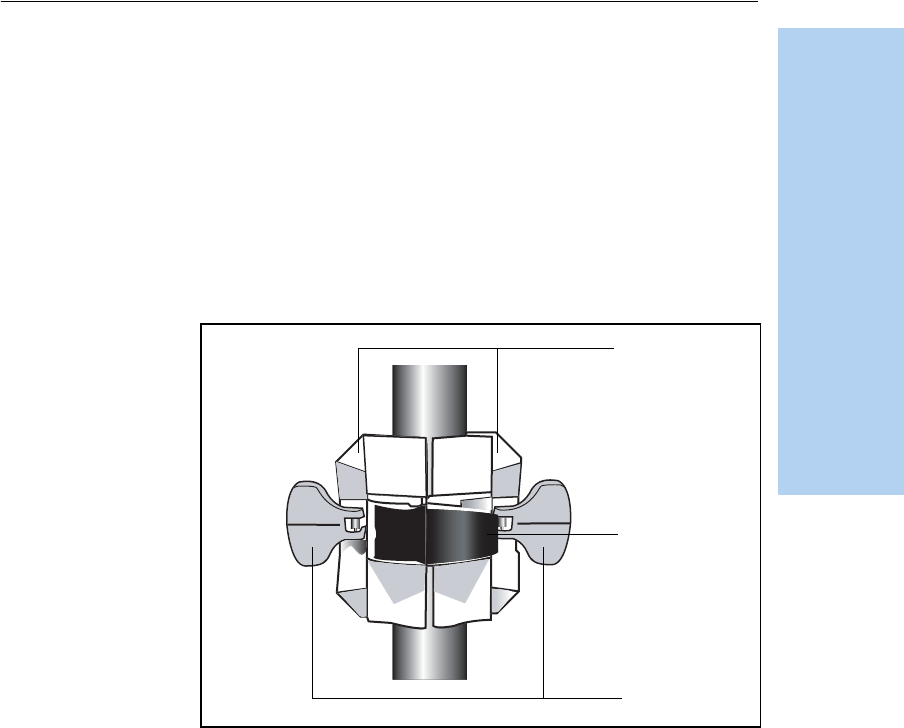
Trimble R7/R8 GPS Receiver User Guide 25
Setting up the Receiver 3
Trimble R7 GPS Receiver Operation
If the clip lock is too tight to be locked, turn it one or two
turns counterclockwise and try again. If it is too loose, turn
it one or two turns clockwise and try to lock it again.
2. Mount the receiver on the bracket:
a. Pull the bracket side locks in towards the pole.
b. Set the receiver catch lock in the bracket.
c. Holding the receiver in the bracket, pull the side locks back
to their original positions, as shown in Figure 3.9.
Figure 3.9 Trimble R7 receiver receiver bracket
3. Connect the blue TNC radio communications cable to the blue
TNC port on the receiver. If necessary, adjust the position of the
receiver to remove cable slack.
4. Connect the yellow TNC GPS antenna cable to the yellow TNC
port on the receiver. If necessary, adjust the position of the
receiver to remove cable slack.
Clip lock
Gates
Side locks

3 Setting up the Receiver
26 Trimble R7/R8 GPS Receiver User Guide
Trimble R7 GPS Receiver Operation
Mounting the TSCe controller
1. Mount the TSCe™ controller bracket on the pole:
a. Place the bracket against the pole at a comfortable height.
b. Rotate the clamping screw on the bracket pole until tight.
c. Place the controller into the cradle assembly and tighten
the clamping mechanism.
d. Any cables running down the pole should be run through
the machined groove on the inside of the controller bracket.
e. Position the controller in the preferred position for
operation by pressing the spring-loaded release button on
the cradle, pulling the assembly outward, and rotating the
cradle assembly to the desired angle. Reseat the cradle in
the proper position by lining up the alignment pins and
pushing inward until the release button locks.
2. Connect one end of the 2 ft 0-shell to 0-shell Lemo cable to the
controller.
3. Connect the other end of the Lemo cable to Port 1 on the
receiver.
4. Place the hand grip below the controller bracket (or above it,
depending on the position of the bracket), with the cables
running through the grip.
5. Secure any loose cables, using the velcro cable ties.
Figure 3.10, on page 27 shows the pole-mounted setup.
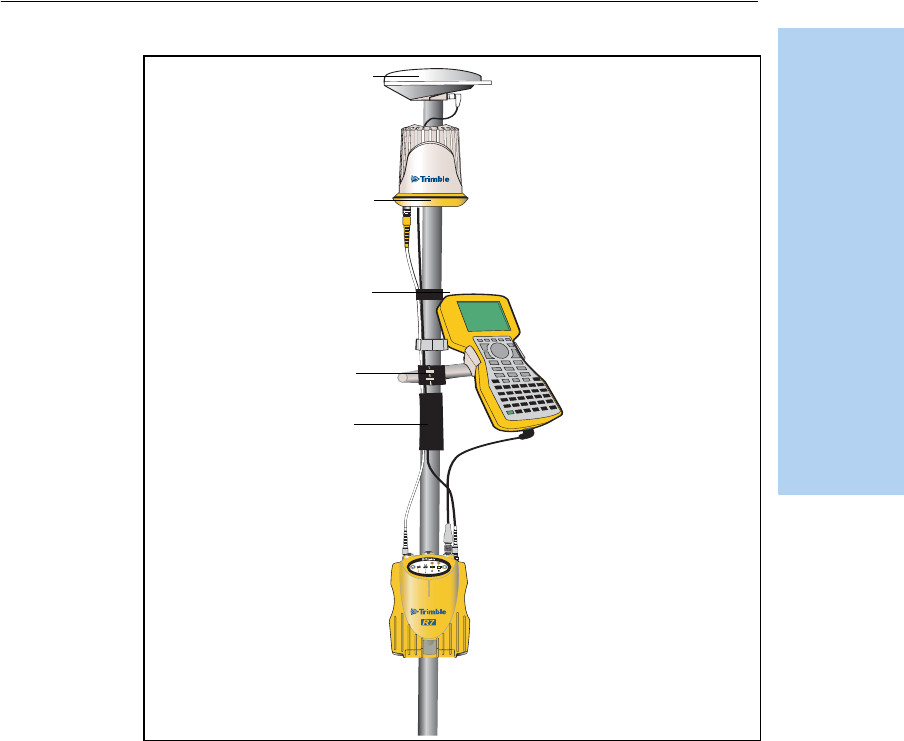
Trimble R7/R8 GPS Receiver User Guide 27
Setting up the Receiver 3
Trimble R7 GPS Receiver Operation
Figure 3.10 Pole-mounted setup
Hand grip
RPA
Zephyr antenna
Velcro tie
TSCe bracket

3 Setting up the Receiver
28 Trimble R7/R8 GPS Receiver User Guide
Trimble R7 GPS Receiver Operation
3.1 Backpack Setup
Both the whip and RPA antennae are suitable for use in a backpack.
The RPA is installed in the same manner as for the pole-mounted setup
(see Pole-Mounted Setup, page 22).
BTip – The RPA is tuned for operation with the GPS antenna cable running
through it. Operating it from a backpack may reduce its operating range.
Trimble recommends that you use the whip antenna.
To set up the Trimble R7 receiver for use in a backpack:
1. Insert the receiver into the backpack with the ports on the top
panel facing upwards and the front panel facing outwards.
Secure the receiver around the middle with the velcro strap.
2. Attach the Zephyr antenna to a range pole.
3. Attach the whip antenna mount to one of the fittings on the top
of the backpack.
4. The backpack has a feedthrough on both sides at the top and on
both sides near the bottom to allow cables to be positioned out
of the way of the main zipper. Run the radio communications
cable through at the top, and connect it to the blue TNC port on
the receiver.
5. Connect the straight end of the yellow GPS cable to the yellow
TNC port on the receiver.
6. Run the right-angle connector on the yellow GPS cable through
the top or side slot on the backpack, and connect it to the
Zephyr antenna.
7. Connect one end of the 6 ft 0-shell to 0-shell cable to Port 1 on
the receiver.
8. Run the 0-shell cable through the side slot of the backpack and
connect it to the TSCe controller.

3 Setting up the Receiver
30 Trimble R7/R8 GPS Receiver User Guide
Trimble R7 GPS Receiver Operation
3.1 Other System Components
This section describes optional components that you can use with the
Trimble R7 receiver.
31.1 Radios
Radios are the most common data link for Real-Time Kinematic (RTK)
surveying. The Trimble R7 receiver is available with an optional
internal radio in either the 450 or 900 MHz UHF bands. You can also
connect an external radio to Port 3, whether or not the internal radio is
installed.
The Trimble R7 receiver supports the following Trimble base radios
when using the internal receiver radio:
•TRIMMARK™ 3
•TRIMMARK IIe
•TRIMTALK™ 450S
•SiteNet™ 450
•SiteNet 900
•Trimble R8 internal transmitter (base)
Internal radio setup
You can configure the Trimble R7 receiver optional internal radio using
any of the following:
•the GPS Configurator software
•the WinFlash software
•the Trimble Survey Controller software
For more information, refer to the GPS Configurator Help, the
WinFlash Help, or the Trimble Survey Controller User Guide.

Trimble R7/R8 GPS Receiver User Guide 31
Setting up the Receiver 3
Trimble R7 GPS Receiver Operation
By default, the internal UHF radio has only a few frequencies installed.
Use the WinFlash software to configure additional frequencies. For
more information, see Adding frequencies for the 450 MHz internal
radio, page 71.
External radio setup
To use an external radio with the Trimble R7 receiver, you need an
external power source for the radio.
To set up a Trimble R7 receiver using an external radio:
1. Connect one end of the yellow GPS antenna cable to the yellow
TNC port on the receiver.
2. Connect the other end of the GPS antenna cable to a Zephyr or
Zephyr Geodetic antenna.
3. Connect the external radio to Port 3 on the receiver.
4. Connect a radio antenna to the external radio.
Figure 3.12 shows a TRIMMARK 3 radio connected to a
Trimble R7 receiver.
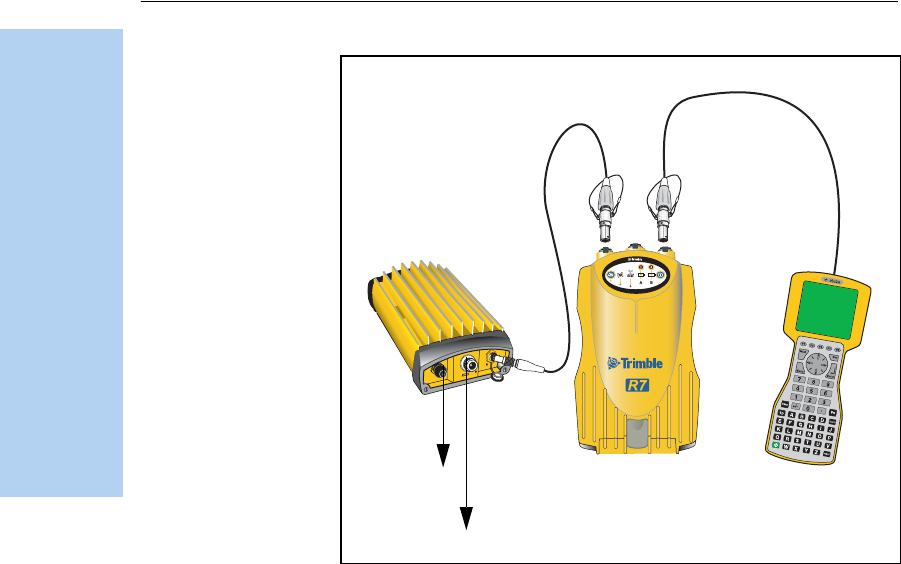
3 Setting up the Receiver
32 Trimble R7/R8 GPS Receiver User Guide
Trimble R7 GPS Receiver Operation
Figure 3.12 Connecting an external radio
5. Connect an external power source to Port 2 on the receiver.
External rover radios must have their own power source
because the internal Lithium-ion batteries do not supply enough
voltage. Alternatively, supply external power to port 2 of the
receiver, and enable power out on port 3.
Base radios must have their own power source because of their
high power consumption.
Alternatively, you can apply external power directly to the radio,
if it supports it.
You can use a 10 Ah battery, a 6 Ah battery, or camcorder
batteries. The choice of power supply depends on the
application, and whether you are using the radio as a reference
To antenna
To power supply

Trimble R7/R8 GPS Receiver User Guide 33
Setting up the Receiver 3
Trimble R7 GPS Receiver Operation
or rover radio. For more information about the power
capabilities of the Trimble R7 receiver, see Batteries and Power,
page 44.
6. Configure the external radio using Trimble Survey Controller
software. Alternatively, you can configure a TRIMMARK 3 radio
using the WinFlash software or the configuration software
supplied with the radio.
For more information, refer to the Trimble Survey Controller User
Guide or the appropriate Help.
7. Set up any other equipment as required, depending on whether
you are using the radio as a reference or a rover radio.
30.1 Cellular modems
You can use a cellular modem instead of a radio as your data
communications link. Cellular modems and other radio links can be
used to extend the limits of your surveys.
To connect a cellular modem to a Trimble R7 receiver, you need the
following:
•A Trimble R7 receiver
•A custom-designed cellular modem, or a cellphone that can
transmit and receive data
•Serial (cellphone to DB9) cable (supplied with the cellular
modem or phone)
•Trimble DB9 to 0-shell Lemo cable
This cable is suitable only if flow control can be disabled
on the cellular modem. If the cellular modem does not support
this functionality, a special cable is required. For more
information, refer to the document Using Cellular and CDPD
Modems for RTK, which is available from your local Trimble
Distributor.
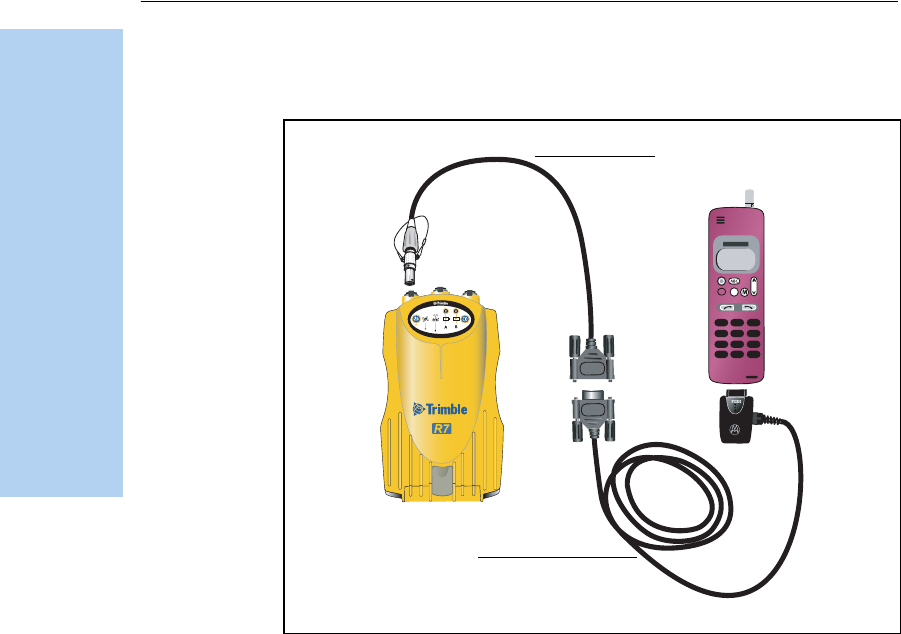
3 Setting up the Receiver
34 Trimble R7/R8 GPS Receiver User Guide
Trimble R7 GPS Receiver Operation
Figure 3.13 shows the components required to connect a cellphone to a
Trimble R7 receiver.
Figure 3.13 Connecting a cellphone
For more information on using a cellular modem as a data link, refer to
the Trimble Survey Controller User Guide.
30.2 Antennas
The Trimble R7 receiver should normally be used with a Zephyr or
Zephyr Geodetic antenna, which have been designed specifically for
use with this receiver.
Serial cable
DB9 to Lemo cable
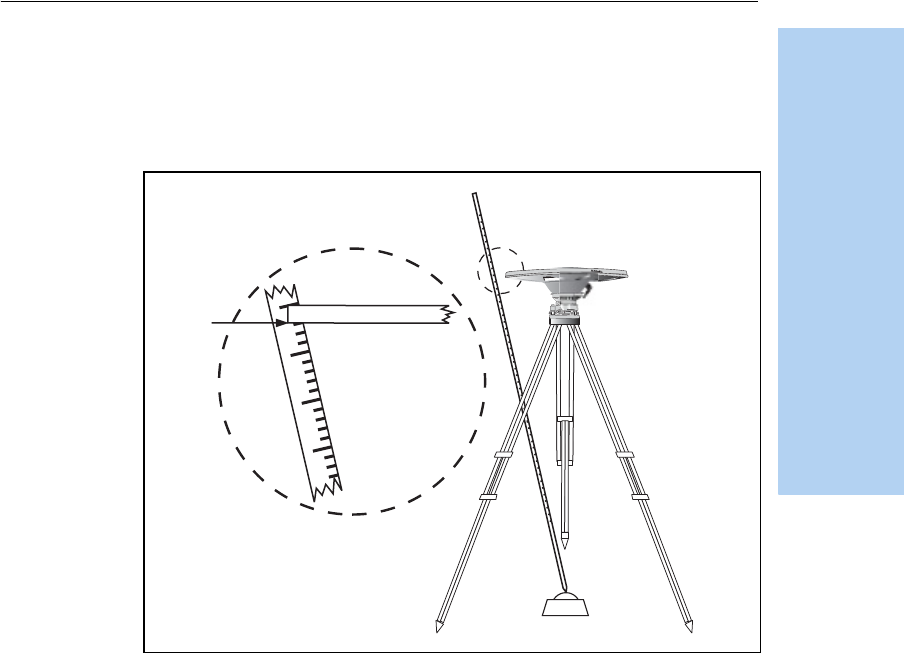
Trimble R7/R8 GPS Receiver User Guide 35
Setting up the Receiver 3
Trimble R7 GPS Receiver Operation
Use Figure 3.14 as a guide for measuring the height of the Zephyr and
Zephyr Geodetic antennas. The Zephyr antenna is designed to be
measured to the top of the notch. The Zephyr Geodetic (shown) has
been designed to be measured to the bottom of the notch.
Figure 3.14 Measuring antenna height
Older models of antennas, such as the Choke Ring or Micro-Centered™
L1/L2 antennas, need more power to operate than the Zephyr models.
To configure the receiver to output more power on the antenna port,
select the correct antenna type in GPS Configurator, or through the
Trimble controller. For information on how to do this, contact your
local Trimble Service Provider.
1.520
1.510
1.515
1.505

3 Setting up the Receiver
36 Trimble R7/R8 GPS Receiver User Guide
Trimble R7 GPS Receiver Operation
30.3 CompactFlash cards
The Trimble R7 receiver logs data internally on a CompactFlash card.
However, it only support the Type I CompactFlash card. Trimble
recommends that you use an industrial-rated CompactFlash card, as
commercial cards have a limited operating temperature range.
Before logging data to a CompactFlash card, format the card to ensure
the integrity of the file system. To format the card, insert it in the
receiver and then hold down the power button for 30 seconds.
Note – Make sure that you format your CompactFlash card in the receiver.
This prevents data on the card from being corrupted if the card is removed
while data is being logged. Formatting the card in your computer may
cause data corruption, or loss of data.
When inserting the card, make sure that it slides into the card slot
properly.
CWARNING –
– The Trimble R7 receiver allows for a maximum of 512 files on the
CompactFlash card, regardless of the card’s capacity. The file names must
be in 8.3 format, otherwise files copied to the CompactFlash card may
cause data corruption or loss of data when logging.
– If the card does not seat into the pins correctly, do not use force or you
may damage the pins. Remove the card and carefully reinsert it.
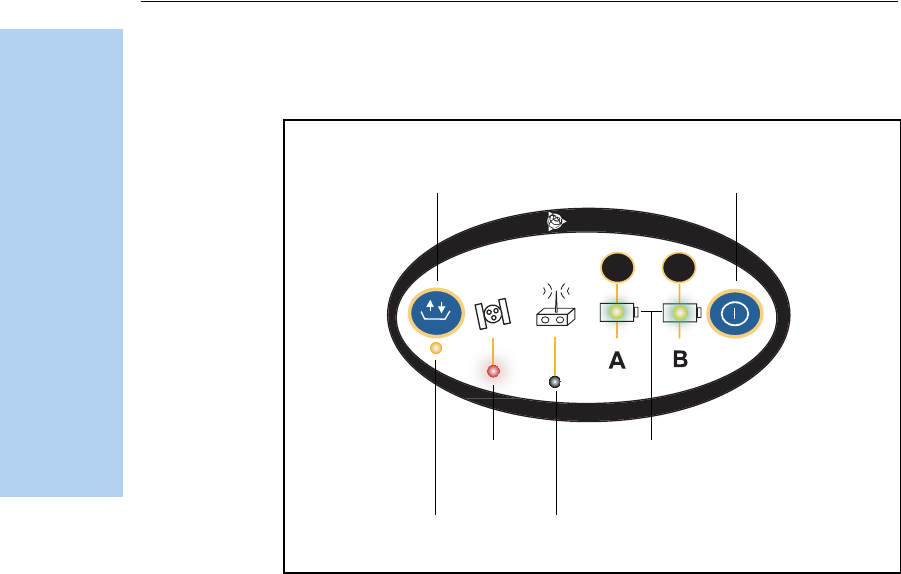
4 General Operation
38 Trimble R7/R8 GPS Receiver User Guide
Trimble R7 GPS Receiver Operation
All the controls that you need for general operation of the Trimble R7
receiver are located on the front panel, as shown in Figure 4.1.
Figure 4.1 Controls on the front panel of the Trimble R7 receiver
For more information about other panels of the Trimble R7 receiver, see
Parts of the Receiver, page 12.
4.1 Button Functions
The Trimble R7 receiver has only two buttons: in this manual, the
Power button is represented by [P], and the Data button by [D].
Press [P] to switch the receiver on or off, and to perform data
management functions such as deleting files or resetting the receiver.
Press [D] to start or stop logging. This button is only effective when the
receiver is switched on and has completed any power-up and
initialization tasks.
23
t
Logging/
Memory LED
Data button [D] Power button [P]
Battery LEDsSV Tracking
Radio/Event
LED
Marker LED

Trimble R7/R8 GPS Receiver User Guide 39
General Operation 4
Trimble R7 GPS Receiver Operation
Table 4.1 describes the main functions of the two buttons.
Note – The term “press” means to press the button and release it
immediately. The term “hold” means to press the button and hold it down
for the given time.
4.2 LED Behavior
The five LEDs on the top panel of the receiver indicate various
operating conditions. Generally, a lit or slowly flashing LED indicates
normal operation, an LED that is flashing quickly indicates a condition
that may require attention, and an unlit LED indicates that no
operation is occurring. The following table defines each possible LED
state.
Table 4.1 Button functions
Action Power button Data button
Turn on the receiver Press
Turn off the receiver Hold for 2 seconds
Start logging data internally Press
Stop logging data internally Hold for 2 seconds
Delete the ephemeris file Hold for 15 seconds
Reset the receiver to factory defaults Hold for 15 seconds
Delete application files Hold for 30 seconds
Format the CompactFlash card Hold for 30 seconds
The term … means that the LED …
Flash is lit briefly every 3 seconds
Slow flash alternates slowly between being lit and unlit
Fast flash alternates rapidly between being lit and unlit
On is lit
Off is unlit

4 General Operation
40 Trimble R7/R8 GPS Receiver User Guide
Trimble R7 GPS Receiver Operation
42.1 Logging/Memory LED
The yellow Logging/Memory LED below the G button indicates the
status of data logging and memory usage.
42.2 SV Tracking LED
The red SV Tracking LED below the SV icon indicates the status of
satellite tracking.
42.3 Radio LED
The green Radio LED below the Radio icon indicates the status of
data input and output.
Behavior Meaning
On Data is being logged.
Slow flash Enough FastStatic data has been logged.
Alternatively, if the red SV Tracking LED is on solid at the
same time, the receiver is in Monitor mode, and is
checking for new firmware to install.
Fast flash Data is being logged but memory is low.
Flash The receiver is in Sleep mode, and will wake up five
minutes before the scheduled start time of a timed
application file.
Off Data is not being logged, or the CompactFlash card is
full.
Behavior Meaning
Slow flash Tracking four or more satellites.
Fast flash Tracking three or fewer satellites.
Off Not tracking any satellites.
On The receiver is in Monitor mode, and is checking for new
firmware to install.
Behavior Meaning
Slow flash A data packet or event marker has been received.

Trimble R7/R8 GPS Receiver User Guide 41
General Operation 4
Trimble R7 GPS Receiver Operation
42.4 Battery 1 LED and Battery 2 LED
The Battery LEDs inside the two Battery icons indicate the status
of the two internal batteries, or the power sources connected on Ports 2
and 3.
By default, each battery LED indicates the status of the external power
source on the corresponding port. If no external source is detected,
each LED indicates the status of an internal battery. The color of the
LED indicates whether the power source is currently in use (green) or is
on standby (yellow).
4.3 Starting and Stopping the Receiver
To turn on the receiver, press [P].
To turn off the receiver, hold down [P] for two seconds.
4.4 Logging Data
You can log data to the CompactFlash card in the receiver, or to the
survey device.
Color Meaning Behavior Meaning
Green Power source is
in use
On Healthy
Fast flash Low power
Off No power source is present
Yellow Power source is
on standby
On Healthy
Fast flash Low power
Flash Dead
Off No power source is present

4 General Operation
42 Trimble R7/R8 GPS Receiver User Guide
Trimble R7 GPS Receiver Operation
44.1 Logging internally
The Trimble R7 receiver logs GPS data internally on a CompactFlash
card. You can then use the Trimble Data Transfer utility to transfer
logged data files to your office computer. The transferred files are in
Trimble DAT (.dat) format.
CWARNING – The Trimble R7 receiver allows for a maximum of 512 files on
the CompactFlash card, regardless of the card’s capacity. The file names
must be in 8.3 format, otherwise files copied to the CompactFlash card
may cause data corruption or loss of data when logging.
Data is logged using the current logging settings configured in the
receiver. Data files logged internally are named automatically.
To begin internal logging, press [D]. The Logging/Memory LED lights
up.
To stop logging, hold down [D] for at least two seconds. The
Logging/Memory LED turns off.
Note – When the CompactFlash card is full, the receiver stops logging
data, and the Logging/Memory LED switches off. Existing data files are
not overwritten.
Approximate storage requirements for different logging rates are
shown in Table 4.2. The values shown are for a one-hour logging session
with six satellites visible.
Table 4.2 Storage requirements
Logging rate Memory required
10 Hz 2,588 KB
1Hz 335 KB
5 seconds 87 KB
15 seconds 37 KB

Trimble R7/R8 GPS Receiver User Guide 43
General Operation 4
Trimble R7 GPS Receiver Operation
Note – If power is lost, or the CompactFlash card is removed while logging,
the file system is designed so that a maximum of ten seconds of data will
be lost, regardless of the logging rate. To ensure that this behavior occurs,
use GPS Configurator to perform a quick format of the CompactFlash card
before logging data to the card for the first time.
44.2 Logging to a Trimble controller
When the Trimble R7 receiver is connected to a Trimble controller, you
can log GPS data from the receiver to the controller, or to a PC card
inserted in the controller. When you use a Trimble controller, you do
not use the receiver’s controls. Instead, you use the controller functions
to set logging options, specify filenames, and to control when logging
occurs.
Data is stored in job files, which can be transferred to your office
computer using Trimble’s Data Transfer utility.
For more information on logging data from a receiver using a Trimble
controller refer, to the user guide for your particular controller.
4.5 Resetting to Defaults
CWARNING – Do not hold down [P] for more than 30 seconds. After 30
seconds, any application files stored in the receiver are deleted and the
CompactFlash card is reformatted.
To reset the receiver to its factory default settings, hold down [P] for at
least 15 seconds.
Resetting the receiver to its factory defaults also deletes any ephemeris
file in the receiver.
For more information, see Chapter 9, Default Settings.

4 General Operation
44 Trimble R7/R8 GPS Receiver User Guide
Trimble R7 GPS Receiver Operation
4.6 Formatting a CompactFlash Card
CWARNING – Formatting a CompactFlash card while it is in the receiver
deletes all the data files on the card and all the application files in the
receiver.
To format a CompactFlash card for use in a Trimble R7 receiver, insert
the card in the CompactFlash port and then hold down [P] for at least
30 seconds. After 15 seconds, the receiver is reset to its factory defaults,
and any ephemeris file is deleted. After 30 seconds, any files stored on
the card are deleted and the CompactFlash card is reformatted.
Note – When you use [P] to format the CompactFlash card, a quick format
is performed. A quick format reformats the card for use with the
Trimble R7 receiver receiver and deletes all data on the card. A full format
checks the card for errors or bad sectors, and is only necessary if the card
is corrupted. To perform a full format, use the GPS Configurator software.
For more information, see The GPS Configurator Software, page 68.
4.7 Batteries and Power
CWARNING – Do not damage the rechargeable Lithium-ion battery. A
damaged battery can cause an explosion or fire, and can result in personal
injury and/or property damage.
To prevent injury or damage:
– Do not use or charge the battery if it appears to be damaged. Signs of
damage include, but are not limited to, discoloration, warping, and
leaking battery fluid.
– Do not expose the battery to fire, high temperature, or direct sunlight.
– Do not immerse the battery in water.
– Do not use or store the battery inside a vehicle during hot weather.
– Do not drop or puncture the battery.
– Do not open the battery or short-circuit its contacts.
The Trimble R7 receiver can be powered either by its two internal
batteries or by an external power source connected to Port 2 or Port 3.
The charge provided by the internal batteries depends on the type of

Trimble R7/R8 GPS Receiver User Guide 45
General Operation 4
Trimble R7 GPS Receiver Operation
survey and operating conditions. Typically, one battery provides about
3.5 hours of power during an RTK survey using the internal radio, and
about 5 hours during a survey without the internal radio.
The external power source is always used in preference to the internal
batteries. When there is no external power source connected, or if the
external power supply fails, the internal batteries are used. The internal
batteries are drained in turn, and the receiver automatically switches to
the full battery when the first battery is drained.
If no external power is supplied and both internal batteries are drained,
none of the data that you have logged is lost. When internal or external
power is restored, the receiver restarts in the same state as when power
was lost. For example, if the receiver was logging data, the data file is
not corrupted, and when power is restored the receiver resumes
logging with the same settings as before.
The power supply that comes with the Trimble R7 receiver charges the
internal batteries while they are still in the receiver. To do this, connect
the power supply to the power/serial data cable, connect the cable to
Port 2 on the receiver and then connect the power supply to an AC
power source, as shown in Figure 4.2 on page 46.
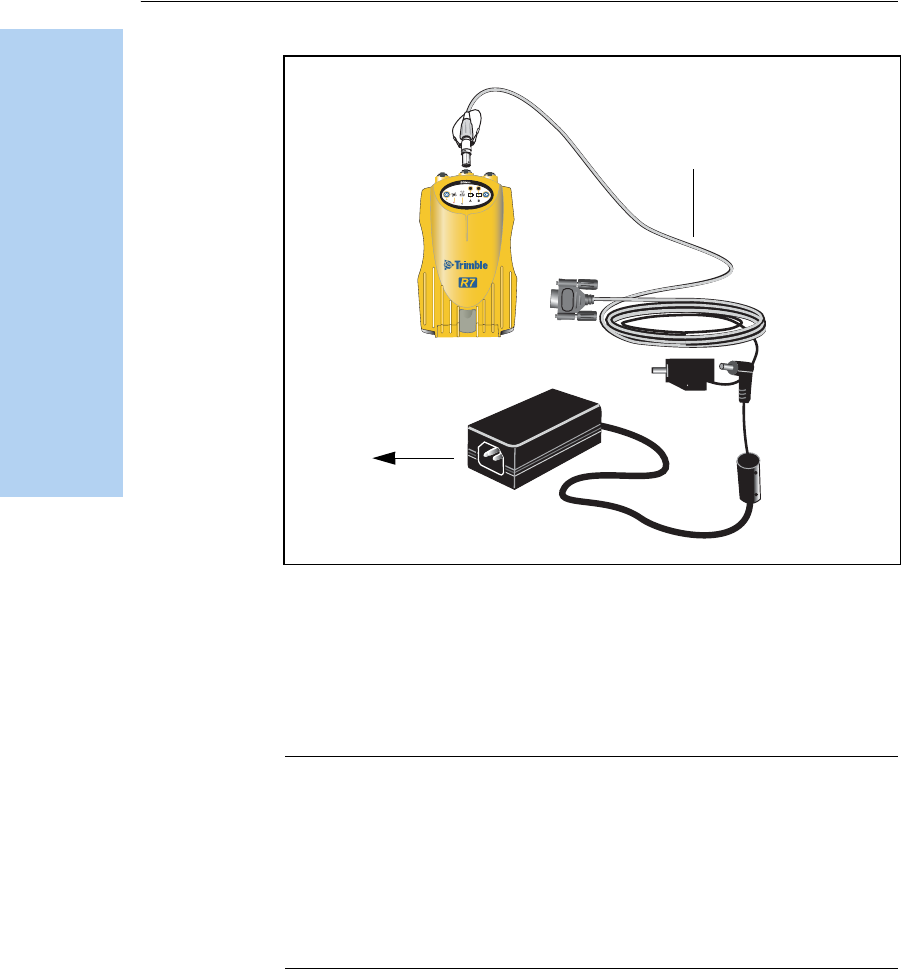
4 General Operation
46 Trimble R7/R8 GPS Receiver User Guide
Trimble R7 GPS Receiver Operation
Figure 4.2 Charging the batteries
The two internal batteries take approximately eight hours to charge.
They are charged individually, so each battery takes approximately four
hours to charge. The internal batteries start charging whenever an
external power supply of greater than 15 V is detected.
CWARNING – Avoid contact with the rechargeable Lithium-ion battery if it
appears to be leaking. Battery fluid is corrosive, and contact with it can
result in personal injury and/or property damage.
To prevent injury or damage:
– If the battery leaks, avoid contact with the battery fluid.
– If battery fluid gets into your eyes, immediately rinse your eyes with
clean water and seek medical attention. Do not rub your eyes!
– If battery fluid gets onto your skin or clothing, immediately use clean
water to wash off the battery fluid.
23
Power/serial data cable
To AC
power supply

Trimble R7/R8 GPS Receiver User Guide 47
General Operation 4
Trimble R7 GPS Receiver Operation
Each receiver in your system is supplied with two internal Lithium-ion
battery packs. To charge both sets of batteries, connect both receivers
to power supplies as shown in Figure 3.2.
47.1 Battery charging and storage
All battery types discharge over time when they are not being used.
Batteries also discharge faster in colder temperatures. If a Lithium-ion
battery is to be stored for long periods of time, make sure it is fully
charged before storing and re-charged at least every three months.
CWARNING – Charge and use the rechargeable Lithium-ion battery only in
strict accordance with the instructions. Charging or using the battery in
unauthorized equipment can cause an explosion or fire, and can result in
personal injury and/or equipment damage.
To prevent injury or damage:
– Do not charge or use the battery if it appears to be damaged or leaking.
– Charge the Lithium-ion battery only in a Trimble product that is
specified to charge it. Be sure to follow all instructions that are provided
with the battery charger.
– Discontinue charging a battery that gives off extreme heat or a burning
odor.
– Use the battery only in Trimble equipment that is specified to use it.
– Use the battery only for its intended use and according to the
instructions in the product documentation.
Charging the Lithium-ion battery
The rechargeable Lithium-ion battery is supplied partially charged.
Charge the battery completely before using it for the first time. If the
battery has been stored for longer than six months, charge it before use.
To protect the battery from deep discharge (5 volts or less), the
Trimble R7 receiver is designed to switch batteries or cease drawing
power when the battery pack discharges to 5.9 volts.

4 General Operation
48 Trimble R7/R8 GPS Receiver User Guide
Trimble R7 GPS Receiver Operation
A battery that has reached the deep discharge level cannot be
recharged and must be replaced. The following recommendations
provide optimal performance and extend the life of your batteries:
•Fully charge all new batteries before use.
•Do not allow the batteries to discharge below 5 volts.
•Keep all batteries on continuous charge when not in use.
Batteries may be kept on charge indefinitely without damage to
the receiver or batteries.
•Do not store batteries in the receiver or external charger unless
power is applied.
•If you must store the batteries, fully charge them before storing
and then recharge them at least every three months.
Disposing of the rechargeable Lithium-ion battery
Discharge the Lithium-ion battery before disposing of it. When
disposing of the battery, be sure to do so in an environmentally
sensitive manner. Adhere to any local and national regulations
concerning battery disposal or recycling.
47.2 Operating with the TSCe controller
If the receiver is being powered by its internal batteries, it does not
supply power to the TSCe controller when they are connected.
However, the TSCe controller batteries and the Trimble R7 receiver
batteries can be charged at the same time from the same power supply.
To charge both sets of batteries, use two standard power/serial data
cables to connect the TSCe controller and the receiver to a power
supply, as shown in Figure 4.3.
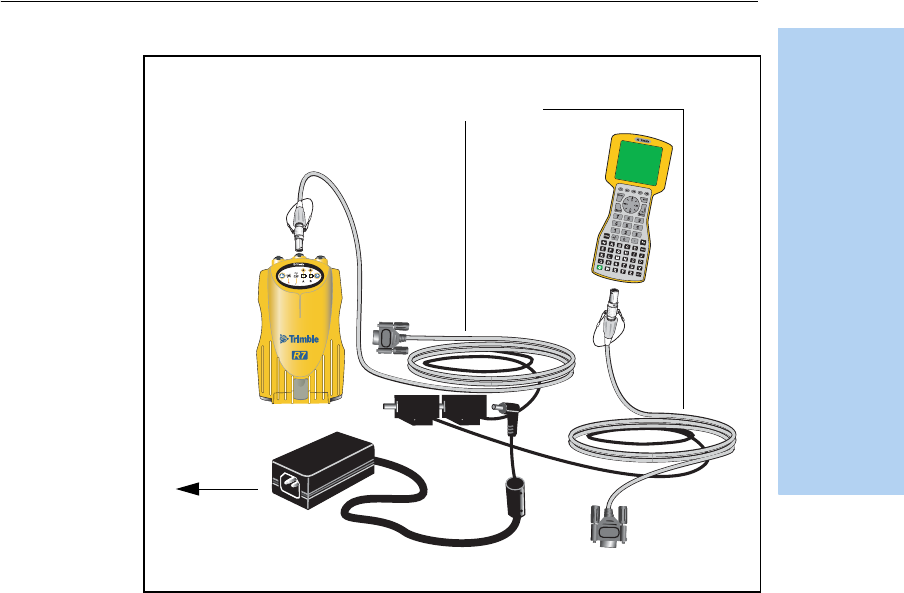
Trimble R7/R8 GPS Receiver User Guide 49
General Operation 4
Trimble R7 GPS Receiver Operation
Figure 4.3 Charging receiver and TSCe batteries
47.3 Power output
If the receiver is being supplied with power from an external source,
power is automatically output on Port 1. The output voltage is
approximately 0.5 V less than the input voltage. Port 1 outputs a
maximum voltage of 20 V, even if the input voltage is higher.
You can use GPS Configurator or Trimble Survey Controller software to
enable power output on Port 3. Port 3 can be enabled for power output
regardless of whether power is supplied internally or externally.
23
To AC
Power/serial data cables
power supply

4 General Operation
50 Trimble R7/R8 GPS Receiver User Guide
Trimble R7 GPS Receiver Operation
On Port 3, the output voltage is approximately 0.5 V less than the input
voltage. For example, if power is being supplied from the internal
Lithium-ion batteries, the maximum battery voltage is 8.4 V, so the
maximum output voltage is 7.9 V.
Note – When you start a survey using the Trimble Survey Controller
software, and you are using an external radio, the software automatically
enables power output on Port 3.
47.4 Firmware
A receiver’s firmware is the program inside the receiver that makes the
receiver run and controls the hardware. When you need to upgrade the
firmware for your Trimble R7 receiver, Trimble recommends that you
use the WinFlash software. For more information, see The WinFlash
Software, page 69.
CWARNING – Upgrading the firmware deletes all application files on the
Trimble R7 receiver.
An alternative method of upgrading your firmware is to copy the .elf file
directly to the CompactFlash card from your computer:
1. Connect the CompactFlash card to your desktop computer.
2. Using Windows Explorer, copy the .elf file from your computer to
the CompactFlash card.
3. Disconnect the CompactFlash card from your computer and
insert it into the receiver.
4. Turn the receiver off.
5. Hold down [D] and press [P].
The receiver starts up in Monitor mode, automatically detects
the newer version of the firmware, and installs it. In Monitor
mode, the red SV Tracking LED is lit solidly and the yellow
Logging/Memory LED flashes slowly.
The upgrade takes about two minutes. Once the upgrade
procedure is complete, the receiver restarts automatically.

5 Configuration
52 Trimble R7/R8 GPS Receiver User Guide
Trimble R7 GPS Receiver Operation
The Trimble R7 receiver has no controls for changing settings. To
configure the receiver, use external software, such as GPS Configurator
or Trimble Survey Controller.
To configure the Trimble R7 receiver, do one of the following:
•Configure the receiver in real time
•Apply the settings in an application file
This chapter provides a brief overview of each of these methods, and
describes the contents and use of application files.
5.1 Configuring the Receiver in Real Time
The GPS Configurator and Trimble Survey Controller software support
real-time configuration of the Trimble R7 receiver.
When you configure the receiver in real time, you use one of these
software applications to specify which settings you want to change.
When you apply the changes, the receiver settings change immediately.
Any changes that you apply to the receiver are reflected in the Current
application file, which is always present in the receiver. The Current
application file always records the most recent configuration, so if you
apply further changes (either in real time or using an application file)
the Current file is updated and there is no record of the changes that
you applied originally.
For more information on configuring the receiver in real time, see
Chapter 7, Software Utilities.

Trimble R7/R8 GPS Receiver User Guide 53
Configuration 5
Trimble R7 GPS Receiver Operation
5.2 Configuring the Receiver Using Application
Files
An application file contains information for configuring a receiver. To
configure a receiver using an application file, you need to create the
application file, transfer it to the receiver, and then apply the file
settings. The GPS Configurator software does this for you automatically
when you work with configuration files.
For more information on applying application files, see Chapter 7,
Software Utilities.
5.3 Application Files
An application file is organized into records. Each record stores
configuration information for a particular area of receiver operation.
Application files can include the following records:
•File Storage
•General Controls
•Serial Port Baud/Format
•Reference Position
•Logging Rate
•SV Enable/Disable
•Output Message
•Antenna
•Device Control
•Static/Kinematic
•Input Message
•Timed Activation

5 Configuration
54 Trimble R7/R8 GPS Receiver User Guide
Trimble R7 GPS Receiver Operation
An application file does not have to contain all of these records. When
you apply an application file, any option that is not included in the
records in the file remains at its current setting. For example, if you
apply an application file that only specifies the elevation mask to use,
all other settings remain as they were before the application file was
applied.
You can store up to twenty different application files in battery-backed
memory on the receiver. You can apply an application file’s settings at
the time it is transferred to the receiver, or at any time afterwards.
53.1 Special application files
The Trimble R7 receiver has three special application files, which
control important aspects of the receiver’s configuration.
Default application file
The default application file (Default.cfg) contains the original receiver
configuration, and cannot be changed. This file configures the receiver
after it is reset. To reset the receiver, hold down [P] for at least 15
seconds, or use the reset option in the GPS Configurator software.
For more information, see Default Settings, page 80.
Although you cannot change or delete the default application file, you
can use a power up application file to override any or all of the default
settings.
Current application file
The current application file (Current.cfg) reflects the current receiver
configuration. Whenever you change the receiver’s configuration,
either in real time or by applying an application file, the current file
changes to match the new configuration.
You cannot delete the current file or change it directly, but every
change to the receiver’s current configuration is applied to the current
file as well.

Trimble R7/R8 GPS Receiver User Guide 55
Configuration 5
Trimble R7 GPS Receiver Operation
When you turn off the receiver then turn it on again, all the settings
from the current application file are applied, so you do not lose any
changes that you have made. The only exceptions are the following
logging parameters:
•Logging rate
•Position rate
•Elevation mask
These parameters are always reset to the factory default values
whenever the receiver is switched off.
Power Up application file
the power up application file (power_up.cfg) is optional. if a power up
file is present, its settings are applied whenever the receiver is turned
on.
In this file, you can specify that the receiver is reset to defaults before
the power up settings are applied. This ensures that restarting the
receiver always results in the same configuration. This method is useful
for defining “default” settings for the receiver that differ from those in
the default file, which cannot be changed.
Alternatively, you can specify that the power up settings are applied
immediately after the current application file’s settings have been
applied. Restarting the receiver results in a configuration that uses your
default settings for the options you define in the power up file, but the
current settings for all other options.
By default, there is no power_up application file on the receiver. To use
a power up application file, you must create and save a power_up
application file in the GPS Configurator software. If you save this file to
disk, the file is called power_up.cfg. the extension .cfg is used by
convention to identify application files on the office computer. when
you transfer this file to the receiver, the file is saved on the receiver as
power_up, and becomes the new power up file.

5 Configuration
56 Trimble R7/R8 GPS Receiver User Guide
Trimble R7 GPS Receiver Operation
The power up file is the only special application file that you can
overwrite or delete from the receiver.
53.2 Timed application files
A timed application file contains a Timed Activation record which
specifies when this file is to be applied. The main use of a timed
application file is to automatically start or stop logging at a predefined
time.
The Timed Activation record specifies:
•the UTC date and time when the application file is to be applied
for the first time
•the interval at which the file is to be reapplied
If you do not specify a repeat interval, the settings are applied only
once, at the specified time. If the file specifies a repeat interval, the file’s
settings are reapplied at the specified interval until the file is
deactivated.
Note – If the receiver is logging continuously, the current logging takes
precedence over any timed application file stored in the receiver.
Defining timed application files
To send timed application files to a Trimble R7 receiver, set up
scheduled survey sessions in the GPS Configurator software. You can
define multiple sessions, each specifying:
•basic logging parameters (data logging rate, position logging
rate, and elevation mask)
•a starting time
•a duration

Trimble R7/R8 GPS Receiver User Guide 57
Configuration 5
Trimble R7 GPS Receiver Operation
When you apply the current settings in the GPS Configurator software,
each defined survey session is sent to the Trimble R7 receiver as a pair
of timed application files: the first includes the logging settings and
start time, and the second contains settings that stop logging at the end
time (which is calculated automatically from the duration you specify).
For more information on scheduled survey sessions, refer to the GPS
Configurator Help.
The receiver can store up to 20 application files, so you can define a
maximum of 10 scheduled survey sessions (10 pairs of start/stop timed
application files).
Sleep mode
Whenever you press [P] to turn off the Trimble R7 receiver, the receiver
checks for a timed application file that is due to be activated in the
future. If one exists, the receiver goes into Sleep mode instead of
turning off.
In Sleep mode, the yellow Logging/Memory LED flashes every three
seconds. The receiver wakes up five minutes before the scheduled
activation time, so that it is ready to begin logging at the scheduled
time.
53.3 Applying application files
An application file’s settings do not affect the receiver’s configuration
until you apply the application file. You can do this at the same time
that you save the file. Alternatively, save the file on the computer or in
the receiver, then open it later and apply its settings.
Note – If the application file is a timed file, its settings do not take effect as
soon as you apply the file, but at the time that the file specifies for its
activation.

5 Configuration
58 Trimble R7/R8 GPS Receiver User Guide
Trimble R7 GPS Receiver Operation
53.4 Storing application files
You can store application files that you create in the GPS Configurator
software on the receiver and on the computer. For example, each file
can represent a different user sharing the same receiver, or a particular
mode of operation or survey style. Saving application files on your
computer as well as in your receiver is optional, but it is useful because:
•it gives you a permanent copy of the settings you have sent to a
receiver, for audit or your own reference.
• you can use the same file to configure multiple receivers
identically.
•you can use an existing application file as a template for creating
other application files with similar settings.
53.5 Naming application files
The application filename in the office computer and in the receiver is
always the same. This makes it easier to recognize and keep track of
your application files.
When you change the name of the application file in the receiver, this
changes the application filename on your computer. When you transfer
an application file from the receiver and save it to the computer, the
system renames the file to match the internal receiver file. However, if
you use Windows Explorer, for example, to change the .cfg filename on
the computer, this does not change the internal receiver filename. This
means that the GPS receiver does not recognize the change to the
filename on the computer.

6 Transferring Data
60 Trimble R7/R8 GPS Receiver User Guide
Trimble R7 GPS Receiver Operation
The Trimble R7 receiver keeps satellite measurements and other data
in files stored on a CompactFlash card. These files cannot be processed
until you transfer them to your office computer.
Note – The receiver supports a maximum of 512 files on the CompactFlash
cards.
On returning to the office after completing a survey, transfer the field
data to a computer that has the Trimble Geomatics Office™ software
installed. You can then process the survey data in the Trimble
Geomatics Office software to produce baselines and coordinates.
6.1 Connecting to the Office Computer
The Trimble R7 receiver has three serial (COM) ports and one USB port
for connection to the office computer. A USB connection is up to ten
times faster than normal serial communications.
Use the standard power/serial data cable to connect the receiver to the
computer, as shown in Figure 6.1.
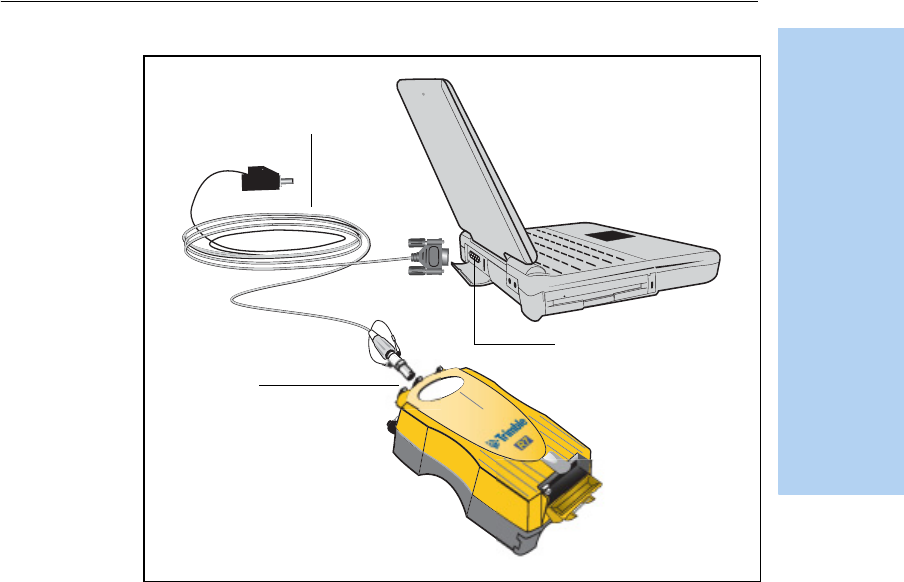
Trimble R7/R8 GPS Receiver User Guide 61
Transferring Data 6
Trimble R7 GPS Receiver Operation
Figure 6.1 Connecting the Trimble R7 receiver to a computer for serial
data transfer
Use the USB cable to connect the receiver to the computer, as shown in
Figure 6.2.
Power/serial data
Port 2
Serial (COM) port
cable
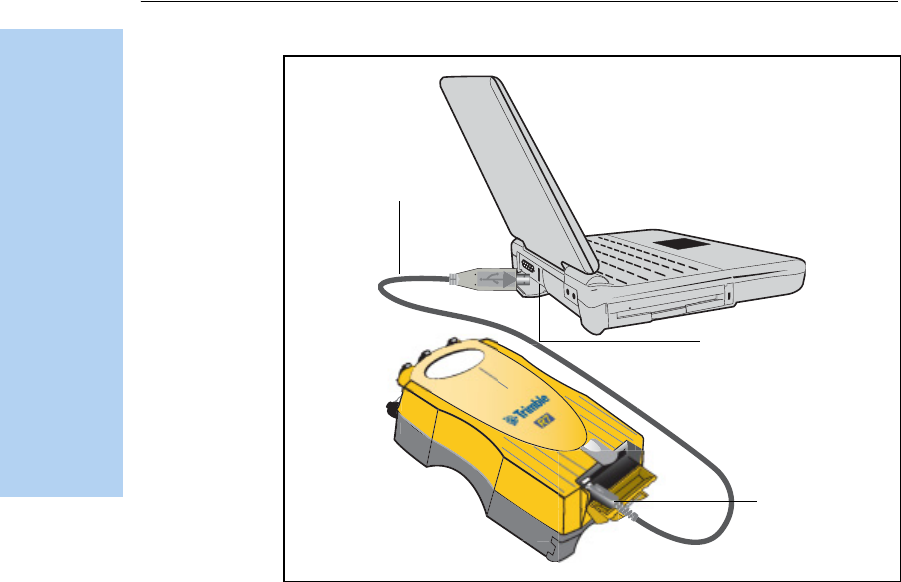
6 Transferring Data
62 Trimble R7/R8 GPS Receiver User Guide
Trimble R7 GPS Receiver Operation
Figure 6.2 Connecting the Trimble R7 receiver to a computer for USB
data transfer
Note – When the receiver is connected to a USB port on a computer, it is
treated as a peripheral device of the computer. If the receiver is unplugged
or turned off, a warning message appears on the computer.
6.2 Transferring Data
Transfer the data files to the computer using the Trimble Data Transfer
utility. You can run this utility as a standalone program or from within
the Trimble Geomatics Office software. For more information, refer to
the Data Transfer Help.
USB cable
USB port
USB port

Trimble R7/R8 GPS Receiver User Guide 63
Transferring Data 6
Trimble R7 GPS Receiver Operation
Note – When you connect to a receiver in the Data Transfer utility, you
must use a GPS Receiver (R/5000 Series) device definition. If you use a GPS
Receiver (4000 Series) device definition, the Data Transfer utility will be
unable to establish communication with the receiver.
When transfer is complete, the Data Transfer utility automatically
converts the file to the DAT format. If you are using Data Transfer from
within the Trimble Geomatics Office software, the Check-in dialog
appears. For more information, refer to the Trimble Geomatics Office
User Guide.
Note – A file in DAT format is approximately six times the size of the
corresponding file in the Trimble R7 receiver internal format. Before
transferring files, make sure that there is enough space on your computer.
6.3 Transferring Files Directly from a
CompactFlash Card
In a Trimble R7 receiver, all data is stored on an internal CompactFlash
card. There are two ways to transfer files between the receiver and the
office computer:
• Connect the receiver to the office computer and use the Data
Transfer utility to transfer files.
• Remove the CompactFlash card from the receiver and connect it
directly to your office computer, where it functions like a normal
disk drive. Use Windows Explorer to transfer files.
When you use the Data Transfer utility to transfer data files from the
CompactFlash card while it is still inserted in the receiver, the Data
Transfer utility converts the raw receiver data (.T01) files you select into
the Trimble DAT file format.
However, if you connect the CompactFlash card to your computer and
then copy or move files to your computer, it treats the card like any
other disk drive, and transfers the files without converting them. You
need to convert these raw receiver files to DAT format files before you
can use them on your office computer.
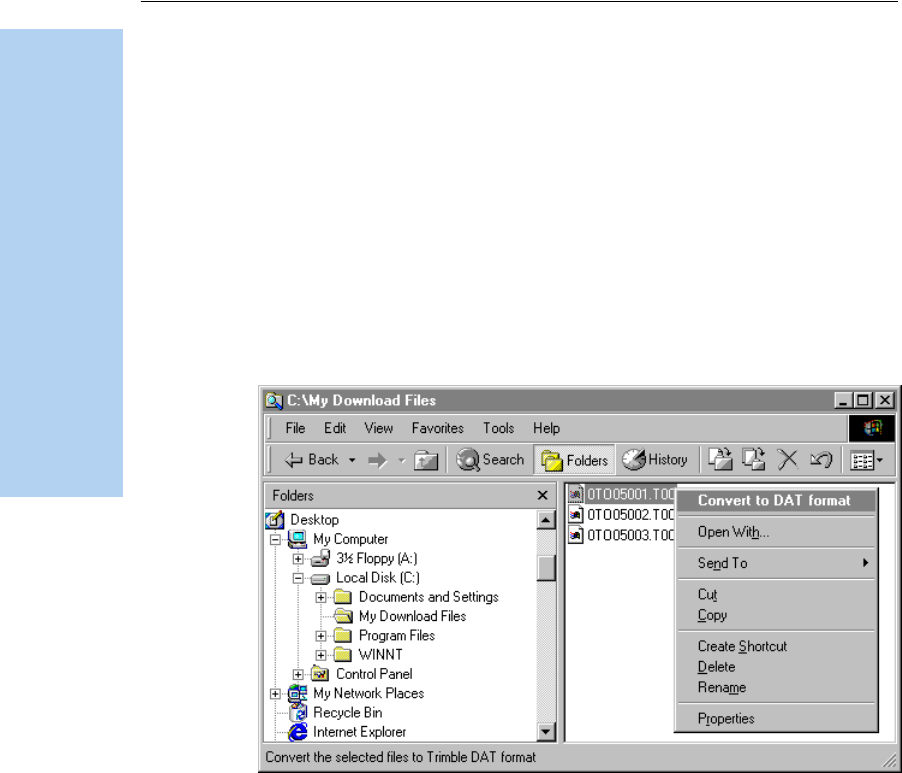
6 Transferring Data
64 Trimble R7/R8 GPS Receiver User Guide
Trimble R7 GPS Receiver Operation
You can convert receiver data files by using a Windows Explorer
extension which is installed on your computer when you install the
Data Transfer utility.
Note – Although this extension is only available if you have the Data
Transfer utility installed, you do not have to run the Data Transfer utility
to use it.
To convert a .T01 file on your office computer into the DAT format:
1. On your office computer, open Windows Explorer and navigate
to the location of the .T01 file.
2. Right-click the file, and from the menu that appears select
Convert to DAT format:
The DAT File Conversion dialog appears while the file is
converted. When the dialog disappears, the file conversion is
complete.
A new file with the same filename but a .dat extension appears in
the same folder as the .T01 file.

Trimble R7/R8 GPS Receiver User Guide 65
Transferring Data 6
Trimble R7 GPS Receiver Operation
6.1 Deleting Files in the Receiver
You can delete files stored in the receiver at any time. Do one of the
following:
• Use the Data Transfer utility in the Trimble Geomatics Office
software.
• Use the TSCe controller.
• Turn on the receiver and then hold down [P] for 30 seconds.
When you use this method, all data is deleted, and the
CompactFlash card is reformatted.
• Use the GPS Configurator software.
6.2 Supported File Types
Table 6.1 shows the file types that you can transfer to or from a
Trimble R7 receiver, and the software or utility that you must use to
transfer each file type.
Note – The Trimble R7 receiver supports a maximum of 512 files on the
CompactFlash card. Files stored on the compact flash must be 8.3 format.
The Trimble R7 receiver does not support extended file names.
Table 6.1 Supported file types
File Type Extensions Transfer from
Trimble R7
receiver?
Transfer to
Trimble R7
receiver?
Software
Ephemeris .eph Yes No Data Transfer
Raw observations .T01, .dat Yes No Data Transfer
Receiver firmware files .elf No Yes WinFlash
Application files .cfg Yes Yes GPS
Configurator

6 Transferring Data
66 Trimble R7/R8 GPS Receiver User Guide
Trimble R7 GPS Receiver Operation

7 Software Utilities
68 Trimble R7/R8 GPS Receiver User Guide
Trimble R7 GPS Receiver Operation
This chapter provides information on the software utilities that you can
use with the Trimble R7 receiver.
7.1 The GPS Configurator Software
GPS Configurator is office software that configures selected Trimble
GPS receivers.
This software enables you to:
•edit and save configuration files to the receiver and the
computer
•check current receiver settings and operation
•change receiver settings in real time
71.1 Installing the GPS Configurator software
A copy of the GPS Configurator software is included on the Trimble R7,
Trimble R8, 5700, and 5800 GPS Receivers CD.
1. Insert the disk into the CD drive on your office computer.
2. From the main menu, select Install individual software packages.
3. Select Install GPS Configurator vX.XX.
4. Follow the on-screen instructions.
70.1 Configuring the Trimble R7 receiver using the GPS
Configurator software
1. Connect Port 1 or 2 on the receiver to a serial (COM) port on the
computer and then apply power.
2. To start the GPS Configurator software, click and then
select Programs /Trimble /GPS Configurator /GPS Configurator.
3. In the Device Type dialog, select Trimble R7.

Trimble R7/R8 GPS Receiver User Guide 69
Software Utilities 7
Trimble R7 GPS Receiver Operation
The software automatically establishes a connection with the
receiver.
4. Make appropriate selections for your required receiver settings.
For more information, refer to the GPS Configurator Help.
5. Click Apply.
The settings in the GPS Configurator software are applied to the
receiver.
7.1 The WinFlash Software
the WinFlash software communicates with Trimble products to
perform various functions including:
•installing software, firmware, and option upgrades
•running diagnostics (for example, retrieving configuration
information)
•configuring radios
For more information, online help is also available when using the
WinFlash software.
Note – The WinFlash software runs on Microsoft® Windows® 95, 98, 2000,
Me, XP, or Windows NT® operating systems.
71.1 Installing the WinFlash software
Install the WinFlash software from the Trimble R7, Trimble R8, 5700,
and 5800 GPS Receivers CD:
1. Insert the disk into the CD drive on your computer.
2. From the main menu, select Install individual software packages.
3. Select Install WinFlash vX.XX with Trimble R7 drivers and
firmware and then follow the on-screen instructions.
Alternatively, install the WinFlash software from the Trimble website.

7 Software Utilities
70 Trimble R7/R8 GPS Receiver User Guide
Trimble R7 GPS Receiver Operation
70.1 Upgrading firmware
Your Trimble R7 receiver is supplied with the latest version of receiver
firmware installed. If a later version becomes available, upgrade the
firmware installed on your receiver.
The WinFlash software guides you through the firmware upgrade
process, as described below. For more information, refer to the
WinFlash Help.
To upgrade the Trimble R7 receiver firmware:
1. Start the WinFlash software. The Device Configuration screen
appears.
2. From the Device type list, select Trimble R7 Receiver.
3. From the PC serial port field, select the serial (COM) port on the
computer that the receiver is connected to.
4. Click Next.
The Operation Selection screen appears. The Operations list
shows all of the supported operations for the selected device. A
description of the selected operation is shown in the Description
field.
5. Select GPS software upgrade and then click Next.
The GPS Software Selection dialog appears. This screen prompts
you to select the software that you want to install on the
Trimble R7 receiver.
6. Select the latest version from the Available Software list and then
click Next.
The Settings Review dialog appears. This screen prompts you to
connect the receiver, suggests a connection method, and then
lists the receiver configuration and selected operation.

Trimble R7/R8 GPS Receiver User Guide 71
Software Utilities 7
Trimble R7 GPS Receiver Operation
7. If all is correct, click Finish.
Based on the selections shown above, the Software Upgrade
window appears and shows the status of the operation (for
example, Establishing communication with the Trimble R7.
Please wait.).
8. Click OK.
The Software Upgrade window appears again and states that the
operation was completed successfully.
9. Click Menu to select another operation, or click Exit to quit
WinFlash.
10. If you click Exit, another screen appears asking you to confirm
that you want to quit. Click OK.
70.1 Adding frequencies for the 450 MHz internal radio
If your receiver has the optional internal radio installed, you can use the
WinFlash software to add receiving frequencies to the default list.
1. Start the WinFlash software. The Device Configuration dialog
appears.
2. From the Device type list, select Trimble R7 Receiver.
3. From the PC serial port field, select the serial (COM) port on the
computer that the receiver is connected to.
4. Click Next.
The Operation Selection screen appears. The Operations list
shows all of the supported operations for the selected device. A
description of the selected operation is shown in the Description
field.
5. Select Configure Radio and then click Next.
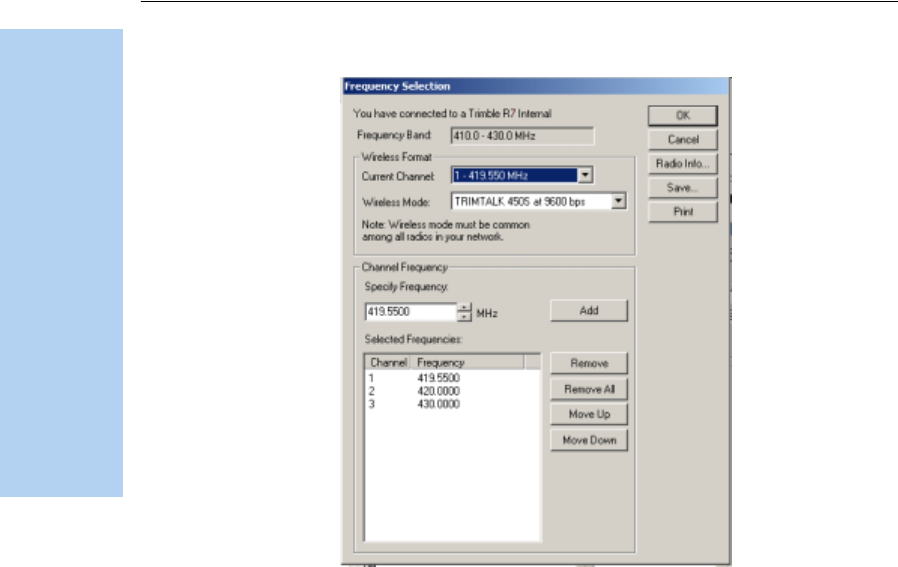
7 Software Utilities
72 Trimble R7/R8 GPS Receiver User Guide
Trimble R7 GPS Receiver Operation
The Frequency Selection dialog appears:
6. In the Wireless Format group, select the appropriate channel and
wireless mode. The Wireless Mode must be the same for all radios
in your network.
7. In the Specify Frequency field, enter the frequency you require.
8. Click Add. The new frequency appears in the Selected
Frequencies list.
Note – The frequencies that you program must conform to the channel
spacing and minimum tuning requirements for the radio. To view this
information, click Radio Info. You may select either 12.5 or 25 kHz
channel spacing. All radios in your network must use the same channel
spacing.
9. When you have configured all the frequencies you require, click
OK. The WinFlash software updates the receiver radio
frequencies and then restarts the receiver.

Trimble R7/R8 GPS Receiver User Guide 73
Software Utilities 7
Trimble R7 GPS Receiver Operation
70.1 Configuring the internal 900 MHz radio setup
Use one of the following:
•Trimble Survey Controller software running on a Trimble
controller
•The WinFlash software (provided on the Trimble R7, Trimble R8,
5700, and 5800 GPS Receivers CD)
The internal radio has 40 selectable networks. You must choose the
same network that is configured in the base radio you want to receive
from.
Configuring the radio network using the Trimble
Survey Controller software
1. Connect the data/power cable to the controller and the receiver
and then turn on the controller. The receiver starts
automatically.
2. From the main menu on the controller, select Configuration.
3. In the dialog that appears, select Survey styles and then select
RTK from the Type field.
4. Select Rover radio and then select Trimble Internal from the Type
field select.
5. Tap the ! softkey.
6. Once connected, in the Network number field enter the number
of the network set on your base radio.
Note – The Base Radio Mode field is not used here.
7. Tap the E softkey to complete configuration.

7 Software Utilities
74 Trimble R7/R8 GPS Receiver User Guide
Trimble R7 GPS Receiver Operation
Configuring the radio network using the WinFlash
software
1. Connect the data/power cable to Port 1 on the receiver.
2. Connect the female DE-9 connector on the other end of the
data/power cable to a serial (COM) port on the computer.
3. Start the WinFlash software. The Device Configuration dialog
appears.
4. From the Device type list, select Trimble R7 Receiver.
5. From the PC serial port field, select the serial port on the
computer that the receiver is connected to and click Next.
6. From the Operation selection dialog, select Configure radio and
click Next.
7. Confirm that your current settings are correct and click Finish.
The Configure 900MHz radio dialog appears.
8. In the Network number field, select the same network that is set
on your base radio.
9. In the Country setting field, select one of the following (according
to how your base radio was shipped):
– Your country (if available). This sets the radio to the a specific
frequency range being transmitted by the base radio.
– A single frequency. This limits the frequencies used to those
authorized in your particular country.
10. Click OK.
The WinFlash software updates the radio settings and then restarts the
receiver.

8 Specifications
76 Trimble R7/R8 GPS Receiver User Guide
Trimble R7 GPS Receiver Operation
This chapter lists the specifications of the Trimble R7 receiver.
8.1 Physical Specifications
Table 8.1 lists physical specifications for the Trimble R7. The
temperature rating of the receiver applies only when all doors on the
receiver are closed.
Table 8.1 Physical specifications
Feature Specification
Size 13.5 cm W x 8.5 cm H x 24 cm L
(5.3 in. W x 3.4 in. H x 9.5 in. L)
Weight
(with 2 batteries inserted)
1.4 kg (3.0 lb)
Battery life
(at 20 °C)
RTK with internal radio: 3.5 hours
No internal radio: 5 hours
Power input 11–28 V DC
Operating temperature –40 °C to +65 °C (–40 °F to +149 °F)a
aThe USB port only operates when the temperature is above 0 °C (32 °F). The
internal batteries only charge when the temperature is in the range 0 °C to 40 °C
(32 °F to 104 °F)
Storage temperature –40 °C to +80 °C (–40 °F to +176 °F)
Humidity 100% condensing, unit fully sealed
Casing Dust-proof, shock- and vibration-resistant

Trimble R7/R8 GPS Receiver User Guide 77
Specifications 8
Trimble R7 GPS Receiver Operation
8.2 Positioning Specifications
Table 8.2 lists positioning specifications for the Trimble R7.
8.3 Technical Specifications
Table 8.3 lists technical specifications for the Trimble R7.
Table 8.2 Positioning specifications
Positioning Mode Horizontal Accuracy
(RMS)
Vertical Accuracy
(RMS)
RTK (OTF) Synchronized 1 cm + 1 ppm
(× baseline length)
2cm + 1ppm
(× baseline length)
Low Latency 2 cm + 2 ppm
(× baseline length)a
aDepends on radio link latency.
3cm + 2ppm
(× baseline length)a
L1 C/A Code
Phase
Synchronized/
Low Latency
.25 m + 1 ppm RMS .50 m + 1 ppm RMS
Static/
FastStatic
N/A 5 mm + 0.5 ppm
(× baseline length)
5 mm + 1 ppm
(× baseline length)
WAAS N/A Less than 5 mb
b3D RMS values depend on WAAS system performance.
Less than 5 mb
Table 8.3 Technical specifications
Feature Specification
Tracking 24 Channels L1 C/A Code, L2C, L1/L2 Full Cycle Carrier,
WAAS/EGNOS support
Fully operational during P-code encryption
WAAS satellite tracking
Signal processing Maxwell V architecture
Very low-noise C/A code processing
Multipath suppression
Start-up Cold start: < 60 seconds from power on
Warm start: < 30 seconds with recent ephemeris

8 Specifications
78 Trimble R7/R8 GPS Receiver User Guide
Trimble R7 GPS Receiver Operation
Initialization Automatic while moving or static
Minimum
initialization time
10 sec + 0.5 × baseline length (km)
Communications Three RS-232 serial ports (Port 1, Port 2, and Port 3)
Baud rates up to 115,200 bps
RTS/CTS flow control negotiation supported on Port 3
only
One USB port (download only)
Configuration Via user-definable application files or GPS
Configurator
Output formats NMEA-0183: AVR; GGA; GSA; GST; GSV; PTNL,GGK;
PTNL,GGK_SYNC; HDT; PTNL,PJK; PTNL,PJT; ROT
PTNL,VGK; VHD; VTG; ZDA
GSOF (Trimble Binary Streamed Output)
1PPS
RT17
Table 8.3 Technical specifications (continued)
Feature Specification

9 Default Settings
80 Trimble R7/R8 GPS Receiver User Guide
Trimble R7 GPS Receiver Operation
All Trimble R7 receiver settings are stored in application files. The
default application file, default.cfg, is stored permanently in the
receiver, and contains the factory default settings for the Trimble R7
receiver. Whenever the receiver is reset to its factory defaults, the
current settings (stored in the current application file, current.cfg) are
reset to the values in the default application file.
You cannot modify the default application file. however, if there is a
power up application file (power_up.cfg) in the receiver, the settings in
this file can be applied immediately after the default application file,
overriding the factory defaults.
For more information, see Application Files, page 53.
9.1 Default Settings
Table 9.1 shows the default settings for the Trimble R7 receiver, as
defined in the default application file.
Table 9.1 Default settings
Function Factory Default
SV Enable All SVs enabled
General Controls: Elevation mask 13°
PDOP mask 7
RTK positioning mode Low Latency
Motion Kinematic
Power Output 3 Disabled
1PPS time tags Off
ASCII time tags Off
Serial Port 1: Baud rate 38400
Format 8-None-1
Flow control None

Trimble R7/R8 GPS Receiver User Guide 81
Default Settings 9
Trimble R7 GPS Receiver Operation
Serial Port 2: Baud rate 38400
Format 8-None-1
Serial Port 3: Baud rate 38400
Format 8-None-1
Flow control None
Input Setup: Station Any
NMEA/ASCII (all messages) All Ports Off
Streamed output All Types Off
Offset = 00
RT17/Binary All Ports Off
CMR output [Static] CMR: cref ID 0000
RTCM output RTCM: Type 1 ID 0000
Reference position: Latitude 0°
Longitude 0°
Altitude 0.00 m HAE
Antenna: Type Unknown external
Height (true vertical) 0.00 m
Group All
Measurement method Bottom of antenna mount
Logging rate 15 sec
Position rate 5 min
Measurement rate 10 Hz
Table 9.1 Default settings (continued)
Function Factory Default

9 Default Settings
82 Trimble R7/R8 GPS Receiver User Guide
Trimble R7 GPS Receiver Operation
9.2 Resetting to Factory Defaults
To reset the receiver to its factory defaults, do one of the following:
•On the receiver, press and hold down [P] for 15 seconds.
•In the GPS Configurator software, select Connect to Receiver and
then click Reset receiver in the General tab.
9.3 Examples
The following examples show how the Trimble R7 receiver uses the
default settings and special application files in various situations.
93.1 Default behavior
The factory defaults are applied whenever you start the receiver. If a
Power Up file is present in the receiver, its settings are applied
immediately after the default settings, so you can use a Power Up file to
define your own set of defaults.
When you turn the receiver on
and …
then logging settings
are …
and logging …
it is the first time that the receiver has
been used
the factory defaults does not begin
automatically
you have reset the receiver to its factory
defaults
the factory defaults, or those
in the Power Up filea
aA factory default setting is only used if the setting is not defined in the Power Up file.
does not begin
automatically
you have performed a full reset the factory defaults, because
resetting deletes any Power
Up file
does not begin
automatically

Trimble R7/R8 GPS Receiver User Guide 83
Default Settings 9
Trimble R7 GPS Receiver Operation
93.2 Power up settings
When you turn the receiver off, any changes that you have made to
logging settings are lost and these settings are returned to the factory
defaults. Other settings remain as defined in the Current file. The next
time you turn on the receiver, the receiver checks for a power up file
and, if one is present, applies the settings in this file.
93.3 Logging after power loss
If the Trimble R7 receiver loses power unexpectedly, when power is
restored the receiver tries to return to the state it was in immediately
before the power loss. The receiver does not reset itself to defaults or
apply any Power Up settings. If the receiver was logging when power
was lost unexpectedly, it resumes logging when power is restored.
When you use [P] to turn the receiver
off then on again and …
then logging
settings are …
and all other
settings are …
you changed the receiver settings by
applying an application file
the factory defaults the last settings used
you changed the receiver settings using
configuration software
the factory defaults the last settings used
there is a Power Up application file in the
receiver
the factory defaults,
or those in the Power
Up filea
aA factory default setting is used only if the setting is not defined in the Power Up file.
the last settings used, or
those in the Power Up
filea

9 Default Settings
84 Trimble R7/R8 GPS Receiver User Guide
Trimble R7 GPS Receiver Operation
However, when you turn off the receiver using [P], the receiver behaves
as if you pressed [D] to stop logging before you pressed [P]. In this case,
when power is restored normally, logging does not begin until you start
it manually.
93.4 Disabling logging
To disable logging, you can set the receiver’s data logging and position
logging rates to Off. However, if you press [D] while logging is disabled,
the receiver will still log data, using the default logging settings.
93.5 Application files
You can use application files to change the settings in the receiver.
Sending an application file to the receiver does not necessarily apply
the file’s settings; you can apply a file’s settings at any time after sending
it to the receiver. You can also define timed application files. A timed
application file contains receiver settings, but also includes a date and
time when it is automatically activated.
If there is a timed application file on the Trimble R7 receiver, the
receiver automatically applies the file’s settings and begins logging (if
logging settings are included in the file) at the specified time. If the
When the receiver is logging
data and then loses power …
then when
power is
restored, data
logging …
and logging
settings are …
and all other
settings are …
unexpectedly resumes
automatically
the last settings
used
the last settings
used
when you press [P] does not resume the factory
defaults
the last settings
used
When you have disabled logging … then if you press [D] to start logging,
logging settings are …
using the Trimble Survey Controller or GPS
Configurator software
the factory defaults
in the Power Up application file the factory defaults
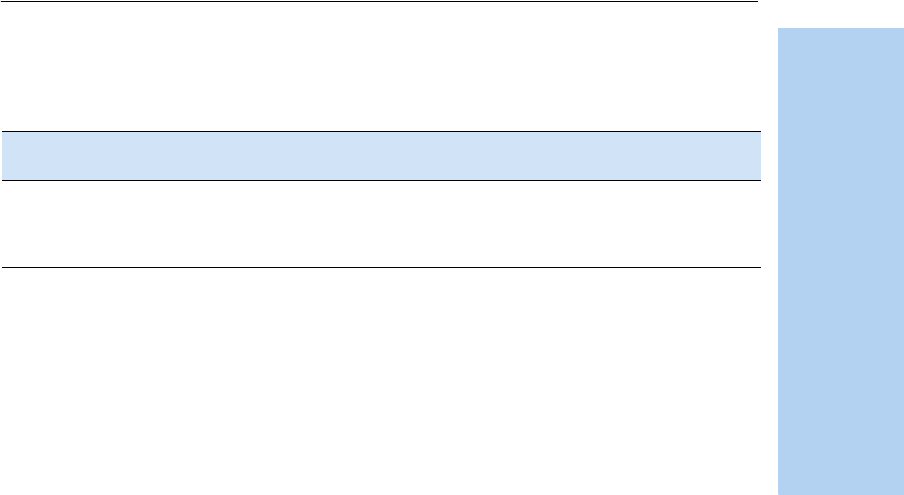
Trimble R7/R8 GPS Receiver User Guide 85
Default Settings 9
Trimble R7 GPS Receiver Operation
receiver is in Sleep mode, it wakes up five minutes before the start time
of the timed application file, and then begins logging, if required, at the
specified start time.
When you send an application file
to the receiver and …
then the receiver settings are changed …
you apply the file’s settings immediately as soon as you send the file to the receiver
you apply the file later as soon as you apply the file
it is a timed application file at the specified activation time

9 Default Settings
86 Trimble R7/R8 GPS Receiver User Guide
Trimble R7 GPS Receiver Operation

10 Cables and Connectors
88 Trimble R7/R8 GPS Receiver User Guide
Trimble R7 GPS Receiver Operation
This chapter provides pinout information for the Trimble R7 receiver
standard and optional cables. This information can be used to build
special cables for connecting the receiver to devices and instruments
not supported by the standard and optional cables.
10.1Port 1, 2, and 3 Connectors
Figure 10.1 shows the location of the receiver serial ports.
Figure 10.1 Trimble R7 receiver serial ports
Figure 10.2 gives pinout requirements for the connector labeled
Port 1. The pin locations for the Port 2 and Port 3 connectors are
identical.
Port 1 Port 2 Port 3
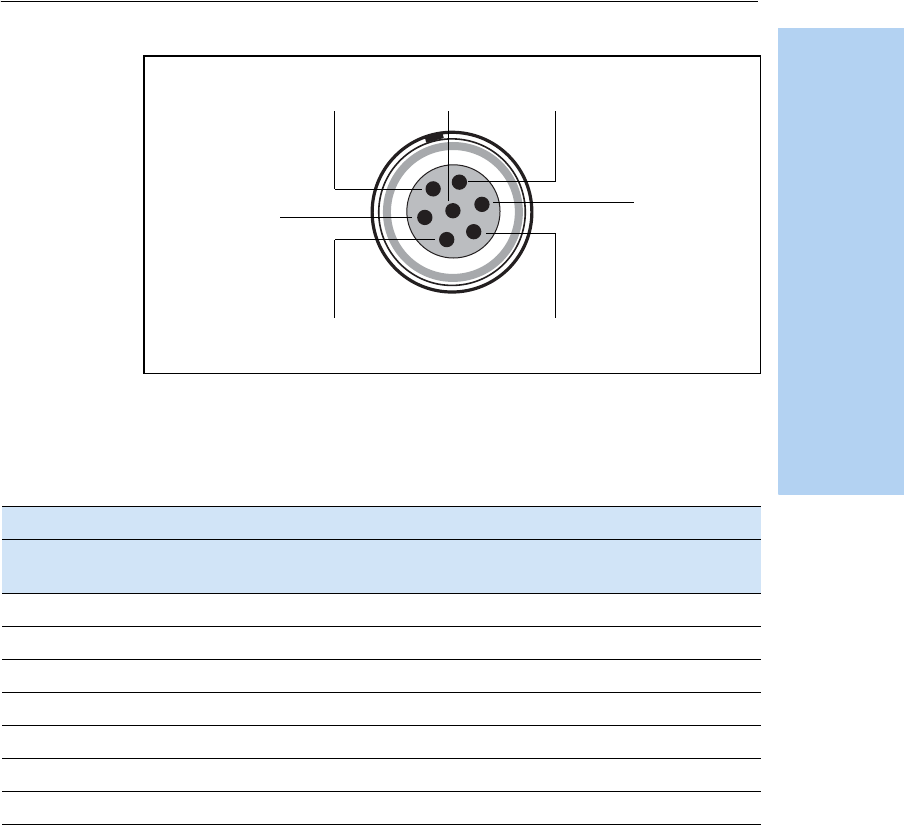
Trimble R7/R8 GPS Receiver User Guide 89
Cables and Connectors 10
Trimble R7 GPS Receiver Operation
Figure 10.2 Pinout connectors
Table 10.1 describes the pinout functionality.
Table 10.1 Trimble R7 receiver port pinouts
Pin Pinout function
Port 1 (TSCe controller,
event, or computer)
Port 2 (Power in,
computer, PPS, or event)
Port 3 (External radio or
power in)
1 Signal GND Signal GND Signal GND
2 GND GND GND
3 TX data out (TXD1) TX data out (TXD2) TX data out (TXD3)
4 RTS1 1PPS RTS3
5 CTS1/Event 2 Event 1 CTS3
6 Power Out (+) Power In (+) Power In/Out (+)
7 Serial data in (RXD1) Serial data in (RXD2) Serial data in (RXD3)
7
1
3
6
4
25
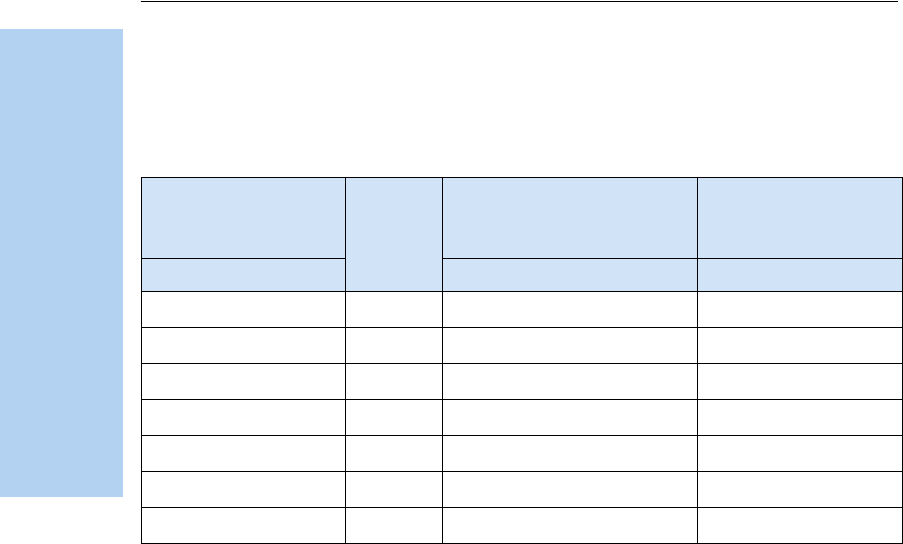
10 Cables and Connectors
90 Trimble R7/R8 GPS Receiver User Guide
Trimble R7 GPS Receiver Operation
10.2Power/serial data cable
Table 10.2 gives pinout information for the power/serial data cable
(PN 32345), which is supplied with the Trimble R7 receiver.
Note – Table 10.2 assumes that the cable is attached to the connector
labeled Port 1 or Port 3.
10.3Event Marker/1PPS Cable
The event marker/1PPS cable shown in Figure 10.3 provides a breakout
box with two BNC ( female) connectors for providing 1PPS input and
event marker output.
Connect a device that accepts 1PPS output pulses to the BNC
connector labeled 1PPS on the breakout box. Connect a device that
outputs event marker pulses to the Trimble R7 receiver, such as a
photogrammetric camera, to the BNC connector labeled Event Marker
on the breakout box.
Table 10.2 Power/serial data cable pinouts
Lemo 0-shell
connector
7 Pin
Direction DE9-F connector
7 Conductors
Power lead
2 Conductors
Pin Function Pin Color Function Color Function
1 Signal ground ↔5 Brown Signal ground
2 GND →Black V-OUT
3TXD →2OrangeTXD
4RTS/TXD →8Blue RTS
5CTS/RXD ←7 Green CTS
6 PWR ← Red Power IN (+)
7RXD ←3 Yellow TXD
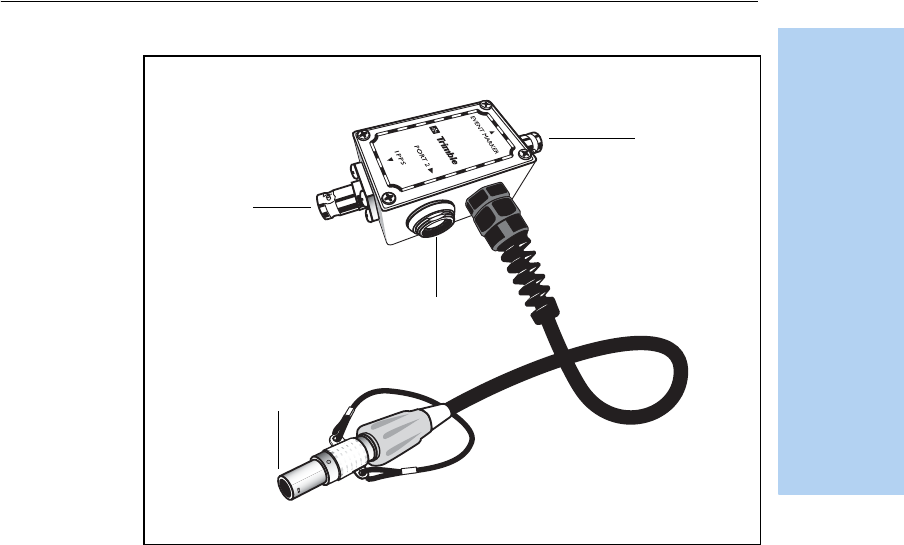
Trimble R7/R8 GPS Receiver User Guide 91
Cables and Connectors 10
Trimble R7 GPS Receiver Operation
Figure 10.3 Event marker/1PPS cable
In addition, the breakout box includes a Lemo 7-pin connector to
extend serial communications and/or power on Port 2. Because the
BNC connectors are used to service the event marker and 1PPS
features, pins 4 (1PPS) and 5 (Event Marker) are inactive on the Lemo
connector.
For Port 2 pinouts, see Port 1, 2, and 3 Connectors, page 88. For more
information on 1PPS input and event marker output, see Chapter 11,
Event Marker Input and 1PPS Output.
P4
P3
P1
P2
(Event marker)
(1PPS out)
(To Port 2)
(Port 2 extension)

10 Cables and Connectors
92 Trimble R7/R8 GPS Receiver User Guide
Trimble R7 GPS Receiver Operation
Table 10.3 gives pinout information for the event marker/1PPS cable
which is supplied with the Trimble R7 receiver. The event marker/1PPS
cable is only used with the Trimble R7 receiver connectors labeled Port
1 ( for event marker output) and Port 2.
10.4GPS Antennas and Cables
The antenna that a receiver uses to collect satellite signals is
sometimes called a GPS antenna to distinguish it from a radio antenna.
Radio antennas are used for communication between receivers and
external networks or systems.
Note – Older models of antennas, such as Choke Ring or Micro-Centered
L1/L2, have different power requirements. The Trimble R7 receiver can
adjust the antenna power output when you designate the appropriate
antenna in the GPS Configurator software. For more information, see
Antennas, page 34.
Table 10.3 Event marker/1PPS cable pinouts
P1: Lemo 7-Pin
Port 2 Trimble R7
receiver
Direction P2: BNC-F
connector
(1PPS)
P3: BNC-F
connector
(Event
marker)
P4: Lemo 7s
Port 2 extension
Pin Trimble R7
receiver
function
Pin Pin Pin Function
1 Signal ground ←1 Signal ground
2 GND →GND GND 2 GND
3 Serial data out
(TXD2)
←3 Serial data in
(TXD2)
41PPS ←Center pin 4 No Connect
5Event Marker ↔Center pin 5 No Connect
6Power IN (+) →6Power IN (+)
7 Serial data in
(RXD2)
←7 Serial data out
(RXD2)

Trimble R7/R8 GPS Receiver User Guide 93
Cables and Connectors 10
Trimble R7 GPS Receiver Operation
Connect the receiver to its GPS antenna using the yellow TNC
connector. Use a coaxial cable with a right-angle TNC plug at the
antenna end.
If the antenna cable length is … use …
up to 15 meters (45 feet) RG-58 cable
up to 30 meters (100 feet) RG-214 cable
over 30 meters (100 feet) one of the following:
• in-line amplifier
• semi-rigid coaxial cable
• a low-loss cable assembly

10 Cables and Connectors
94 Trimble R7/R8 GPS Receiver User Guide
Trimble R7 GPS Receiver Operation

11 Event Marker Input and 1PPS Output
96 Trimble R7/R8 GPS Receiver User Guide
Trimble R7 GPS Receiver Operation
The Trimble R7 receiver can accept event marker input on Port 1 and
Port 2, and can generate 1PPS output on Port 2.
11.1Event Marker Input
Event marker input is used to log a precise GPS time tag whenever an
externally generated pulse, such as one generated at the time of the
shutter closing from a photogrammetric camera, is received.
The event is triggered when the source pulse voltage transitions
between 1.0 V DC and 2.0 V DC in less than 100 nsec. Trimble
recommends that you use TTL level inputs. You can configure the
receiver to recognize either a positive (rising) or negative ( falling)
voltage as the leading edge of a pulse. The accuracy of the associated
time tag recorded for an event is determined by the GPS accuracy
(typically less than 1 µsec.).
The Trimble R7 receiver records each event in the current data file. This
record includes the port on which the event was received.
111.1 Enabling and configuring event marker input
To enable or configure the event marker input function, you need the
GPS Configurator software.
In real time
You can use the GPS Configurator software to configure a Trimble GPS
receiver connected to your office computer. For more information, see
The GPS Configurator Software, page 68, or refer to the GPS
Configurator Help.
To enable event marker input:
1. Connect the computer to the Trimble R7 receiver.
2. Press [P] to turn on the receiver.

Trimble R7/R8 GPS Receiver User Guide 97
Event Marker Input and 1PPS Output 11
Trimble R7 GPS Receiver Operation
3. To start the GPS Configurator software, click , then
select Programs /Trimble /GPS Configurator /GPS Configurator.
The GPS Configurator dialog appears and the software
automatically connects to the Trimble R7 receiver.
4. In the General tab, select the Event marker check box.
5. Select the appropriate option, Positive slope or Negative slope,
depending on the type of pulse the external device uses.
6. Click Apply.
The GPS Configurator software sends the new configuration
information to the receiver, and the receiver starts to accept
event marker input.
7. Click OK to exit the GPS Configurator software.
The software disconnects from the receiver.
11.11PPS Output
The Trimble R7 receiver can output a one pulse per second (1PPS) time
strobe with an associated ASCII time tag output. The pulse is output
through Port 2 of the receiver using the event marker/1PPS cable.
111.1 1PPS pulse definition
The leading edge of the pulse coincides with the beginning of each UTC
second, as shown in Figure 11.1 on page 98. The pulse is driven by an
RS-422 driver between nominal levels of 0 V and 4 V. The leading edge is
positive, rising from 0 V to 4 V.
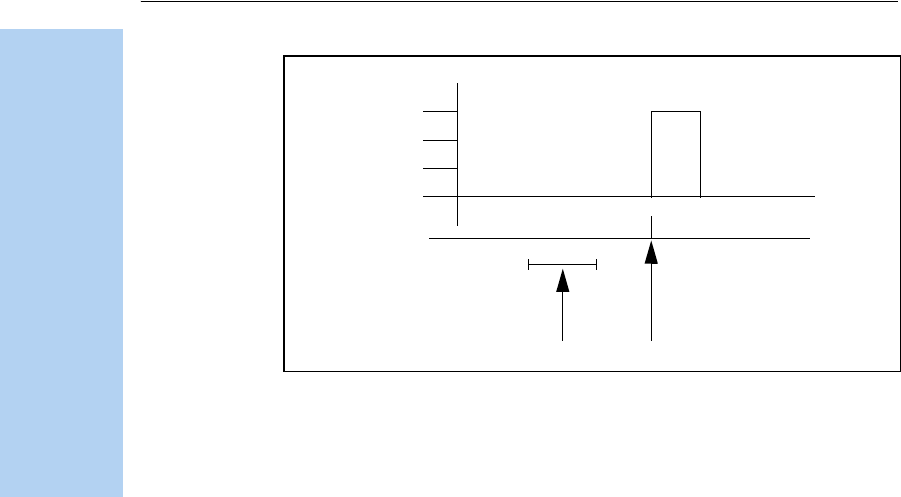
11 Event Marker Input and 1PPS Output
98 Trimble R7/R8 GPS Receiver User Guide
Trimble R7 GPS Receiver Operation
Figure 11.1 Time tag relation to 1PPS wave form
The pulse is approximately 8 µsec wide, with rise and fall times of
about 100 nsec. Resolution is approximately 40 nsec, but several
external factors limit accuracy to approximately ±1 µsec:
• Position errors, especially with user-entered reference. Each
meter of error can result in 3 nsec of error in the 1PPS pulse.
• Antenna cable length. Each meter of cable adds a delay of about
2 nsec to satellite signals, and a corresponding delay in the 1PPS
pulse.
111.2 ASCII time tag definition
Each time tag is output about 0.5 second before the corresponding
pulse, as shown in Figure 11.1. Time tags are in ASCII format on a user-
selected serial port. The format of a time tag is:
UTC yy.mm.dd hh:mm:ss ab
Where:
•UTC is fixed text.
•yy.mm.dd is the year, month, and date.
0V
4V
Seconds
Time tag output here Time tag applies here

Trimble R7/R8 GPS Receiver User Guide 99
Event Marker Input and 1PPS Output 11
Trimble R7 GPS Receiver Operation
•hh:mm:ss is the hour (on a 24-hour clock), minute, and second.
The time is in UTC, not GPS time.
•a is the position-fix type:
1 = 2D Position Fix for E,N only
2 = 3D Position Fix
3 = Single SV Clock-only fix
4 = Automatic Mode
5 = Reference Station Position
6 = Two-Dimensional with Fixed Clock
7 = Overdetermined solution for Clock-only
•b is the number of satellites being tracked: 1 to 9, “:” ( for 10), “;”
(for 11), or “<” (for 12).
• Each time tag is terminated by a carriage return, line feed
sequence.
A typical printout looks like this:
UTC 93.12.21 20:21:16 56
UTC 93.12.21 20:21:17 56
UTC 93.12.21 20:21:18 56
If a and b are ??, the time is based on the receiver clock because the
receiver is not tracking satellites. The receiver clock is less accurate
than time readings extracted from satellite signals.
111.3 Enabling and configuring 1PPS output in real time
To enable or configure the 1PPS output function, you need the GPS
Configurator software.
You can use the GPS Configurator software to configure a Trimble GPS
receiver connected to your office computer. For more information, see
The GPS Configurator Software, page 68, or refer to the GPS
Configurator Help.
1. Connect the computer to the Trimble R7 receiver.
2. Turn on the receiver.

11 Event Marker Input and 1PPS Output
100 Trimble R7/R8 GPS Receiver User Guide
Trimble R7 GPS Receiver Operation
3. To start the GPS Configurator software, click , then
select Programs /Trimble /GPS Configurator /GPS Configurator.
The GPS Configurator dialog appears and the software
automatically connects to the receiver.
4. Select the Serial outputs tab.
5. Select the 1PPS (port 2 only) check box.
6. If you want ASCII time tags enabled, select the check box and
choose an output port.
7. Click Apply.
The GPS Configurator software sends the new configuration
information to the receiver, and the receiver starts to generate
1PPS output on Port 2.
8. Click OK to exit the GPS Configurator software.
The software disconnects from the receiver.

SECTION
II
Trimble R7/R8 GPS Receiver User Guide 101
ITRIMBLE R8 GPS
RECEIVER

102 Trimble R7/R8 GPS Receiver User Guide

12 Overview
104 Trimble R7/R8 GPS Receiver User Guide
Trimble R8 GPS Receiver Operation
This chapter introduces the Trimble R8 GPS receiver. This receiver is
designed for GPS surveying applications. The receiver incorporates a
GPS antenna, receiver, internal radio with a transmit option or an
internal GSM module, and battery in a rugged light-weight unit that is
ideally suited as an all-on-the-pole RTK rover. Three LEDs allow you to
monitor the satellite tracking, radio reception, data logging status, and
power. Bluetooth® wireless technology provides cable-free
communications between receiver and controller. The Trimble R8
receiver provides 24 total channels of L1/L2 satellite tracking, and
supports logging of raw GPS observables to the handheld controller for
post-processed applications.
The receiver is available as a standalone rover, base station, or as part of
the GPS Total Station® system, offering maximum versatility in the
system configuration to meet your specific requirements.
12.1Features
The receiver provides the following features:
•Trimble R-track technology, which allows the receiver to track
the L2 Civil signal (L2C)
•Centimeter-accuracy, real-time positioning with RTK/OTF data,
up to 10 Hz position updates
•Submeter-accuracy, real-time positioning using pseudorange
corrections
•Adaptive dual-frequency RTK engine
•WAAS/EGNOS capability
•Automatic OTF (on-the-fly) initialization while moving
•Single Lithium-ion rechargeable battery
•Cable-free Bluetooth communications with the Trimble
Attachable Control Unit (ACU), or TSCe™ controller with
BlueCap® module

Trimble R7/R8 GPS Receiver User Guide 105
Overview 12
Trimble R8 GPS Receiver Operation
•Two RS-232 serial ports for:
– NMEA output
–RTCM SC-104 input and output
– Trimble Format (CMR & CMR Plus) input and output
•One TNC radio antenna connector
•6 MB internal memory for data storage
•Internal 450 MHz radio with a transmit option or GSM module
12.2Use and Care
The Trimble R8 receiver is designed to withstand the rough treatment
that typically occurs in the field. However, the receiver is a
high-precision electronic instrument and should be treated with
reasonable care.
CWARNING – Operating or storing the Trimble R8 receiver outside the
specified temperature range can damage it. For more information, see
Chapter 17, Specifications.
High-power signals from a nearby radio or radar transmitter can
overwhelm the receiver circuits. This does not harm the instrument,
but it can prevent the receiver electronics from functioning correctly.
Avoid using the receiver within 400 meters of powerful radar, television,
or other transmitters. Low-power transmitters such as those used in
cellphones and two-way radios normally do not interfere with receiver
operations.
For more information, contact your local Trimble distributor.

12 Overview
106 Trimble R7/R8 GPS Receiver User Guide
Trimble R8 GPS Receiver Operation
12.3COCOM Limits
The U.S. Department of Commerce requires that all exportable GPS
products contain performance limitations so that they cannot be used
in a manner that could threaten the security of the United States. The
following limitations are implemented on the Trimble R8 receiver.
Immediate access to satellite measurements and navigation results is
disabled when the receiver’s velocity is computed to be greater than
1000 knots, or its altitude is computed to be above 18,000 meters. The
receiver continuously resets until the COCOM situation is cleared.
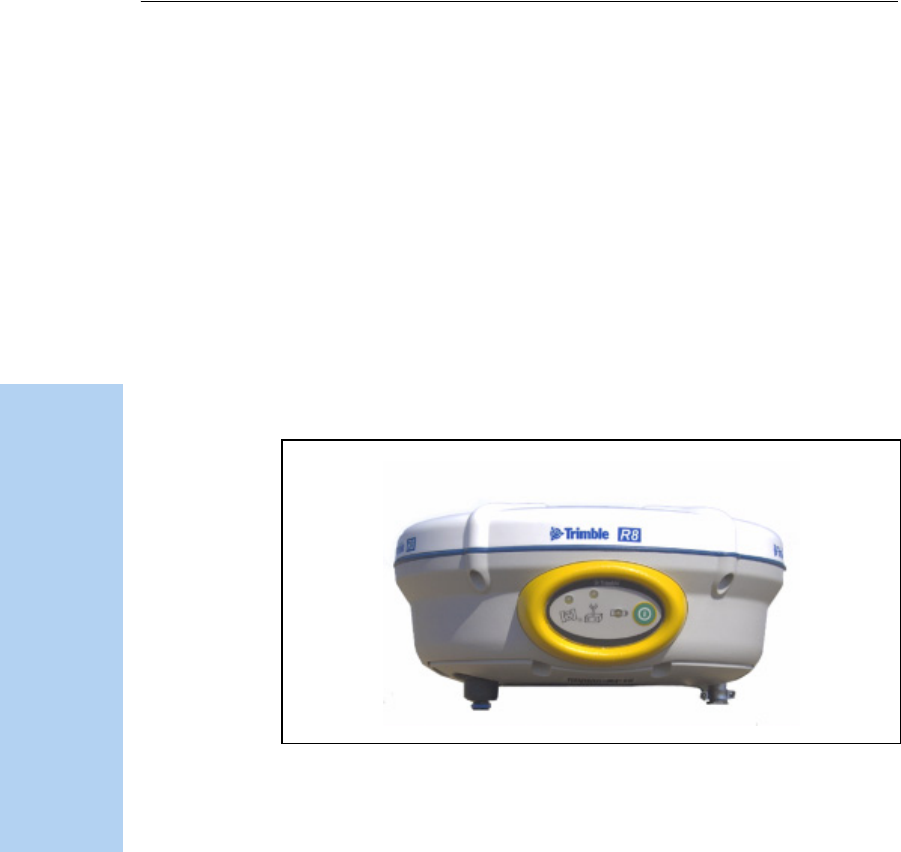
13 Setting up the Receiver
108 Trimble R7/R8 GPS Receiver User Guide
Trimble R8 GPS Receiver Operation
This chapter provides general information on setup, connection, and
cabling for the Trimble R8 receiver.
13.1Parts of the Receiver
All operating controls on the Trimble R8 receiver are located on the
front panel. Serial ports and connectors are located on the bottom of
the unit.
131.1 Front panel
Figure 13.1 shows a front view of the Trimble R8 receiver. The front
panel contains the three indicator LEDs, and the power button.
Figure 13.1 Trimble R8 receiver front panel
The power button controls the receiver’s power on or off functions.
The indicator LEDs show the status of power, satellite tracking, and
radio reception. For more information, see LED Behavior, page 119.
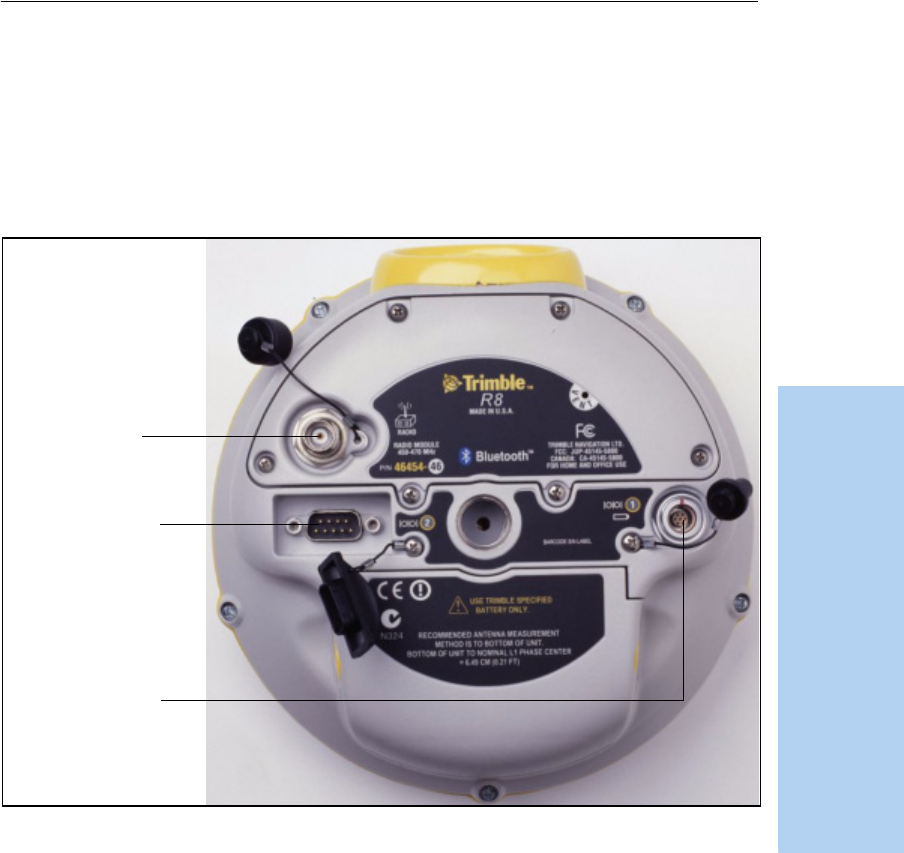
Trimble R7/R8 GPS Receiver User Guide 109
Setting up the Receiver 13
Trimble R8 GPS Receiver Operation
131.2 Lower housing
Figure 13.2 shows the lower housing of the Trimble R8 receiver. The
lower housing contains the two serial ports, one TNC radio antenna or
GSM antenna connector (depending on the internal communication
module ordered), the removable battery compartment and the 5/8-11
threaded insert.
Figure 13.2 Trimble R8 receiver lower housing
Port 1
Port 2
Radio
antenna
connection
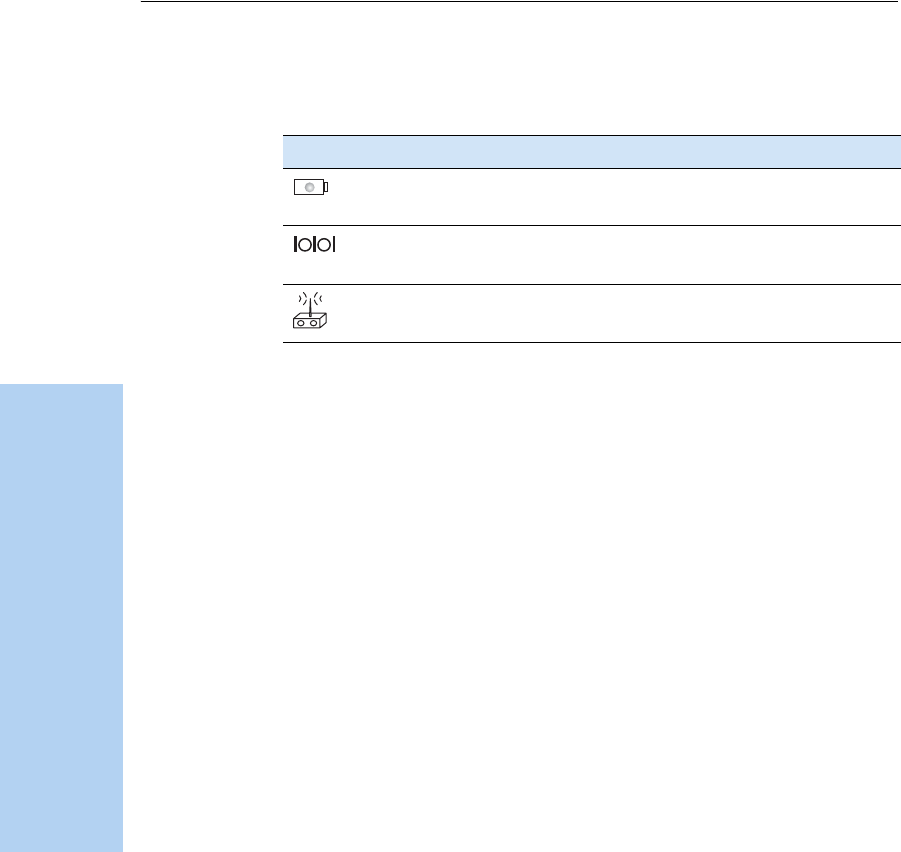
13 Setting up the Receiver
110 Trimble R7/R8 GPS Receiver User Guide
Trimble R8 GPS Receiver Operation
Each port or connector on the Trimble R8 receiver is marked with an
icon to indicate its main function, as shown in Table 13.1.
Port 1 is a 7-pin 0-shell Lemo connector that supports RS-232 comms
and external power input. Port 1 has no power outputs.
Port 2 is a DB-9 male connector that allows for full 9-pin RS-232
comms. Port 2 does not support power in or out. For more information,
see Chapter 18, Default Settings and Chapter 19, Cables and
Connectors.
The TNC connector is for connecting a radio antenna to the Trimble R8
internal radio. A whip “rubber duck” antenna is supplied with the
system for units with internal UHF or 900 MHz radios. This connector
is not used if you are using an external UHF radio or GSM.
External UHF or GSM antenna
Depending on which module you have purchased, use this TNC
connection for an external antenna to enhance the UHF or GSM.
The UHF antenna is approximately 16.5 cm (6.5 inches) long, and
round. The GSM antenna is approximately 16.5 cm (6.5 inches), and
flatter than the UHF antenna. Make sure that you use the correct
antenna or the signal will be degraded.
For more information on connecting the Trimble R8 receiver, see the
following sections in this chapter.
Table 13.1 Trimble R8 receiver ports
Icon Name Connections
Port 1 Device, computer, external radio, power in
Port 2 Device, computer, external radio
RADIO Radio communications antenna

Trimble R7/R8 GPS Receiver User Guide 111
Setting up the Receiver 13
Trimble R8 GPS Receiver Operation
13.2 Setup Guidelines
Consider the following guidelines when setting up the Trimble R8
receiver.
CCAUTION – You must maintain a minimum separation distance of 20 cm
(approximately 8 in.) between yourself and the radiating GSM antenna
for this device to satisfy the RF Exposure requirements of the FCC.
For mobile operation, the maximum gain of the GSM antenna must not
exceed 0 dBi.
132.1 Environmental conditions
Although the Trimble R8 receiver has a waterproof housing, reasonable
care should be taken to protect the unit. Avoid exposure to extreme
environmental conditions, including:
•Water
•Heat greater than 65 °C (149 °F)
•Cold less than –40 °C (–40 °F)
•Corrosive fluids and gases
132.2 Sources of electrical interference
Avoid the following sources of electrical and magnetic noise:
•Gasoline engines (spark plugs)
•Televisions and PC monitors
•Alternators and generators
•Electric motors
•Equipment with DC-to-AC converters
•Fluorescent lights
•Switching power supplies

13 Setting up the Receiver
112 Trimble R7/R8 GPS Receiver User Guide
Trimble R8 GPS Receiver Operation
132.3 General guidelines
WARNING – These receivers use a rechargeable Lithium-ion battery. To
avoid personal injury or equipment damage, make sure that you read and
understand the Safety Information chapter at the front of this manual.
The following guidelines apply whenever you set up your receiver for
operation:
•When plugging in a Lemo cable, make sure that the red dots on
the receiver port and the cable connector line up. Do not use
force to plug cables in, as this may damage the connector pins.
•When disconnecting a Lemo cable, grasp the cable by the sliding
collar or lanyard and pull the cable connector straight out of the
port. Do not twist the connector or pull on the cable itself.
•To securely connect a TNC cable, align the cable connector with
the receiver receptacle, then thread the cable connector onto the
receptacle until it is snug.
•To insert the internal battery place the battery in the battery
compartment, ensuring that the contact points are in the correct
position to align with the contacts in the receiver. Slide the
battery and compartment as a unit upward into the receiver
until the battery compartment latches are locked into position.
13.3Pole-Mounted Setup
Figure 13.3 on page 113 shows the pole-mounted setup for the
Trimble R8 receiver. To mount the receiver on a range pole:
1. Thread the unit onto the range pole.
2. Attach the controller bracket to the pole.
3. Insert the controller into the bracket.
Note – When using the Trimble ACU, or TSCe controller with BlueCap
module, no cabling is required, as shown in Figure 13.3.
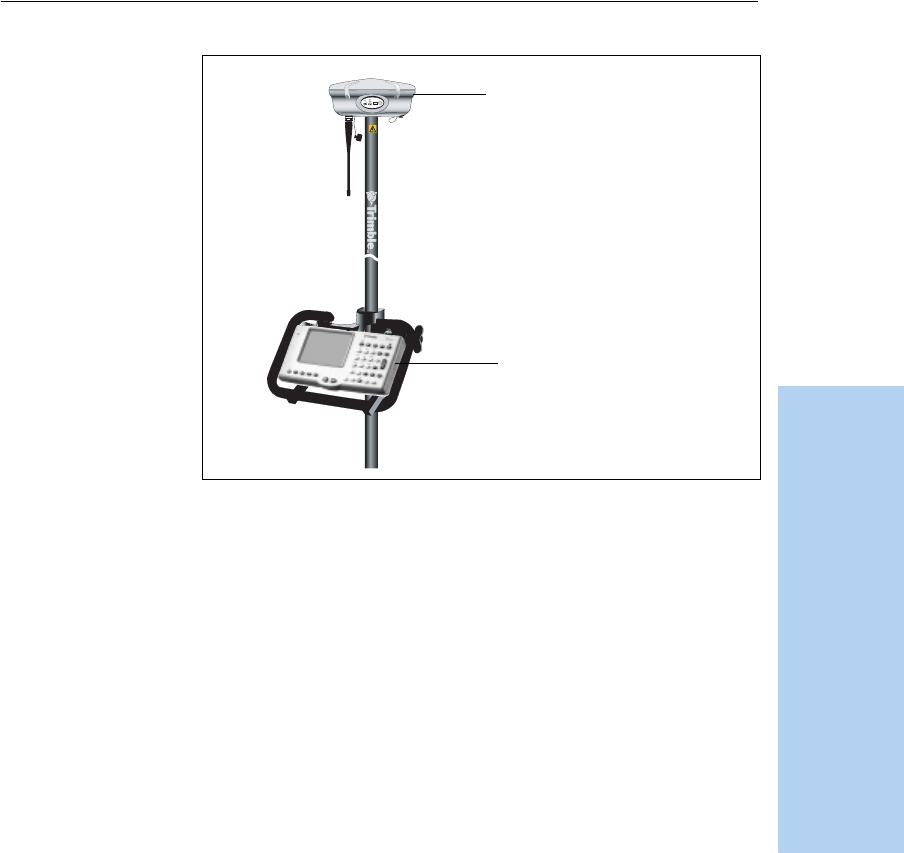
Trimble R7/R8 GPS Receiver User Guide 113
Setting up the Receiver 13
Trimble R8 GPS Receiver Operation
Figure 13.3 Trimble R8 receiver pole-mounted setup
13.1Other System Components
This section describes optional components that you can use with the
Trimble R8 receiver.
131.1 Radios
Radios are the most common data link for Real-Time Kinematic (RTK)
surveying. The Trimble R8 is available with an optional internal radio in
the 450 or 900 MHz UHF band, or with an internal GSM module. You
can also connect an external radio to either port, whether or not the
internal radio is installed.
The Trimble R8 receiver supports the following Trimble base radios
with the internal 450 MHz or 900 MHz UHF radios:
•TRIMMARK™ 3
F
F
Trimble R8 GPS Receiver
ACU controller

13 Setting up the Receiver
114 Trimble R7/R8 GPS Receiver User Guide
Trimble R8 GPS Receiver Operation
•TRIMMARK IIe
•TRIMTALK™ 450S
•SiteNet™ 450
•SiteNet 900
•Trimble R8 internal 450 transmitter
Internal GSM setup
You can configure the receiver optional internal GSM Module using the
Trimble Survey Controller™ software. For more information, refer to the
Trimble Survey Controller User Guide.
Internal radio setup
To configure the receiver optional internal radio, use one of the
following:
• The GPS Configurator software
•The WinFlash software
•The Trimble Survey Controller software
For more information, refer to the GPS Configurator Help, the
WinFlash Help, or the Trimble Survey Controller User Guide.
By default, the internal radio has only a few “test” frequencies installed
at the factory. If you purchased the transmit option, the broadcast
frequencies must be programmed at the factory. You can program the
receive frequncies using the WinFlash software. For more information,
see The WinFlash Software, page 135.

Trimble R7/R8 GPS Receiver User Guide 115
Setting up the Receiver 13
Trimble R8 GPS Receiver Operation
131.2 Cellular modems and external radios
For a data communications link, you can use an internal or external
radio, or an internal or external cellular modem.
To connect an external cellular modem to a Trimble R8 receiver, you
need the following:
•A Trimble R8 receiver.
•A cellular modem, or a cellphone that can transmit and receive
data.
•Serial (cellphone to DB9) cable (supplied with the cellular
modem or phone).
Note – For more information, refer to the document Using
Cellular and CDPD Modems for RTK, which is available from
the Trimble website.
•Port 2 of the receiver supports full RS-232 protocol, and should
function properly with most cellular phone cables. Some cellular
units may require custom cabling.
Alternatively, the receiver also supports a cable-free Bluetooth
connection with Bluetooth enabled cell phones.
For more information on using an external cellular modem as a data
link, refer to the Trimble Survey Controller User Guide.
To connect an external radio modem to a Trimble R8 receiver, you need
the following:
•A Trimble R8 receiver.
•An external radio capable of receiving and decoding Trimble
data packets.
•Serial cable for either Port 1 or Port 2 of the Trimble R8, as
supplied by the radio manufacturer.
•Radio mount for the range pole.

13 Setting up the Receiver
116 Trimble R7/R8 GPS Receiver User Guide
Trimble R8 GPS Receiver Operation

14 General Operation
118 Trimble R7/R8 GPS Receiver User Guide
Trimble R8 GPS Receiver Operation
Figure 14.1 shows the Trimble R8 receiver front panel controls for the
power on/off functions, or receiver reset. The LEDs provide power,
radio, data logging, and SV tracking status information.
Figure 14.1 Controls and LEDs on front panel of the Trimble R8 receiver
14.1Button Functions
The Trimble R8 receiver has only one button, the Power button,
represented in this manual by [P]. Use [P] to turn on or turn off the
receiver, and to perform other functions, as described in Table 14.1.
Note – The term “press” means to press the button and release it
immediately. The term “hold” means to press the button and hold it down
for the given time.
Table 14.1 Power button functions
Action Power button
Turn on the receiver Press
Turn off the receiver Hold for 2 seconds
Delete the ephemeris file Hold for 15 seconds
Reset the receiver to factory defaults Hold for 15 seconds
Delete application files Hold for 30 seconds
F
Power button
SV Tracking
Radio
Power/Data status
LEDs

Trimble R7/R8 GPS Receiver User Guide 119
General Operation 14
Trimble R8 GPS Receiver Operation
14.2LED Behavior
The three LEDs on the front panel of the receiver indicate various
operating conditions. Generally, a lit or slowly flashing LED indicates
normal operation, a LED that is flashing quickly indicates a condition
that may require attention, and an unlit LED indicates that no
operation is occurring. The following table defines each possible LED
state.
142.1 LED flash patterns
The following table details the possible flash patterns to indicate
various states of receiver operation.
The term … means that the LED …
Slow flash alternates on/off for 500 milliseconds.
Fast flash alternates rapidly on/off for 100 milliseconds
On is lit steady
Off is unlit
Receiver mode Power LED
Green
Radio LED
Green
Satellite LED
Amber
Receiver OFF OFF OFF OFF
Receiver ON:
Healthy power ON N/A N/A
Low power Fast flash N/A N/A
Tracking <4 SVs ON N/A Fast flash
Tracking >4 SVs ON N/A Slow flash
Logging data
internally
Flashes off
every 3
seconds
N/A N/A
Transmitting
internally
N/A Flashes off when
transmitting
N/A
Receiving valid data
packets
ON Slow flash N/A

14 General Operation
120 Trimble R7/R8 GPS Receiver User Guide
Trimble R8 GPS Receiver Operation
Note – If a column shows “N/A”, that specific LED may or may not be on,
but it is not relevant to that particular mode.
14.3Starting and Stopping the Receiver
To turn on the receiver, press [P].
To turn off the receiver, hold down [P] for two seconds.
14.4Logging Data
You can log data internally or to a Trimble controller.
144.1 Logging internally
The Trimble R8 receiver logs GPS data internally on 6 MB of internal
memory.
You can then use the Trimble Data Transfer utility to transfer logged
data files to the office computer. The transferred files are in Trimble
DAT (.dat) format.
CWARNING – The Trimble R8 receiver allows for a maximum of 200 files on
the internal memory. The filenames must be in 8.3 format, otherwise files
copied to the internal memory may cause data corruption or loss of data
when logging.
Data is logged using the current logging settings configured in the
receiver. Data files logged internally are named automatically.
No data packets ON OFF N/A
Receiver in Monitor ON Slow flash ON
Receiver mode Power LED
Green
Radio LED
Green
Satellite LED
Amber

Trimble R7/R8 GPS Receiver User Guide 121
General Operation 14
Trimble R8 GPS Receiver Operation
To begin internal logging, you must use a Trimble controller, or the GPS
Configurator software. The Trimble R8 receiver does not have an
internal clock, so you can only conduct timed survey sessions if the
receiver has a continuous power supply.
When the internal memory is full, the receiver stops logging data, and
the Logging/Memory LED switches off. Existing data files are not
overwritten. You can use the Auto-delete option to override this action
and automatically delete the oldest files when the receiver memory is
full. However, you should use this option with caution because it can
lead to data loss.
Table 14.2 shows approximate storage requirements for different
logging rates. The values shown are for a one-hour logging session with
six satellites visible.
144.2 Logging to a Trimble controller
When the Trimble R8 receiver is connected to a Trimble controller, you
can log GPS data from the receiver to the controller, or to a PC card
inserted in the controller. When you use a Trimble controller, you do
not use the receiver’s controls. Instead, you use the controller functions
to set logging options, specify filenames, and control when logging
occurs.
Data is stored in job files, which can be transferred to your office
computer using Trimble’s Data Transfer utility.
For more information on logging data from a receiver using a Trimble
controller refer to the user guide for your particular controller.
Table 14.2 Storage requirements
Logging rate Memory required
10 Hz 2,588 KB
1Hz 335 KB
5 seconds 87 KB
15 seconds 37 KB

14 General Operation
122 Trimble R7/R8 GPS Receiver User Guide
Trimble R8 GPS Receiver Operation
14.5Resetting to Defaults
To reset the receiver to its factory default settings, hold down [P] for at
least 15 seconds.
For more information, see Default Settings, page 152.
14.6Batteries and Power
CWARNING – Do not damage the rechargeable Lithium-ion battery. A
damaged battery can cause an explosion or fire, and can result in personal
injury and/or property damage.
To prevent injury or damage:
– Do not use or charge the battery if it appears to be damaged. Signs of
damage include, but are not limited to, discoloration, warping, and
leaking battery fluid.
– Do not expose the battery to fire, high temperature, or direct sunlight.
– Do not immerse the battery in water.
– Do not use or store the battery inside a vehicle during hot weather.
– Do not drop or puncture the battery.
– Do not open the battery or short-circuit its contacts.
The Trimble R8 receiver can be powered by its internal battery or by an
external power source connected to Port 1. Typically, one internal 2.0
ampere-hour battery provides approximately 5.5 hours of operation
during an RTK survey using the internal radio in rover mode and
approximately 3.5 hours of operation as an RTK base (this varies
according to temperature and wireless data rate).
If an external power source is connected to Port 1 it is used in
preference to the internal battery. When there is no external power
source connected, or if the external power supply fails, the internal
battery is used.
WARNING – Avoid contact with the rechargeable Lithium-ion battery if it
appears to be leaking. Battery fluid is corrosive, and contact with it can
result in personal injury and/or property damage.
To prevent injury or damage:
– If the battery leaks, avoid contact with the battery fluid.

Trimble R7/R8 GPS Receiver User Guide 123
General Operation 14
Trimble R8 GPS Receiver Operation
– If battery fluid gets into your eyes, immediately rinse your eyes with
clean water and seek medical attention. Do not rub your eyes!
– If battery fluid gets onto your skin or clothing, immediately use clean
water to wash off the battery fluid.
The receiver is supplied with two rechargeable Lithium-ion batteries,
and a dual battery charger. The two batteries charge sequentially and
take approximately four hours each to fully charge.
146.1 Battery charging and storage
All battery types discharge over time when they are not being used.
Batteries also discharge faster in colder temperatures. If a Lithium-ion
battery is to be stored for long periods of time, make sure it is fully
charged before storing and re-charged at least every three months.
CWARNING – Charge and use the rechargeable Lithium-ion battery only in
strict accordance with the instructions. Charging or using the battery in
unauthorized equipment can cause an explosion or fire, and can result in
personal injury and/or equipment damage.
To prevent injury or damage:
– Do not charge or use the battery if it appears to be damaged or leaking.
– Charge the Lithium-ion battery only in a Trimble product that is
specified to charge it. Be sure to follow all instructions that are provided
with the battery charger.
– Discontinue charging a battery that gives off extreme heat or a burning
odor.
– Use the battery only in Trimble equipment that is specified to use it.
– Use the battery only for its intended use and according to the
instructions in the product documentation.
Charging the Lithium-ion battery
The rechargeable Lithium-ion battery is supplied partially charged.
Charge the battery completely before using it for the first time. If the
battery has been stored for longer than six months, charge it before use.

14 General Operation
124 Trimble R7/R8 GPS Receiver User Guide
Trimble R8 GPS Receiver Operation
To protect the battery from deep discharge (5 volts or less), the
Trimble R8 receiver is designed to switch batteries or cease drawing
power when the battery pack discharges to 5.9 volts.
A battery that has reached the deep discharge level cannot be
recharged and must be replaced. The following recommendations
provide optimal performance and extend the life of your batteries:
•Fully charge all new batteries prior to use.
•Do not allow the batteries to discharge below 5 volts.
•Keep all batteries on continuous charge when not in use.
Batteries may be kept on charge indefinitely without damage to
the receiver or batteries.
•Do not store batteries in the receiver or external charger unless
power is applied.
•If you must store the batteries, fully charge them before storing
and then recharge them at least every three months.
Disposing of the rechargeable Lithium-ion battery
Discharge the Lithium-ion battery before disposing of it. When
disposing of the battery, be sure to do so in an environmentally
sensitive manner. Adhere to any local and national regulations
concerning battery disposal or recycling.
146.2 Power output
The Trimble R8 receiver does not supply power from either of its two
ports.

Trimble R7/R8 GPS Receiver User Guide 125
General Operation 14
Trimble R8 GPS Receiver Operation
146.3 Firmware
A receiver’s firmware is the program inside the receiver that controls
receiver operations and hardware. You can upgrade the firmware for
the Trimble R8 receiver using the WinFlash software provided on the
Trimble R7, Trimble R8, 5700, and 5800 GPS Receivers CD.
For more information, see The WinFlash Software, page 135.
CWARNING – Upgrading the firmware deletes all application files on the
receiver.

14 General Operation
126 Trimble R7/R8 GPS Receiver User Guide
Trimble R8 GPS Receiver Operation

15 Configuration
128 Trimble R7/R8 GPS Receiver User Guide
Trimble R8 GPS Receiver Operation
The Trimble R8 receiver has no controls for changing settings. To
configure the receiver, use external software such as GPS Configurator,
WinFlash, or Trimble Survey Controller.
There are two ways to configure the receiver. You can:
•configure the receiver in real time
•apply the settings in an application file
This chapter provides a brief overview of each of these methods and
describes the contents and use of application files.
15.1Configuring the Receiver in Real Time
GPS Configurator and Trimble Survey Controller software support real-
time configuration of the Trimble R8 receiver.
When you configure the receiver in real time, you use one of these
software applications to specify which settings you want to change.
When you apply the changes, the receiver settings change immediately.
Any changes that you apply to the receiver are reflected in the current
application file, which is always present in the receiver. The current
application file always records the most recent configuration, so if you
apply further changes (either in real time or using an application file)
the current file is updated and there is no record of the changes that
you applied originally.
For more information on configuring the receiver in real time, see
Chapter 16, Software Utilities.

Trimble R7/R8 GPS Receiver User Guide 129
Configuration 15
Trimble R8 GPS Receiver Operation
15.2Configuring the Receiver Using Application
Files
An application file contains information for configuring a receiver. To
configure a receiver using an application file, you need to create the
application file, transfer it to the receiver, and then apply the file’s
settings. The GPS Configurator software does this for you automatically
when you work with configuration files.
For more information on applying application files, see Chapter 16,
Software Utilities.
15.3Application Files
An application file is organized into records. Each record stores
configuration information for a particular area of receiver operation.
Application files can include the following records:
•File Storage
•General Controls
•Serial Port Baud/Format
•Reference Position
•Logging Rate
•SV Enable/Disable
•Output Message
•Antenna
•Device Control
•Static/Kinematic
•Input Message
An application file does not have to contain all of these records. When
you apply an application file, any option that is not included in the
records in the file remains at its current setting. For example, if you

15 Configuration
130 Trimble R7/R8 GPS Receiver User Guide
Trimble R8 GPS Receiver Operation
apply an application file that only specifies the elevation mask to use,
all other settings remain as they were before the application file was
applied.
You can store up to twenty different application files in the receiver. You
can apply an application file’s settings at the time it is transferred to the
receiver, or at any time afterwards.
153.1 Special application files
The Trimble R8 receiver has three special application files, which
control important aspects of the receiver’s configuration.
Default application file
The default application file (Default.cfg) contains the original receiver
configuration, and cannot be changed. This file configures the receiver
after it is reset. You can reset the receiver by holding down [P] for at least
15 seconds, or by using the reset option in the GPS Configurator
software.
For more information, see Default Settings, page 152.
Although you cannot change or delete the default application file, you
can use a power up application file to override any or all of the default
settings.
Current application file
The current application file (Current.cfg) reflects the current receiver
configuration. Whenever you change the receiver’s configuration,
either in real time or by applying an application file, the current file
changes to match the new configuration.
You cannot delete the current file or change it directly, but every
change to the receiver’s current configuration is applied to the current
file as well.

Trimble R7/R8 GPS Receiver User Guide 131
Configuration 15
Trimble R8 GPS Receiver Operation
When you switch off the receiver then turn it on again, all the settings
from the current application file are applied, so you do not lose any
changes that you have made. The only exceptions are the following
logging parameters:
•Logging rate
•Position rate
•Elevation mask
These parameters are always reset to the factory default values
whenever the receiver is switched off.
Power Up application file
The power up application file (Power_up.cfg) is used to set the receiver
to a specific configuration any time the unit is powered up.
You can specify that the receiver is reset to defaults before the power up
settings are applied. This ensures that restarting the receiver always
resets it to factory defaults prior to applying the power up application
file.
Alternatively, you can specify that the power up settings are applied
immediately after the current application file’s settings have been
applied. Restarting the receiver results in a configuration that uses your
default settings for the options you define in the power up file, but the
current settings for all other options.
By default, there is no power_up application file on the receiver. To use
a power up application file, you must create and save a power_up
application file in the GPS Configurator software. If you save this file to
disk, the file is called power_up.cfg. The extension .cfg is used by
convention to identify application files on the office computer. When
you transfer this file to the receiver, the file is saved on the receiver as
power_up, and becomes the new power up file.
The power up file is the only special application file that you can
overwrite or delete from the receiver.

15 Configuration
132 Trimble R7/R8 GPS Receiver User Guide
Trimble R8 GPS Receiver Operation
153.2 Applying application files
An application file’s settings do not affect the receiver’s configuration
until you apply the application file. You can do this at the same time
that you save the file. Alternatively, you can save the file on the
computer or in the receiver, then open it later and apply its settings.
153.3 Storing application files
You can store application files that you create in the GPS Configurator
software on the receiver and on the computer. For example, each file
can represent a different user sharing the same receiver, or a particular
mode of operation or survey style. Saving application files on your
computer as well as in your receiver is optional, but it is useful because:
•it gives you a permanent copy of the settings you have sent to a
receiver, for audit or your own reference.
• you can use the same file to configure multiple receivers
identically.
•you can use an existing application file as a template for creating
other application files with similar settings.
153.4 Naming application files
The application filename in the office computer and in the receiver are
always the same. This makes it easier to recognize and keep track of
your application files.
When you change the name of the application file in the receiver, this
changes the application filename on your computer. When you transfer
an application file from the receiver and save it to the computer, the
system renames the file to match the internal receiver file. However, if
you use Windows Explorer, for example, to change the .cfg filename on
the computer, this does not change the internal receiver filename. This
means that the GPS receiver does not recognize the change to the
filename on the computer.

16 Software Utilities
134 Trimble R7/R8 GPS Receiver User Guide
Trimble R8 GPS Receiver Operation
This chapter provides information on the software utilities that you can
use with the Trimble R8 receiver.
16.1The GPS Configurator Software
GPS Configurator is office software that configures selected Trimble
GPS receivers.
GPS Configurator software enables you to:
•edit and save configuration files to the receiver and the
computer
•check current receiver settings and operation
•configure receiver settings with your office computer
161.1 Installing the GPS Configurator software
A copy of GPS Configurator software is included on the Trimble R7,
Trimble R8, 5700, and 5800 GPS Receivers CD.
1. Insert the CD into the CD drive on your computer.
2. From the main menu, select Install individual software packages.
3. Select Install GPS Configurator vX.XX.
4. Follow the onscreen instructions.
Configuring the Trimble R8 receiver using GPS
Configurator software
1. Connect Port 1 or 2 on the receiver to a serial (COM) port on the
computer and apply power.
2. To start GPS Configurator, click , then select
Programs /Trimble /GPS Configurator /GPS Configurator.

Trimble R7/R8 GPS Receiver User Guide 135
Software Utilities 16
Trimble R8 GPS Receiver Operation
3. In the Device Type dialog, select Trimble R8.
The software automatically establishes a connection with the
receiver.
4. Make appropriate selections for your required receiver settings.
For more information, refer to the GPS Configurator Help.
5. Click Apply.
The settings in GPS Configurator software are applied to the
receiver.
16.1The WinFlash Software
The WinFlash software communicates with Trimble products to
perform various functions including:
•installing software, firmware, and option upgrades
•running diagnostics (for example, retrieving configuration
information)
•configuring radios
For more information, online help is also available when using the
WinFlash software.
Note – The WinFlash software runs on Microsoft® Windows® 95, 98,
Windows NT®, 2000, Me, or XP operating systems.
161.1 Installing the WinFlash software
1. Insert the Trimble R7, Trimble R8, 5700, and 5800 GPS Receivers
CD into the CD drive on the computer.
2. From the main menu, select Install individual software packages.
3. Select Install WinFlash vX.XX with Trimble R8 drivers and
firmware and then follow the on-screen instructions.
Alternatively, install the WinFlash software from the Trimble website

16 Software Utilities
136 Trimble R7/R8 GPS Receiver User Guide
Trimble R8 GPS Receiver Operation
160.1 Upgrading firmware
Your Trimble R8 receiver is supplied with the latest version of receiver
firmware installed. If a later version becomes available, upgrade the
firmware installed on your receiver.
The WinFlash software guides you through the firmware upgrade
process. The steps required are described below. For more information,
refer to the WinFlash Help.
To upgrade the Trimble R8 receiver firmware:
1. Start the WinFlash software. The Device Configuration screen
appears.
2. From the Device type list, select Trimble R8 Receiver.
3. From the PC serial port field, select the serial (COM) port on the
computer that the receiver is connected to.
4. Click Next.
The Operation Selection screen appears. The Operations list
shows all of the supported operations for the selected device. A
description of the selected operation is shown in the Description
field.
5. Select GPS software upgrade and click Next.
The GPS Software Selection window appears. This screen
prompts you to select the software that you want to install on
the receiver.
6. Select the latest version from the Available Software list and click
Next.
The Settings Review window appears. This screen prompts you to
connect the receiver, suggests a connection method, and then
lists the receiver configuration and selected operation.

Trimble R7/R8 GPS Receiver User Guide 137
Software Utilities 16
Trimble R8 GPS Receiver Operation
7. If all is correct, click Finish.
Based on the selections shown above, the Software Upgrade
window appears and shows the status of the operation (for
example, Establishing communication with the Trimble R8.
Please wait ...)
8. Click OK.
The Software Upgrade window appears again and states that the
operation was completed successfully.
9. Click Menu to select another operation, or click Exit to quit
WinFlash.
10. If you click Exit, another screen appears asking you to confirm
that you want to quit. Click OK.
160.1 Adding frequencies for the 450 MHz internal radio
If your Trimble R8 receiver has the optional internal 450 MHz radio
installed, you must use the WinFlash software to add receiving
frequencies to the default list. If you purchased the transmit option, the
broadcast frequencies must be programmed at the factory.
1. Start the WinFlash software. The Device Configuration screen
appears.
2. From the Device type list, select Trimble R8 Receiver.
3. From the PC serial port field, select the serial (COM) port on the
computer that the receiver is connected to.
4. Click Next.
The Operation Selection screen appears. The Operations list
shows all of the supported operations for the selected device. A
description of the selected operation is shown in the Description
field.
5. Select Configure Radio and then click Next.
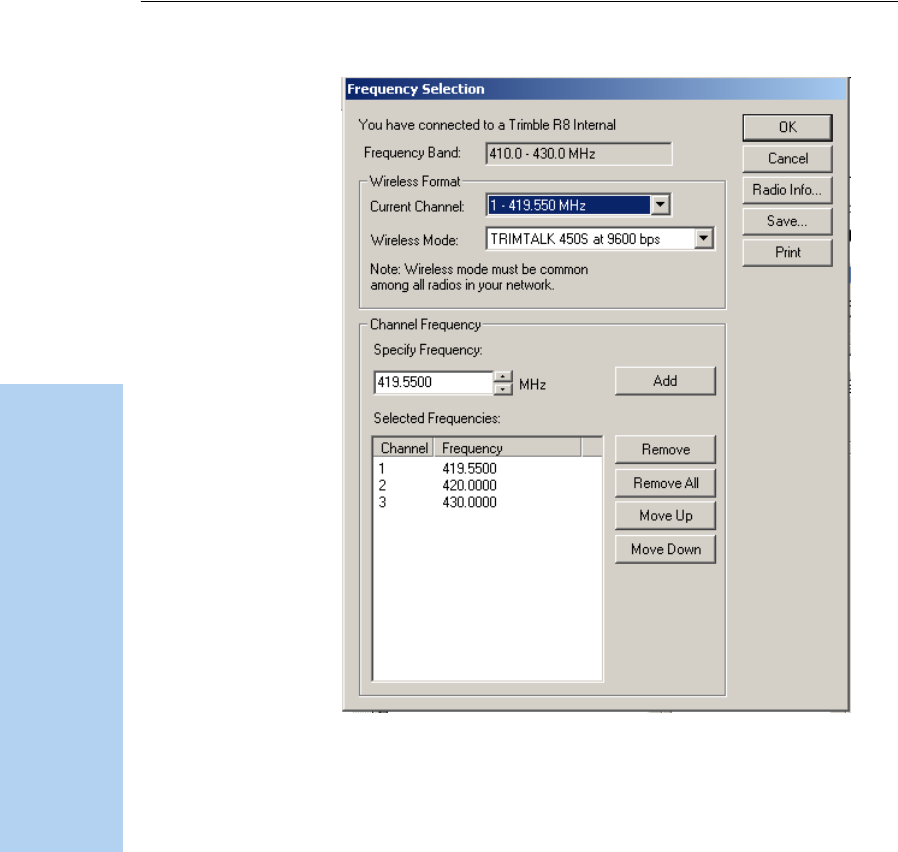
16 Software Utilities
138 Trimble R7/R8 GPS Receiver User Guide
Trimble R8 GPS Receiver Operation
The Frequency Selection window appears:
6. In the Wireless Format group, select the appropriate channel and
wireless mode. The Wireless Mode must be the same for all
radios in your network.
7. In the Specify Frequency field, enter the frequency you require.
8. Click Add. The new frequency appears in the Selected
Frequencies list.

Trimble R7/R8 GPS Receiver User Guide 139
Software Utilities 16
Trimble R8 GPS Receiver Operation
Note – The frequencies that you program must conform to the
channel spacing and minimum tuning requirements for the
radio. To view this information, click Radio Info. You may select
either 12.5 or 25 kHz channel spacing. All radios in your
network must use the same channel spacing.
9. When you have configured all the frequencies you require, click
OK.
The WinFlash software updates the receiver radio frequencies
and then restarts the receiver.
Note – You can only configure receive frequencies. The FCC approved
transmit frequencies must be specified and configured by Trimble.
160.1 Configuring the internal 900 MHz radio setup
Use one of the following:
•The Trimble Survey Controller software running on a Trimble
controller
•The WinFlash software (provided on the Trimble R7, Trimble R8,
5700, and 5800 GPS Receivers CD)
The internal radio has 40 available networks. You must choose the
same network that is configured in the base radio you want to receive
from.
Configuring the radio network using the Trimble
Survey Controller software
1. Connect to the Trimble R8 receiver with Bluetooth wireless
technology (or the appropriate data cable if necessary).
2. From the main menu on the controller, select Configuration.
3. In the dialog that appears, select Survey styles, then from the
Type field, select RTK.
4. Select Rover radio, then from the Type field select Trimble
Internal.

16 Software Utilities
140 Trimble R7/R8 GPS Receiver User Guide
Trimble R8 GPS Receiver Operation
5. Tap the ! softkey.
6. Once connected, in the Network number field enter the number
of the network set on your base radio.
The Base Radio Mode field is not used here.
7. Tap the E softkey to complete configuration.
Configuring the radio network using the WinFlash
software
1. Connect the data/power cable to Port 1 on the receiver.
2. Connect the female DE-9 connector on the other end of the
data/power cable to a serial (COM) port on the computer.
3. Start the WinFlash software. The Device Configuration dialog
appears.
4. From the Device type list, select Trimble R8 Receiver.
5. From the PC serial port field, select the serial port on the
computer that the receiver is connected to and click Next.
6. From the Operation selection dialog, select Configure radio and
click Next.
7. Confirm that your current settings are correct and click Finish.
The Configure 900MHz radio dialog appears.
8. In the Network number field, select the same network that is set
on your base radio.
9. In the Country setting field, select one of the following (according
to how your base radio was shipped):
– Your country (if available). This sets the radio to the a
specific frequency range being transmitted by the base
radio.
– A single frequency. This limits the frequencies used to those
authorized in your particular country.
10. Click OK.
The WinFlash software updates the radio settings and then restarts the
receiver.
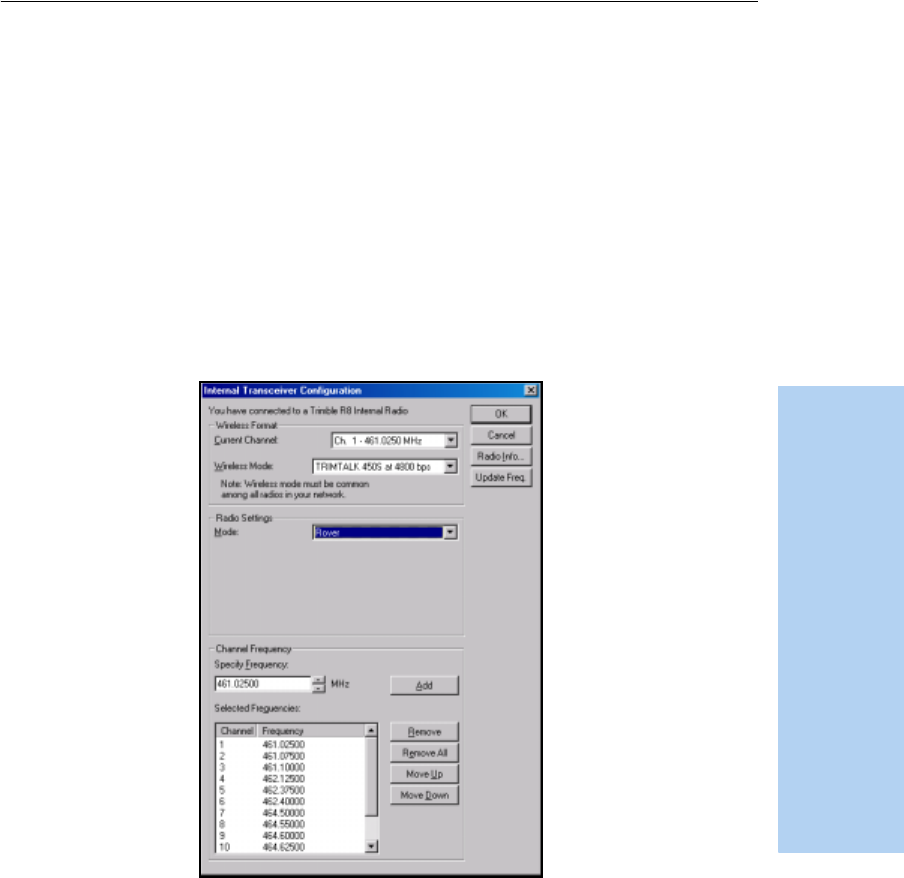
Trimble R7/R8 GPS Receiver User Guide 141
Software Utilities 16
Trimble R8 GPS Receiver Operation
160.1 Configuring the internal transceiver
Use the WinFlash Internal Transceiver Configuration dialog to configure
the Trimble R8 internal transceiver.
BTip – To view a list of all radio information, including the current
configuration, click Radio Info.
1. Select the Current Channel, which determines the radio
operating frequency.
2. Select the Wireless Mode, which determines the over-the-air
communications parameters. The following example shows a
rover setup:
To reduce battery consumption on your base receiver, set the
wireless mode as high as possible. For example, 9600 bps
consumes half the power of 4800 bps for the same data format
and time of operation.
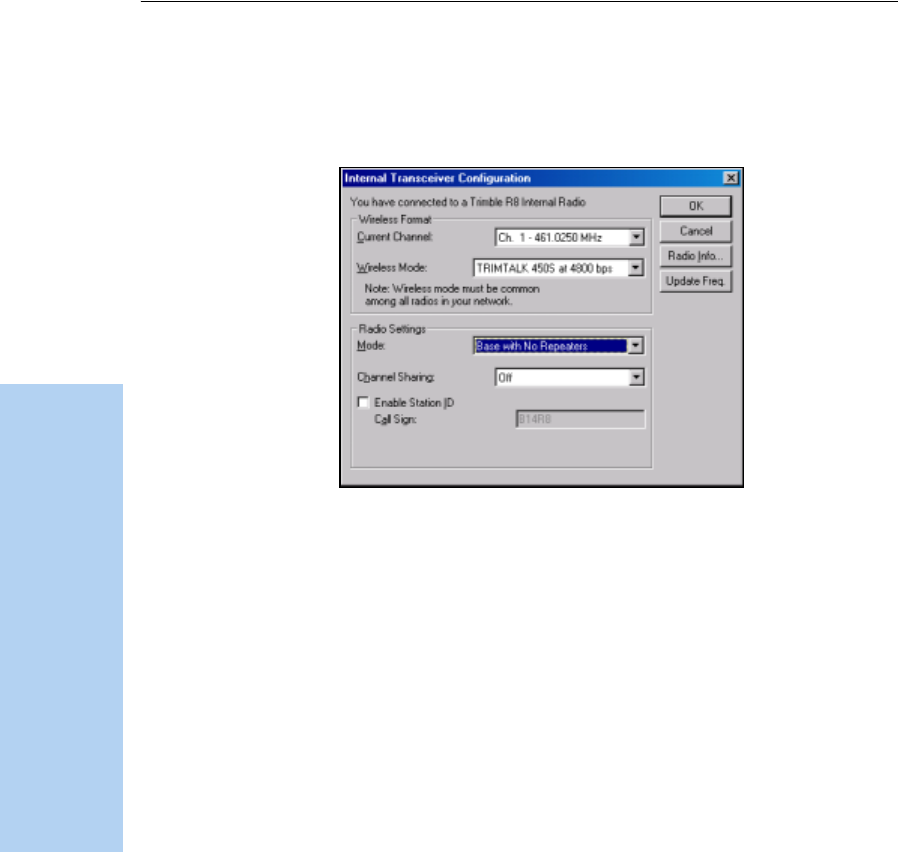
16 Software Utilities
142 Trimble R7/R8 GPS Receiver User Guide
Trimble R8 GPS Receiver Operation
All radios in the network must be configured with the
same wireless setting.
3. Select the appropriate operating mode, depending on how you
intend to use the receiver, for example, Base with No Repeaters:
4. Select one of the following channel sharing configurations (base
modes only; not available for rover):
– Off. The carrier detect mode is off. The unit will ignore
other transmissions on your frequency and continue to
transmit data.
Note – It may be illegal in your country of use to set
channel sharing to Off. You may be subject to penalties or
fines based upon the specific licensing requirements for
your country of use. Please consult your radio license
documentation or licensing agency for operational
guidelines.
– Avoid Weak Signals.The carrier detect mode is on. The
radio will cease transmitting if it detects another radio
transmission on its frequency. It will resume transmission
when the channel is free of radio traffic.

Trimble R7/R8 GPS Receiver User Guide 143
Software Utilities 16
Trimble R8 GPS Receiver Operation
– Avoid Strong Signals. The carrier detect mode is on, but the
radio will stop transmitting only when there is a strong
signal present (receive level greater than 90 dBm).
5. If you are operating in Base mode, select the Enable Station ID
check box and then enter your call sign in the Call Sign field. This
FCC requirement is for U.S. licensed users. It sets your radio to
transmit your call sign in Morse code every 15 minutes.
6. To update the configuration, click OK.
In the Status dialog that appears, select an option to return to the
main menu or to exit the WinFlash software.
BTip – You can print or save the radio configuration information for future
reference. If required, you can fax or e-mail the file to Trimble Support to aid in
troubleshooting radio problems.
Updating the frequency list
You can program the internal transceiver modem with a list of up to 20
frequencies, which are stored in non-volatile memory. This list is
pre-configured based on the frequencies that you requested when you
ordered the unit. Government regulations stipulate that only
manufacturers or authorized dealers can create this frequency list and
that all frequencies programmed into a unit must comply with the host
country regulations. If you need to add, delete, or replace frequencies,
contact your Trimble dealer, and provide the radio modem serial
number and an updated list of the frequencies you require. Once you
receive the frequency file, you can upgrade the radio using the
WinFlash software.

16 Software Utilities
144 Trimble R7/R8 GPS Receiver User Guide
Trimble R8 GPS Receiver Operation

17 Specifications
146 Trimble R7/R8 GPS Receiver User Guide
Trimble R8 GPS Receiver Operation
This chapter details the specifications of the Trimble R8 receiver.
17.1Physical Specifications
Table 17.1 lists physical specifications for the Trimble R8 receiver.
Table 17.1 Physical specifications
Feature Specification
Size 19cm (7.5") wide x 10cm (3.9") deep
including connectors
Weight: with internal battery
and radio
1.31 kg (2.13 lbs)
Operating times on internal
battery
450 MHz receive/transmit: 3.5 hours (varies
with temperature and wireless data rate)
GSM: 3.8 hours (varies with temperature)
Battery life
(at 20 °C)
Approximately 5.5 hours for one 2.0 ah
Lithium-ion battery
External Power input 11–28 V DC
Operating temperaturea
aReceiver will operate normally to –40 °C. Bluetooth module, GSM module, and
internal batteries are rated to –20 °C.
–40 °C to +65 °C (–40 °F to +149 °F)
Storage temperature –40 °C to +70 °C (–40 °F to +157 °F)
Humidity 100% condensing, unit fully sealed
Casing Dust-proof, shock- and vibration-resistant

Trimble R7/R8 GPS Receiver User Guide 147
Specifications 17
Trimble R8 GPS Receiver Operation
17.2Positioning Specifications
Table 17.2 lists positioning specifications for the Trimble R8 receiver.
17.3Technical Specifications
Table 17.3 lists technical specifications for the Trimble R8 receiver.
Table 17.2 Positioning specifications
Positioning Mode Horizontal accuracy
(RMS)
Vertical accuracy
(RMS)
RTK (OTF) Synchronized 1 cm + 1 ppm
(× baseline length)
2cm + 1ppm
(× baseline length)
Low Latency 2 cm + 2 ppm
(× baseline length)a
aDepends on radio link latency.
3cm + 2ppm
(× baseline length)a
L1 C/A Code
Phase
Synchronized/
Low Latency
.25m + 1ppm RMS .50m + 1ppm RMS
Static/
FastStatic
N/A 5 mm + 0.5 ppm
(× baseline length)
5 mm + 1 ppm
(× baseline length)
WAAS N/A Less than 5 mb
b3D RMS values depend on WAAS system performance.
Less than 5 mb
Table 17.3 Technical specifications
Feature Specification
Tracking 24 Channels L1 C/A Code, L2C, L1/L2 Full Cycle Carrier,
WAAS/EGNOS support
Fully operational during P-code encryption
WAAS satellite tracking
Signal processing Maxwell™ V architecture
Very low-noise C/A code processing
Multipath suppression
Start-up Cold start: < 60 seconds from power on
Warm start: < 30 seconds with recent ephemeris

17 Specifications
148 Trimble R7/R8 GPS Receiver User Guide
Trimble R8 GPS Receiver Operation
Initialization Automatic while moving or static
Minimum
initialization time
10 sec + 0.5 × baseline length (km)
Communications Two RS-232 serial ports (Port 1, Port 2,)
Port 1: Baud Rates up to 115,200 bps
Port 2: Baud Rates up to 115,200 bps
RTS/CTS flow control negotiation supported on Port 2
only
Bluetooth communications with Trimble ACU or TSCe
with BlueCap module
Transmit radio Transmit power: 0.5 watts
Wireless data rate: 4800, 8000, 9600, 16000, and 19200
Frequency bands: 410-430MHz, 430-450MHz,
450-470MHz
Channel Spacing: 12.5kHz and 25kHz
Number of channels: Total of 20 factory
pre-programmed transmit frequencies or user
configured receive frequencies
RF modulation format: Gaussian Minimum Shift Keying
(GMSK) at 4800, 8000, 9600, 16000, and 19200 bps
Range: Optimal 10 km (line of sight); Typical: 3–5 km
(varies with terrain and operational conditions)
Battery life: Up to 3.5 hours (varies with temperature
and wireless data rate)
GSM module Certification: Class B Part 15, 22, 24
FCC certification: 850/1900
Class 10 GSM module
CE Mark approval
C-tick approval
GSM: type approvals are country specific. For more
information, contact your Trimble representative.
Bluetooth Type approvals are country specific. For more
information, contact your Trimble representative.
Table 17.3 Technical specifications (continued)
Feature Specification

Trimble R7/R8 GPS Receiver User Guide 149
Specifications 17
Trimble R8 GPS Receiver Operation
Configuration Through user-definable application files or GPS
Configurator
Output formats NMEA-0183: AVR; GGA; GSA; GST; GSV; PTNL,GGK;
PTNL,GGK_SYNC; HDT; PTNL,PJK; PTNL,PJT; ROT;
PTNL,VGK; VHD; VTG; ZDA
GSOF (Trimble Binary Streamed Output)
RT17
Table 17.3 Technical specifications (continued)
Feature Specification

17 Specifications
150 Trimble R7/R8 GPS Receiver User Guide
Trimble R8 GPS Receiver Operation

18 Default Settings
152 Trimble R7/R8 GPS Receiver User Guide
Trimble R8 GPS Receiver Operation
All Trimble R8 receiver settings are stored in application files. The
default application file is stored permanently in the receiver, and
contains the factory default settings for the receiver. whenever the
receiver is reset to its factory defaults, the current settings (stored in the
current application file are reset to the values in the default application
file.
You cannot modify the default application file. However, if there is a
power up application file (power_up) in the receiver, the settings in this
file can be applied immediately after the default application file,
overriding the factory defaults.
For more information, see Application Files, page 129.
18.1Default Settings
Table 18.1 lists the default settings for the Trimble R8 receiver, as
defined in the default application file.
Table 18.1 Default settings
Function Factory default
SV Enable All SVs enabled
General Controls: Elevation mask 13°
PDOP mask 7
RTK positioning mode Low Latency
Motion Kinematic
Serial Port 1: Baud rate 115,200
Format 8-None-1
Flow control None
Serial Port 2: Baud rate 115,200
Format 8-None-1
Flow control None

Trimble R7/R8 GPS Receiver User Guide 153
Default Settings 18
Trimble R8 GPS Receiver Operation
18.2Resetting to Factory Defaults
To reset the Trimble R8 receiver to its factory defaults, do one of the
following:
•On the receiver, press and hold down [P] for 15 seconds.
•In the GPS Configurator software, select Connect to Receiver and
then click Reset receiver in the General tab.
182.1 Default behavior
The factory defaults specified above are applied whenever you start the
receiver. If a power up file is present in the receiver, its settings are
applied immediately after the default settings, so you can use a power
up file to define your own set of defaults.
Input Setup: Station Any
NMEA/ASCII (all messages) All Ports Off
Streamed output All Types Off
Offset = 00
RT17/Binary All Ports Off
Reference position: Latitude 0°
Longitude 0°
Altitude 0.00 m HAE
Antenna: Type Trimble R8/5800 Internal
Height (true vertical) 0.00 m
Group All
Measurement method Bottom of mount
Table 18.1 Default settings (continued)
Function Factory default

18 Default Settings
154 Trimble R7/R8 GPS Receiver User Guide
Trimble R8 GPS Receiver Operation
182.2 Power up settings
When you turn off the receiver, any changes that you have made to
logging settings are lost and these settings are returned to the factory
defaults. Other settings remain as defined in the current file. The next
time you turn on the receiver, the receiver checks for a power up file
and, if one is present, applies the settings in this file.
When you use [P] to turn off and then
turn on the receiver and …
then logging
settings are …
and all other
settings are …
you changed the receiver settings by
applying an application file
the factory defaults the last settings used
you changed the receiver settings using
configuration software
the factory defaults the last settings used
there is a Power Up application file in the
receiver
the factory defaults,
or those in the Power
Up filea
aA factory default setting is used only if the setting is not defined in the Power Up file.
the last settings used,
or those in the Power
Up file
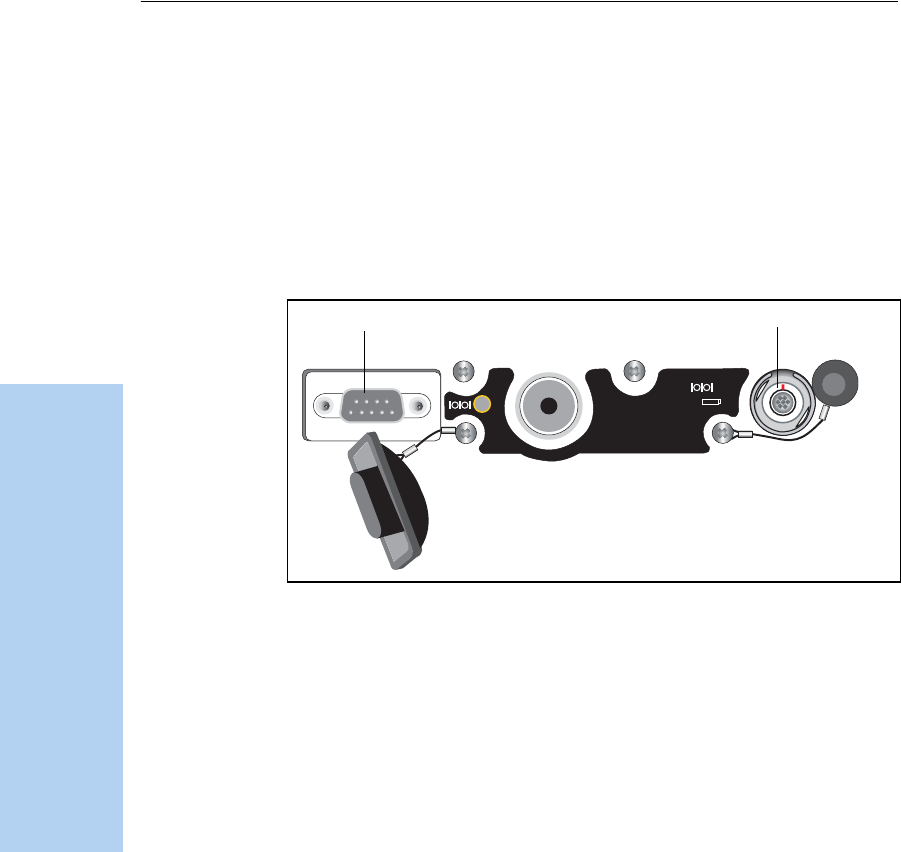
19 Cables and Connectors
156 Trimble R7/R8 GPS Receiver User Guide
Trimble R8 GPS Receiver Operation
This chapter provides pinout information for the Trimble R8 receiver
standard and optional cables. This information can be used to prepare
special cables for connecting the receiver to devices and instruments
not supported by the standard and optional cables.
19.1Port 1 and 2 Connectors
Figure 19.1 shows the location of the receiver serial ports.
Figure 19.1 Trimble R8 receiver serial ports
1
2
BARCODE S/N LABEL
Port 1
Port 2
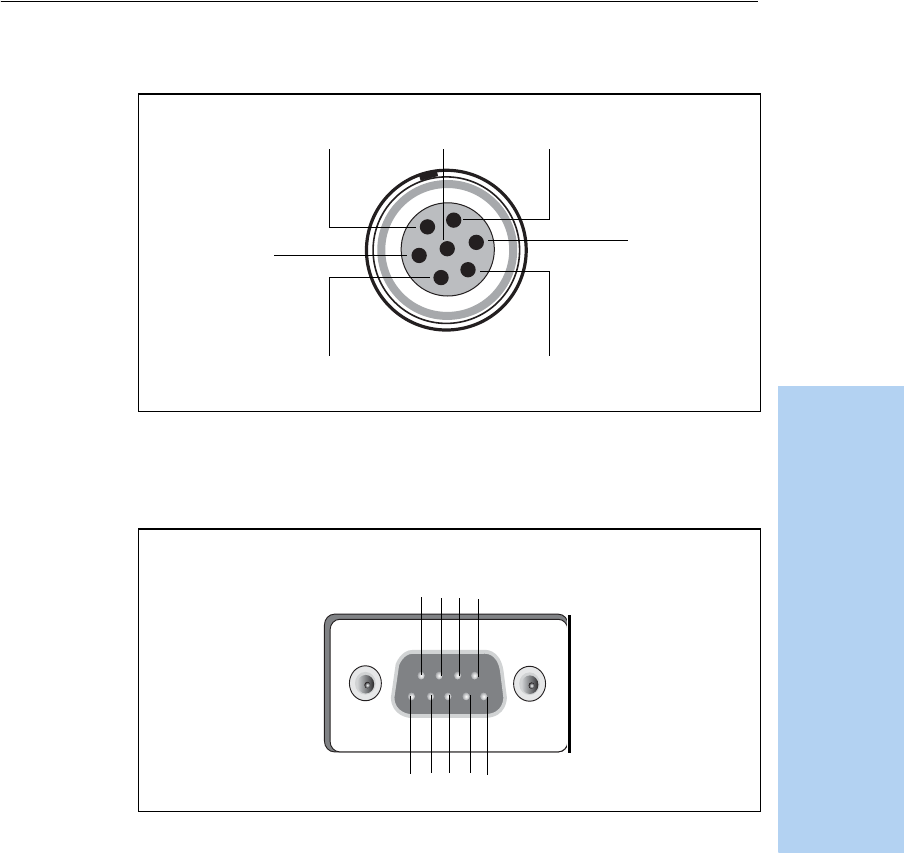
Trimble R7/R8 GPS Receiver User Guide 157
Cables and Connectors 19
Trimble R8 GPS Receiver Operation
Figure 19.2 gives pinout requirements for the connector labeled Port 1.
Figure 19.2 Port 1 connector
Figure 19.3 gives pinout requirements for the connector labeled Port 2.
Figure 19.3 Port 2 connector
7
1
3
6
4
25
Pins 9 8 7 6
Pins 5 4 3 2 1

19 Cables and Connectors
158 Trimble R7/R8 GPS Receiver User Guide
Trimble R8 GPS Receiver Operation
Table 19.1 describes the pinout functionality.
19.2Power/Serial Data Cables
Note – Table 19.2 gives pinout information for the data-I/O cable,
(PN 18532) which is supplied with the Trimble R8 receiver.
Note – Table 19.2 assumes that the cable is attached to the connector
labeled Port 2.
Table 19.1 Trimble R8 receiver port pinouts
Pin Pinout function
Port 1 - 7-pin Lemo Port 2 - DB-9
1 Signal ground DCD
2 - Power ground RXD
3TXD TXD
4N/C DTR
5 N/C Signal ground
6 + Power in DSR
7TRXD RTS
8N/A CTS
9 N/A Ring indicator
Table 19.2 Data-I/O cable pinouts
DB-9 Female
9 Pin
DB-9 Female
9 pin
Pin Function Pin Function
1-6 DCD5_232 4 DTR5_232
2 RX5_232 3 TX5_232
3 TX5_232 2 RX5_232
4 DTR5_232 1-6 DCD5_232
5 GND 5 GND

Trimble R7/R8 GPS Receiver User Guide 159
Cables and Connectors 19
Trimble R8 GPS Receiver Operation
This data cable may be used for firmware upgrades and other
computer functions with the Trimble R8 receiver. Power must be
supplied to the receiver through Port 1, or from the internal battery.
Note – Table 19.2 gives pinout information for the power/serial data cable,
(PN 32345) which is optional for use with the Trimble R8 receiver. This
cable can be used for firmware upgrades through Port 1, while also
supplying external power.
Note – Table 19.3 assumes that the cable is attached to the connector
labeled Port 1.
7 RTS5_232 8 CTS5_232
8 CTS5_232 7 RTS5_232
9 no connection RI5_232 9
Table 19.3 Power/serial data cable pinouts
Lemo 0-shell
connector
7 Pin
Direction DE9-F connector
7 Cond
Power lead
2 Cond
Pin Function Pin Color Function Color Function
1 GND ↔5 Brown Signal ground
2 GND →Black V-OUT
3TX3_232 →2 Orange TXD
4RTS/TXD →8Blue RTS
5CTS/RXD ←7GreenCTS
6PWR_IN ← Red Power IN (+)
7RX3_232 ←3YellowTXD
Table 19.2 Data-I/O cable pinouts (continued)
DB-9 Female
9 Pin
DB-9 Female
9 pin
Pin Function Pin Function

19 Cables and Connectors
160 Trimble R7/R8 GPS Receiver User Guide
Trimble R8 GPS Receiver Operation

SECTION
III
Trimble R7/R8 GPS Receiver User Guide 161
IAPPENDIXES
TRIMBLE R7 / TRIMBLE R8

162 Trimble R7/R8 GPS Receiver User Guide

A NMEA-0183 Output
164 Trimble R7/R8 GPS Receiver User Guide
TrimbleR7/R8 GPS Receiver Operation
This appendix describes the formats of the subset of NMEA-0183
messages that are available for output by the receivers. For a copy of the
NMEA-0183 Standard, go to the National Marine Electronics
Association website at www.nmea.org.
A.1 NMEA-0183 Outputs
When NMEA-0183 output is enabled, a subset of NMEA-0183 messages
can be output to external instruments and equipment connected to the
Trimble R7/R8 receivers serial ports. These NMEA-0183 messages let
external devices use selected data collected or computed by the GPS
receiver.
All messages conform to the NMEA-0183 version 3.01 format. All begin
with $ and end with a carriage return and a line feed. Data fields follow
comma (,) delimiters and are variable in length. Null fields still follow
comma (,) delimiters but contain no information.
An asterisk (*) delimiter and checksum value follow the last field of data
contained in an NMEA-0183 message. The checksum is the 8-bit
exclusive OR of all characters in the message, including the commas
between fields, but not including the $ and asterisk delimiters. The
hexadecimal result is converted to two ASCII characters (0–9, A–F).
The most significant character appears first.
Table A.1 summarizes the set of NMEA messages supported by the
Trimble R7/R8 receivers, and shows the page where detailed
information about each message can be found.
Table A.1 NMEA message summary
Message Function Page
AVR Time, yaw, tilt, range, mode, PDOP, and
number of SVs for Moving Baseline RTK
167
GGA Time, position, and fix related data 168
GSA GNSS DOP and active satellites 169
GST Position error statistics 170

Trimble R7/R8 GPS Receiver User Guide 165
NMEA-0183 Output A
Trimble R7/R8 GPS Receiver Operation
To enable or disable the output of individual NMEA messages, do one
of the following:
•Create an application file in the GPS Configurator software that
contains NMEA output settings and then send the file to the
receiver.
•Add NMEA outputs in the Serial outputs tab of the GPS
Configurator software and then apply the settings.
A.2 Common Message Elements
Each message contains:
•A message ID consisting of $GP followed by the message type.
For example, the message ID of the GGA message is $GPGGA.
•A comma
GSV Number of SVs in view, PRN, elevation,
azimuth, and SNR
170
HDT Heading from True North 171
PTNL,GGK Time, position, position type and DOP values 172
PTNL,GGK_SYNC Time, synchronized position, position type
and DOP values
173
PTNL,PJK Local coordinate position output 174
PTNL,PJT Projection type 175
PTNL,VGK Time, locator vector, type and DOP values 176
PTNL,VHD Heading Information 177
ROT Rate of turn 178
VTG Actual track made good and speed over
ground
178
ZDA UTC day, month, and year, and local time
zone offset
179
Table A.1 NMEA message summary (continued)
Message Function Page

A NMEA-0183 Output
166 Trimble R7/R8 GPS Receiver User Guide
TrimbleR7/R8 GPS Receiver Operation
•A number of fields, depending on the message type, separated by
commas
•An asterisk
•A checksum value
Below is an example of a simple message with a message ID ($GPGGA),
followed by 13 fields and a checksum value:
$GPGGA,172814.0,3723.46587704,N,12202.26957864,W,2,6,1.2,18.
893,M,-25.669,M,2.0,0031*4F
A2.1 Message values
The following values can be found in NMEA messages that the receiver
generates.
Latitude and Longitude
Latitude is represented as ddmm.mmmm and longitude is represented
as dddmm.mmmm, where:
•dd or ddd is degrees
•mm.mmmm is minutes and decimal fractions of minutes
Direction
Direction (north, south, east, or west) is represented by a single
character: N, S, E, or W.
Time
Time values are presented in Universal Time Coordinated (UTC) and
are represented as hhmmss.cc, where:
•hh is hours, from 00 to 23
•mm is minutes
•ss is seconds
•cc is hundredths of seconds

Trimble R7/R8 GPS Receiver User Guide 167
NMEA-0183 Output A
Trimble R7/R8 GPS Receiver Operation
A.3 NMEA Messages
When NMEA-0183 output is enabled, the following messages can be
generated.
AVR Time, Yaw, Tilt, Range for Moving Baseline RTK
The AVR message string is shown below, and Table A.2 describes the
message fields.
$PTNL,AVR,181059.6,+149.4688,Yaw,+0.0134,Tilt,,,60.191,3,2.5,6*00
Table A.2 AVR message fields
Field Meaning
1UTC of vector fix
2 Yaw angle in degrees
3Yaw
4 Tilt angle in degrees
5Tilt
6Reserved
7Reserved
8 Range in meters
9 Quality indicator:
0: Fix not available or invalid
1: Autonomous GPS fix
2: Differential carrier phase solution RTK (Float)
3: Differential carrier phase solution RTK (Fix)
4: Differential code-based solution, DGPS
10 PDOP
11 Number of satellites used in solution

A NMEA-0183 Output
168 Trimble R7/R8 GPS Receiver User Guide
TrimbleR7/R8 GPS Receiver Operation
GGA Time, Position, and Fix Related Data
An example of the GGA message string is shown below. Table A.3
describes the message fields.
$GPGGA,172814.0,3723.46587704,N,12202.26957864,W,
2,6,1.2,18.893,M,-25.669,M,2.0,0031*4F
Table A.3 GGA message fields
Field Meaning
1 UTC of position fix
2Latitude
3 Direction of latitude:
N: North
S: South
4 Longitude
5 Direction of longitude:
E: East
W: West
6 GPS Quality indicator:
0: Fix not valid
1: GPS fix
2: Differential GPS fix
4: Real Time Kinematic, fixed integers
5: Real Time Kinematic, float integers
7 Number of SVs in use, range from 00 to 12
8 HDOP
9 Orthometric height (MSL reference)
10 M: unit of measure for height is meters
11 Geoid separation
12 M: geoid separation is measured in meters

Trimble R7/R8 GPS Receiver User Guide 169
NMEA-0183 Output A
Trimble R7/R8 GPS Receiver Operation
GSA GNSS DOP and active satellites
An example of the GSA message string is shown below. Table A.4
describes the message fields.
$GPGSA,<1>,<2>,<3>,<3>,,,,,<3>,<3>,<3>,<4>,<5>,
<6>*<7><CR><LF>
13 Age of differential GPS data record, Type 1 or Type 9. Null field
when DGPS is not used.
14 Reference station ID, ranging from 0000 to 1023. A null field
when any reference station ID is selected and no corrections
are received.
Table A.4 GSA message fields
Field Meaning
1Mode 1, M = manual, A = automatic
2 Mode 2, Fix type, 1 = not available, 2 = 2D, 3 = 3D
3 PRN number, 01 to 32, of satellite used in solution, up to 12
transmitted
4 PDOP-Position dilution of precision, 0.5 to 99.9
5 HDOP-Horizontal dilution of precision, 0.5 to 99.9
6 VDOP-Vertical dilution of precision, 0.5 to 99.9
7Checksum
Table A.3 GGA message fields (continued)
Field Meaning

A NMEA-0183 Output
170 Trimble R7/R8 GPS Receiver User Guide
TrimbleR7/R8 GPS Receiver Operation
ST Position Error Statistics
An example of the GST message string is shown below. Table A.5
describes the message fields.
$GPGST,172814.0,0.006,0.023,0.020,273.6,
0.023,0.020,0.031*6A
GSV Satellite Information
The GSV message string identifies the number of SVs in view, the PRN
numbers, elevations, azimuths, and SNR values. An example of the GSV
message string is shown below. Table A.6 describes the message fields.
$GPGSV,4,1,13,02,02,213,,03,-3,000,,
11,00,121,,14,13,172,05*67
Table A.5 GST message fields
Field Meaning
1 UTC of position fix
2 RMS value of the pseudorange residuals (includes carrier
phase residuals during periods of RTK(float) and RTK(fixed)
processing)
3 Error ellipse semi-major axis 1 sigma error, in meters
4 Error ellipse semi-minor axis 1 sigma error, in meters
5 Error ellipse orientation, degrees from true north
6 Latitude 1 sigma error, in meters
7 Longitude 1 sigma error, in meters
8 Height 1 sigma error, in meters
Table A.6 GSV message fields
Field Meaning
1 Total number of messages of this type in this cycle
2 Message number
3 Total number of SVs visible

Trimble R7/R8 GPS Receiver User Guide 171
NMEA-0183 Output A
Trimble R7/R8 GPS Receiver Operation
HDT Heading from True North
The HDT string is shown below, and Table A.7 describes the message
fields.
$GPHDT,123.456,T*00
4 SV PRN number
5 Elevation, in degrees, 90° maximum
6 Azimuth, degrees from True North, 000° to 359°
7SNR, 00
–99 dB (null when not tracking)
8–11 Information about second SV, same format as fields 4–7
12–15 Information about third SV, same format as fields 4–7
16–19 Information about fourth SV, same format as fields 4–7
Table A.7 Heading from true north fields
Field Meaning
1 Heading in degrees
2 T: Indicates heading relative to True North
Table A.6 GSV message fields (continued)
Field Meaning

A NMEA-0183 Output
172 Trimble R7/R8 GPS Receiver User Guide
TrimbleR7/R8 GPS Receiver Operation
PTNL,GGK
Time, Position, Position Type, DOP
An example of the PTNL,GGK message string is shown below. Table A.8
describes the message fields.
$PTNL,GGK,172814.00,071296,
3723.46587704,N,12202.26957864,W,
3,06,1.7,EHT-6.777,M*48
Table A.8 PTNL,GGK message fields
Field Meaning
1 UTC of position fix
2Date
3Latitude
4 Direction of latitude:
5 Longitude
6 Direction of Longitude:
7 GPS Quality indicator:
Differential, code phase only solution (DGPS)
8 Number of satellites in fix
9DOP of fix

Trimble R7/R8 GPS Receiver User Guide 173
NMEA-0183 Output A
Trimble R7/R8 GPS Receiver Operation
Note – The PTNL,GGK message is longer than the NMEA-0183 standard
of 80 characters.
PTNL,GGK_SYNC
Time, Synchronized Position, Position Type, DOP
The PTNL,GGK_SYNC message has the same format as the PTNL,GGK
message, but outputs Synchronized 1 Hz positions even in Low Latency
mode. An example of the PTNL,GGK_SYNC message string is shown
below. Table A.9 describes the message fields.
$PTNL,GGK_SYNC,172814.00,071296,
3723.46587704,N,12202.26957864,W,
3,06,1.7,EHT-6.777,M*48
10 Ellipsoidal height of fix
11
Table A.9 PTNL,GGK_SYNC message fields
Field Meaning
1 UTC of position fix
2Date
3Latitude
4 Direction of latitude:
5 Longitude
6 Direction of Longitude:
Table A.8 PTNL,GGK message fields (continued)
Field Meaning

A NMEA-0183 Output
174 Trimble R7/R8 GPS Receiver User Guide
TrimbleR7/R8 GPS Receiver Operation
Note – The PTNL,GGK_SYNC message is longer than the NMEA-0183
standard of 80 characters.
PTNL,PJK
Local Coordinate Position Output
An example of the PTNL,PJK message string is shown below. Table A.10
describes the message fields.
$PTNL,PJK,010717.00,081796,
+732646.511,N,+1731051.091,E,
1,05,2.7,EHT-28.345,M*7C
7GPS Quality indicator:
0: Fix not available or invalid
1: Autonomous GPS fix
2: Differential, floating carrier phase integer-based solution,
RTK(float)
3: Differential, fixed carrier phase integer-based solution,
RTK(fixed)
4: Differential, code phase only solution (DGPS)
8 Number of satellites in fix
9DOP of fix
10 Ellipsoidal height of fix
11 M: ellipsoidal height is measured in meters
Table A.10 PTNL,PJK message fields
Field Meaning
1 UTC of position fix
2Date
3 Northing, in meters
Table A.9 PTNL,GGK_SYNC message fields (continued)
Field Meaning

Trimble R7/R8 GPS Receiver User Guide 175
NMEA-0183 Output A
Trimble R7/R8 GPS Receiver Operation
Note – The PTNL,PJK message is longer than the NMEA-0183 standard of
80 characters.
Projection Type
An example of the PTNL,PJT message string is shown below. Table A.11
describes the message fields.
$PTNL,PJT,NAD83(Conus),California Zone 4 0404,*51
4 Direction of Northing will always be N (North)
5 Easting, in meters
6 Direction of Easting will always be E (East)
7 GPS Quality indicator:
8 Number of satellites in fix
9DOP of fix
10 Ellipsoidal height of fix
11
Table A.11 PTNL,PJT message fields
Field Meaning
1 Coordinate system name (can include multiple words)
2 Projection name (can include multiple coordinates)
Table A.10 PTNL,PJK message fields (continued)
Field Meaning

A NMEA-0183 Output
176 Trimble R7/R8 GPS Receiver User Guide
TrimbleR7/R8 GPS Receiver Operation
Vector Information
An example of the PTNL,VGK message string is shown below.
Table A.12 describes the message fields.
$PTNL,VGK,160159.00,010997,-0000.161,
00009.985,-0000.002,3,07,1,4,M*0B
Table A.12 PTNL,VGK message fields
Field Meaning
1 UTC of vector in hhmmss.ss format
2 Date in mmddyy format
3 East component of vector, in meters
4 North component of vector, in meters
5 Up component of vector, in meters
6 GPS quality indicator:
7 Number of satellites if fix solution
8DOP of fix
9Vector components are in meters

Trimble R7/R8 GPS Receiver User Guide 177
NMEA-0183 Output A
Trimble R7/R8 GPS Receiver Operation
Heading Information
An example of the PTNL,VHD message string is shown below.
Table A.13 describes the message fields.
$PTNL,VHD,030556.00,093098,187.718,
-22.138,-76.929,-5.015,0.033,0.006,
3,07,2.4,M*22
Table A.13 PTNL,VHD message fields
Field Meaning
1 UTC of position, in hhmmss.ss,ddmmyy format
2 Date in mmddyy format
3Azimuth
4∆Azimuth/∆Time
5 Vertical Angle
6∆Vertical/∆Time
7Range
8∆Range/∆Time
9 Quality indicator:
10 Number of satellites used in solution
11 PDOP

A NMEA-0183 Output
178 Trimble R7/R8 GPS Receiver User Guide
TrimbleR7/R8 GPS Receiver Operation
ROT Rate of Turn
The ROT string is shown below, and Table A.14 describes the message
fields.
$GPROT,35.6,A*4E
VTG Actual Track Made Good Over and Speed Over Ground
An example of the VTG message string is shown below. Table A.15
describes the message fields.
$GPVTG,,T,,M,0.00,N,0.00,K*4E
Table A.14 ROT message fields
Field Meaning
1 Rate of turn, degrees/minutes, "–" indicates bow turns to port
2
Invalid data
Table A.15 VTG message fields
Field Meaning
1 Track made good (degrees true)
2T: track made good is relative to true north
3 Track made good (degrees magnetic)
4M: track made good is relative to magnetic north
5 Speed, in knots
6N: speed is measured in knots
7 Speed over ground in kilometers/hour (kph)
8K: speed over ground is measured in kph

Trimble R7/R8 GPS Receiver User Guide 179
NMEA-0183 Output A
Trimble R7/R8 GPS Receiver Operation
ZDA UTC Day, Month, And Year, and Local Time Zone Offset
An example of the ZDA message string is shown below. Table A.16
describes the message fields.
$GPZDA,172809,12,07,1996,00,00*45
Fields 5 and 6 together yield the total offset. For example, if field 5 is –5
and field 6 is +15, local time is 5 hours and 15 minutes earlier than
GMT.
Table A.16 ZDA message fields
Field Meaning
1UTC
2 Day, ranging between 01 and 31
3 Month, ranging between 01 and 12
4Year
5 Local time zone offset from GMT, ranging from 00 to
±13 hours
6 Local time zone offset from GMT, ranging from 00 to
59 minutes

A NMEA-0183 Output
180 Trimble R7/R8 GPS Receiver User Guide
TrimbleR7/R8 GPS Receiver Operation

B RTCM Output
182 Trimble R7/R8 GPS Receiver User Guide
TrimbleR7/R8 GPS Receiver Operation
B.1 Generated Messages
Table B.1 shows the messages that are generated when you select a
specific RTCM version. The messages in the table are in the same order
as they appear in the GPS Configurator software. For the details of the
contents of individual messages, refer to the RTCM documentation.
B.2 Message Scheduling
Table B.2 describes the frequency at which messages are generated
when they are enabled in a base receiver.
Table B.1 RTCM output
Selection Message
Version 2 1 3 22 59
USCG 9-3 3 9-3
RTCM/RTK 2.2+2.3 1 3 18 19 22 23 24 59
RTK Only 2.2+2.3 3 18 19 22 23 24 59
RTCM/RTK 2.3 1 18 19 23 24
RTK Only 2.3 18 19 22
RTCM/RTK 2.2 1 3 18 19 22 59
RTK Only 2.2 3 18 19 22 59
RTCM/RTK 2.1 1 3 18 19 22 59
RTK Only 2.1 3 18 19 22 59
RTCM/RTK 3.00 1004 1006 1008 1013
Table B.2 Message scheduling
Type Frequency
1Every second
3 The 10th second after the first measurement, then every 10 seconds after that
9-3 Every second
18 Every second

Trimble R7/R8 GPS Receiver User Guide 183
RTCM Output B
Trimble R7/R8 GPS Receiver Operation
19 Every second
22 The 5th second after the first measurement, then every 10 seconds after that
23 The 4th second after the first measurement, then every 10 seconds after that
24 The 4th second after the first measurement, then every 10 seconds after that
59-sub, 13 The 5th second after the first measurement, then every 10 seconds after that
1004 Every second
1006 Every 10 seconds
1008 Every 10 seconds
1013 Every 300 seconds
Table B.2 Message scheduling
Type Frequency

B RTCM Output
184 Trimble R7/R8 GPS Receiver User Guide
TrimbleR7/R8 GPS Receiver Operation

C Troubleshooting
186 Trimble R7/R8 GPS Receiver User Guide
TrimbleR7/R8 GPS Receiver Operation
An LED that is flashing quickly indicates a condition that may require
attention, and an unlit LED indicates that no operation is occurring.
Table C.1 describes some LED conditions, possible causes, and how to
solve them
LED Conditions.
Table C.1 LED conditions
Condition Possible cause Solution
The SV Tracking LED is
lit solidly and the
Logging/Memory LED is
flashing slowly.
The receiver is in Monitor
mode, ready for new
firmware to be loaded or
new options to be added.
Power the receiver off or on.
Load the latest version of the
firmware, which you can download
from www.trimble.com/support.html
The SV Tracking LED is
not flashing.
The receiver is tracking fewer
than four satellites.
Wait until the SV Tracking LED is
flashing slowly.
The radio antenna cable and
GPS antenna cable are mixed
up.
Make sure that the GPS antenna cable
(with the yellow over-mould) is
connected between the yellow TNC
connector marked GPS and the GPS
antenna.

Trimble R7/R8 GPS Receiver User Guide 187
Troubleshooting C
Trimble R7/R8 GPS Receiver Operation
Table C.2 describes some possible receiver issues, possible causes, and
how to solve them.
Receiver Issues
Table C.2 Receiver issues
Issue Possible cause Solution
The receiver does not
power up.
External power too low. Check the charge on the external
battery, and check the fuse if
applicable. Replace the battery if
necessary.
Internal power too low. Check the charge on the internal
batteries and replace if necessary.
Ensure battery contacts are clean.
External power not properly
connected.
Check that the Lemo connection is
seated properly.
Check for broken or bent pins in the
connector.
Faulty power cable. Try a different cable.
Check pinouts with multimeter to
ensure internal wiring is intact.

C Troubleshooting
188 Trimble R7/R8 GPS Receiver User Guide
TrimbleR7/R8 GPS Receiver Operation
Receiver does not log
data.
Insufficient memory on the
CompactFlash card.
Delete old files using the GPS
Configurator or Trimble Survey
Controller software, or by holding
down [P] for 30 seconds.
No CompactFlash card is
inserted.
Insert a CompactFlash card in the
receiver.
The CompactFlash card is not
seated properly.
Remove the Compact Flash card and
reinsert it, making sure that it slides
into the housing easily and seats into
the pins.
The receiver is tracking fewer
than four satellites.
Wait until the SV Tracking LED is
flashing slowly.
The CompactFlash card is not
formatted, or is corrupted.
Format the CompactFlash card using
the GPS Configurator software, or by
holding down [P] for 30 seconds.
If the problem persists, use the GPS
Configurator software to perform a
full format.
The receiver is not
responding.
Receiver needs soft reset. Power down the receiver and power
back up.
Receiver needs full reset. Hold down [P] for 30 seconds.
If you want to retain data files,
remove the CompactFlash card first.
Table C.2 Receiver issues (continued)
Issue Possible cause Solution

Trimble R7/R8 GPS Receiver User Guide 189
Troubleshooting C
Trimble R7/R8 GPS Receiver Operation
Reference receiver is
not broadcasting.
Port settings between
reference receiver and radio
are incorrect.
Using the Trimble Survey Controller
software, connect to the reference
radio through the receiver. If no
connection is made, connect directly
to the radio and change the port
settings. Try to connect through the
receiver again to ensure that they are
communicating.
Faulty cable between receiver
and radio.
Try a different cable.
Examine the ports for missing pins.
Use a multimeter to check pinouts.
No power to radio. If the radio has its own power supply,
check the charge and connections.
If power is routed through the
receiver, ensure that the receiver’s
external power source is charged and
that power output on Port 3 is
enabled.
Table C.2 Receiver issues (continued)
Issue Possible cause Solution

C Troubleshooting
190 Trimble R7/R8 GPS Receiver User Guide
TrimbleR7/R8 GPS Receiver Operation
Roving receiver is not
receiving radio.
Reference receiver is not
broadcasting.
See above.
Incorrect over air baud rates
between reference and rover.
Connect to the roving receiver’s radio
and check to ensure it has the same
setting as the reference receiver.
Incorrect port settings
between roving external
radio and receiver.
If the radio is receiving data (the
Logging/Memory LED is flashing) and
the receiver is not getting radio
communications, use Trimble Survey
Controller to check that the port
settings are correct.
The radio antenna cable and
GPS antenna cable are mixed
up.
Make sure that the radio antenna
cable (with the blue over-mould) is
connected between the blue TNC
connector marked RADIO and the
radio antenna.
The cellular modem does not
have hardware flow control
enabled.
Disable flow control on the modem.
Use a special cable. For more
information, refer to the document
Using Cellular and CDPD Modems for
RTK, which is available from the
Trimble website.
Table C.2 Receiver issues (continued)
Issue Possible cause Solution
Trimble R7/R8 GPS Receiver User Guide 191
Index
Symbols
$ (NMEA start of message delimiter) 164
* (NMEA checksum delimiter) 166
, (NMEA field delimiter) 164
.cfg files 53–57, 65, 129–132
.dat files 63, 65
size 63
.elf files 50, 65, 125
.eph files 65
.T01 files 63, 65
Numerics
1PPS output
default settings 80
pulse definition 97
time tag definition 98
Trimble R7 receiver 8, 78, 97–98
A
accuracy
centimeter-level 8, 104
submeter-level 8, 104
Actual Track Made Good Over and Speed
Over Ground message 178
adding frequencies for internal radio 71, 137
ANT port 16, 190
antenna information, default 81, 153
Antenna record, in application file 53, 129
antennas
electrical interference 18, 111
mounting 18, 111
RPA 28
rubber duck 22, 28
using with the Trimble R7 receiver 92
whip 22, 28
Zephyr 23
Zephyr Geodetic 23
application file
Current.cfg 54
Default.cfg 54
Power_up.cfg 55
application files 54, 57
applying 57, 132
configuring the receiver with 129
Current (Current.cfg) 54, 80, 130, 152
Default (Default.cfg) 54, 80, 130, 152
Default.cfg 80
deleting 39, 118
deleting by formatting CompactFlash
card 44
maximum number 54, 130
naming 58, 132
overview 53, 129
Power Up (Power_Up.cfg) 55, 80, 131,
152
records 53, 129
storing 58, 132
timed 40, 56, 84

Index
192 Trimble R7/R8 GPS Receiver User Guide
applying application files 57, 132
ASCII
output, default settings 81, 153
time tags, default 80
time tags, definition 98
B
backpack setup 28
base station See reference station
baseline, moving 164
batteries
camcorder 32
charging in reference and rover
receiver at the same time 47
charging while in Trimble R7
receiver 45
charging with TSCe batteries 48
minimum power to charge 46
operating time 44, 76, 146
standby 41
battery
compartments 13, 16, 111
inserting in the Trimble R8
receiver 112
LEDs 41
baud rate
default 80, 81, 152
maximum 78, 148
binary output, default settings 81, 153
blue RPA cable 16, 190
blue TNC port 16, 190
Bluetooth 3
bottom panel 16, 111
bracket
insert 24
receiver 24, 25
RPA 22
breakout box, on event marker/1PPS
cable 91
buttons 12, 38, 108, 118
C
cables
coaxial 93
data/power 61, 90, 158
event marker/1PPS 90
GPS antenna 16, 98
RPA 16
camcorder batteries 32
catch
for battery compartment 13
for CompactFlash/USB door 12, 108
cellphones 33, 115
cellular modems 33, 115, 190
centimeter-level accuracy 8, 104
charging
internal batteries 45
minimum time required 46
Trimble R7 and TSCe batteries 48
CMR
input 9, 105
output 9, 105
output, default settings 81
coaxial cable, for connecting to GPS
antenna 93
COCOM limits 10, 106
cold start, time required 77, 147
color-coded TNC ports 16
CompactFlash card
corrupted 188
formatting 39, 44, 188
full 42
logging data to 42
transferring files from 63
Type I 36
upgrading receiver firmware from 50,
125
CompactFlash port 16, 17, 111

Index
Trimble R7/R8 GPS Receiver User Guide 193
CompactFlash/USB door 16, 17, 111
CompactFlash/USB door catch 12, 108
configuring
event marker input in real time 96
MS Series parameters 167
receiver in real time 52, 128
receiver using application files 129
connecting to computer for data transfer 60
corrupted CompactFlash card 188
Current application file 54, 80, 130, 152
current application file 54
current receiver configuration 130
current settings 152
Current.cfg 54, 80, 130, 152
D
DAT files 63
data
logging internally 42
logging to Trimble Survey
Controller 43, 121
transferring from the receiver 59
Data button 12, 38
data files
deleting by formatting CompactFlash
card 44
transferring 62
transferring from CompactFlash
card 63
Trimble R7 receiver 63, 65
Data LED Logging/Memory LED
data link, using a cellular modem 33, 115
data outputs, NMEA 167
data storage cards CompactFlash cards
data transfer
transferring files 59–65
with serial connection 61
with USB connection 62
Data Transfer utility
deleting files on receiver with 65
transferring files with 62
data/power cable pinouts 90, 158, 159
Default application file 54, 80, 130, 152
default application file 54
default settings
1PPS time tags 80
antenna 81, 153
ASCII output 81, 153
ASCII time tags 80
baud rate 80, 81, 152
binary output 81, 153
changing 131
CMR output 81
elevation mask 80, 152
factory 82
logging rate 81
measurement rate 81
motion 80, 152
NMEA output 81, 153
overriding 130
Port 3 power output 80
position logging rate 81
reference position 81, 153
reference station 81, 153
resetting 122
RT17 output 81, 153
RTCM output 81
serial format 80, 81, 152
SNR mask 80
streamed output 81, 153
SV enabling 80, 152
Trimble R7 receiver 80
Trimble R8 receiver 152
Default.cfg 54, 80, 130, 152
defining 57
deleting files
application files 39, 118
by formatting CompactFlash card 44

Index
194 Trimble R7/R8 GPS Receiver User Guide
ephemeris file 39, 118
in the receiver 65
delimiters, NMEA
checksum 166
field separator 165
start of message 164
Device Control record, in application file 53,
129
diameter, of pole 24
dimensions
Trimble R7 receiver 76
Trimble R8 receiver 146
direction, NMEA field format 166
disabling flow control 190
dual event marker input 8, 96
dual-frequency RTK engine 8, 104
E
electrical interference 18, 111
electronic interference 105
elevation mask
default 80, 152
enabling
event marker input in real time 96
power output on Port 3 49, 124
enhanced RTK extended RTK
environmental factors
when setting up the receiver 18, 111
ephemeris file
deleting 39, 118
supported file type 65
eRTK Range Pole antenna RPA
event marker input
configuring in real time 96
feature 8
Event Marker LED Radio LED
event marker/1PPS
cable 90
cable pinouts 92
examples, of default behavior 82
extended RTK 8
external power 49
minimum required to charge internal
batteries 46
F
factory defaults 82
resetting to 39, 82, 118, 153
Trimble R7 receiver 79–85
Trimble R8 receiver 151–154
FastStatic surveying
specifications 77, 147
features
1PPS output 8
automatic OTF (on-the-fly)
initialization 8, 104
centimeter accuracy 8, 104
charging batteries internally 9
CMR input and output 9, 105
CompactFlash card 9
extended RTK 8
OTF data 8, 104
real-time positioning 8, 104
RS-232 ports 9
RTCM SC-104 input and output 9, 105
RTK data 8, 104
submeter accuracy 8, 104
Trimble R8 receiver 104
USB port 8
WAAS capability 8, 104
file size 63
File Storage record, in application file 53, 129
file types
.cfg 65
.dat 63
.elf 65
.eph 65
.T01 63

Index
Trimble R7/R8 GPS Receiver User Guide 195
application (.cfg) 65
DAT 63
data (.dat) 63
data files 63
ephemeris (.eph) 65
job 43, 121
raw observations (.T01) 65
receiver firmware (.elf) 65
supported 65
files
deleting 65
transferring from CompactFlash
card 63
firmware
(.elf) files 65
upgrading 50, 70, 125, 136
flashing LED 39, 119
flow control
default setting 81, 152
disabling on cellular modem 33, 115,
190
Trimble R7 receiver 78
Trimble R8 receiver 148
formatting a CompactFlash card 36, 39, 44
frequencies, for internal radio 71, 137
front panel 12, 108
full format 188
full memory 42
full reset 188
G
General Controls record, in application
file 53, 129
GGA message, time, position, and fix related
data 167
GPS antenna cable 16
GPS antenna port 9, 16, 105, 190
GPS Configurator software
configuring event marker input 96
configuring Trimble R8 receiver 68,
134
deleting files on receiver with 65
installing 68, 134
performing a full format 188
Trimble R7 receiver 43, 68
Trimble R8 receiver 114, 128, 134
GPS LED SV Tracking LED
green LEDs 40, 41
GSA message 169
GSOF output 78
GST message 170
GSV message 170
guidelines for setting up receiver 19, 112
H
Heading Information message 177
I
icons, on top panel 15, 110
indicator LEDs 12, 39, 108, 119
initialization
minimum time required 78, 148
on-the-fly 8, 104
specifications 78, 148
input
CMR 9, 105
event marker 8, 95
RTCM 9, 105
Input Message record, in application file 53,
129
insert, for receiver bracket 24
installing
GPS Configurator software 68, 134
WinFlash software 69, 135
interference

Index
196 Trimble R7/R8 GPS Receiver User Guide
electrical 18, 111
electronic 105
internal batteries
charging 9
charging while in Trimble R7
receiver 45
charging with TSCe batteries 48
minimum power to charge 46
operating time 44, 76, 146
standby 41
internal radio
adding frequencies 71, 137
Trimble R7 receiver 30
Trimble R8 receiver 114
internal transmitter, R8 receiver 30
J
job files 43, 121
L
latency
Trimble R7 receiver 77
Trimble R8 receiver 147
latitude, NMEA field format 166
LEDs
Battery 1 41
Battery 2 41
flashing 39, 119
Logging/Memory 40
Radio 40
SV Tracking 40
Trimble R7 receiver 12, 39
Trimble R8 receiver 108, 119
Lemo cables, plugging in 19, 112
limits, imposed by COCOM 10, 106
Lithium ion batteries, voltage 50
Lithium-ion battery
charging 47
disposing of 47
safety warning 44
Local Coordinate Position Output
message 174
logging
internally 42
scheduling 56
starting 39
stopping 39
to Trimble Survey Controller
software 43, 121
Logging button Data button
Logging Rate record, in application file 53,
129
logging rate, default 81
Logging/Memory LED 40
longitude, NMEA field format 166
Low Latency RTK mode, specifications 77,
147
M
maximum
baud rate 78, 148
number of application files 54, 130
Maxwell architecture 77, 147
measurement rate, default 81
Memory LED Logging/Memory LED
memory, full 42, 188
message ID, in NMEA messages 165
mobile phones 33, 115
Monitor mode 40, 50, 125, 186
motion, default settings 80, 152
mounting antenna, avoiding electrical
interference 18, 111

Index
Trimble R7/R8 GPS Receiver User Guide 197
N
naming application files 58, 132
NMEA
output 9, 105, 163–179
output, default settings 81, 153
NMEA messages
common elements 165
common message elements 165
delimiters 165
enabling and disabling 165
GGA 168
GSA 169
GST 170
GSV 170
ID 165
PTNL,GGK 172
PTNL,GGK_SYNC 173
PTNL,PJK 174
PTNL,PJT 175
PTNL,VGK 176
PTNL,VHD 177
summary 164
values 166
VTG 178
ZDA 179
O
One Pulse per Second output 1PPS
output
on-the-fly (OTF) initialization 8, 104
operating controls 108
operating temperature 17, 76, 146
OTF initialization on-the-fly initialization
output formats
1PPS 8, 78, 95
CMR 9, 105
GSOF 78
NMEA 9, 105, 163
RT17 78, 81, 149, 153
RTCM 9, 105
Trimble R7 receiver 78
Trimble R8 receiver 149
Output Message record, in application file 53,
129
overriding default settings 130
P
parts of the receiver 12–17
physical specifications 76, 146
pinout information 156
R7 88
pinouts
data/power cable 90, 158, 159
event marker/1PPS cable 92
serial ports 88, 157
pole diameter 24
pole-mounted setup
pole diameter 24
Trimble R7 receiver 22
Trimble R8 receiver 112
Port 1
connector pin locations 88
default baud rate 80, 152
default serial format 80, 152
event marker input 96
flow control 80, 152
icon 15, 110
pinout diagram 88, 157
pinout functions 89
power output 49, 124
Port 2
1PPS output 96
connector pin locations 88
default baud rate 81, 152
default serial format 81, 152
event marker input 96

Index
198 Trimble R7/R8 GPS Receiver User Guide
icon 15, 110
pinout diagram 88, 157
pinout functions 89
Port 3
connector pin locations 88
default baud rate 81
default power output 80
default serial format 81
flow control 81, 152
icon 16
pinout diagram 88, 157
pinout functions 89
power output 49, 50, 124
port settings, checking 190
Position Error Statistics message 170
position logging rate, default 81
positioning specifications 77, 147
postprocessed setup 19
power
external 49
minimum to charge batteries 46
Power button 12, 38, 118
power cable, pinouts 90, 158, 159
Power LEDs Battery LEDs
power output
automatically enabling on Port 3 50
enabling on Port 3 49, 124
on Port 1 49, 124
power source 122
power supply 45
Power Up application file
overriding factory defaults with 80,
152
Trimble R7 receiver 55
Trimble R8 receiver 131
power up application file 55
power/data ports 14
Power_Up.cfg
overriding factory defaults with 80,
152
Trimble R7 receiver 55
Trimble R8 receiver 131
powering down the receiver 39, 118
powering up the receiver 39, 41, 118, 120
problems, troubleshooting 185–186
Projection Type message 175
PTNL,GGK message 172
PTNL,GGK message, Time, Position, Position
Type, DOP 171
PTNL,GGK_SYNC message 173
PTNL,PJK message 174
PTNL,PJT message 175
PTNL,VGK message 176
PTNL,VHD message 177
pulse, for 1PPS output 97
Q
quick format 36, 43, 188
R
radio antenna port 9, 16, 105, 190
Radio LED 40
RADIO port
icon 16, 110
Trimble R7 receiver 16
troubleshooting 190
radio-modems, using 3
radios
internal 30, 114
Trimble R7 receiver 30
Trimble R8 receiver 113
TRIMMARK 3 30, 113
TRIMMARK IIe 30, 114
TRIMTALK 450S 30, 114
Range Pole antenna RPA
raw observations 65
real time, configuring receiver in 52, 128

Index
Trimble R7/R8 GPS Receiver User Guide 199
rear panel 13, 109
receiver
bracket 24, 25
catch lock 13, 109
changing default settings 131
configuring 128
connecting to devices 156
current configuration 130
data files 63
firmware files 65
resetting 130
receiver setup 11–36, 107–115
red LED 40
Reference Position record, in application
file 53, 129
reference position, default 81, 153
reference receiver, charging batteries 47
reference station
default settings 81, 153
reformatting CompactFlash card 44
registration 2
release notes 2
reset
full 188
soft 188
to factory defaults 39, 82, 118, 153
Trimble R8 receiver 130
rover, charging batteries 47
RPA 28
RPA bracket 22
RS-232 ports 9
RT17 output
default settings 81, 153
Trimble R7 receiver 78
Trimble R8 receiver 149
RTCM input 9, 105
RTCM output
default settings 81
Trimble R7 receiver 9
Trimble R8 receiver 105
RTK engine 8, 104
RTK/OTF data 8, 104
rubber duck antenna 22, 28
S
safety 3
Satellite Information message 170
Satellite LED SV Tracking LED
scheduling logging sessions 56
security limits 106
serial format, default setting 80, 81, 152
Serial Port Baud/Format record, in
application file 53, 129
serial ports
pinouts 89, 158
Trimble R7 receiver 8, 9, 14
setup
backpack 28
guidelines 18, 111
pole-mounted 22, 112
postprocessed survey 19
Trimble R7 receiver 11–36
Trimble R8 receiver 107–115
signal processing 77, 147
size
Trimble R7 receiver 76
Trimble R8 receiver 146
Sleep mode 40, 57, 85
SNR mask, default setting 80
soft reset 188
special application files 54
specifications
physical 76, 146
positioning 77, 147
technical 77, 147
Trimble R7 receiver 75–78
Trimble R8 receiver 145–149
standby, battery 41

Index
200 Trimble R7/R8 GPS Receiver User Guide
starting logging manually 39
start-up specifications 77, 147
Static surveying
specifications 77, 147
Static/Kinematic record, in application
file 53, 129
stopping logging manually 39
storage temperature 17, 76, 146
storing application files 58, 132
streamed output, default settings 81, 153
submeter-level accuracy 8, 104
supported file types 65
Survey Controller software Trimble
Survey Controller software
SV Enable/Disable record, in application
file 53, 129
SV enabling, default settings 80, 152
SV Tracking LED 40
switching the receiver on and off 39, 41, 118,
120
Synchronized RTK mode, specifications 77,
147
T
T01 files 64
technical specifications 77, 147
temperature
operating range 17, 76, 146
storage range 17, 76, 146
time tag definition 98
time values in NMEA messages 166
Time, Position, and Fix Related Data
message 168
Time, Position, and Fix Related Data, GGA
message 167
Time, Position, Position Type, DOP
message 172
Time, Synchronized Position, Position Type,
DOP message 173
Timed Activation record, in application
file 53
timed application file 56
timed application files 40, 56, 84
TNC connector 9, 93, 105
TNC ports 9, 105
top panel 14
tracking specifications 77, 147
transceiver Trimble R8 internal
transmitter
transferring
data files from CompactFlash card 63
data files from the receiver 59
Trimble Binary Streamed Output GSOF
output
Trimble Format (CMR) CMR format
Trimble R7 receiver
backpack setup 28
buttons 38
factory default settings 80
features 8
internal radio 30
LEDs 39
maximum number of application
files 54
output formats 78
parts of the receiver 12
pole-mounted setup 22
postprocessed setup 19
resetting to factory defaults 39, 82
setup 11–36
specifications 75–78
turning on and off 39, 41
upgrading firmware 50, 70
use and care 9
Trimble R8 internal transmitter 30
Trimble R8 receiver
buttons 118
factory default settings 152
inserting the internal battery 112

Index
Trimble R7/R8 GPS Receiver User Guide 201
internal radio 114
LEDs 119
maximum number of application
files 130
output formats 149
parts of the receiver 108–110
pole-mounted setup 112
resetting to factory defaults 118, 153
setup 107–115
specifications 145–149
turning on and off 118, 120
upgrading firmware 125, 136
use and care 105
Trimble Survey Controller software
automatically enabling power
output 50
configuring the internal radio
with 114
configuring the receiver with 128
logging data to 43
Trimble web site 1, 33, 115
TRIMMARK 3 radio 30, 113
TRIMMARK IIe radio 30, 114
TRIMTALK radio 30, 114
troubleshooting 185–186
TSCe controller
deleting files on receiver with 65
power supply 48
turning the receiver on and off 39, 41, 118,
120
Type approval 3
Type I CompactFlash cards 9, 36
types of files supported 65
U
U.S. Department of Commerce 10, 106
Universal Time Coordinated (UTC) UTC
upgrading receiver firmware 50, 70, 125, 136
USB cable, connecting for data transfer 62
USB port 8, 16, 78, 111
use and care of Trimble R7 receiver 9
use and care of Trimble R8 receiver 105
UTC Day, Month, and Year, and Local Time
Zone Offset message 179
UTC, NMEA time values 166
V
Vector Information message 176
voltage
minimum required to charge internal
batteries 46
of internal batteries 50
VTG message 178
W
WAAS
specifications 77, 147
Trimble R7 receiver 8
Trimble R8 receiver 104
waking up, from Sleep mode 57
warm start, time required 77, 147
web site 1, 33, 115
weight
Trimble R7 receiver 76
Trimble R8 receiver 146
whip antenna 22
WinFlash software
installing 69, 135
Trimble R8 receiver 69, 114, 135
upgrading receiver firmware with 70,
136
world wide web site 1, 33, 115


